
*********************
bearbeitet: 31.03.2021


*********************
bearbeitet: 31.03.2021
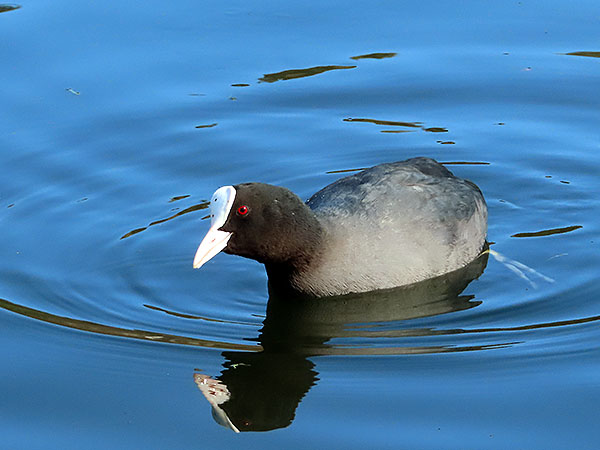
*********************
bearbeitet: 31.03.2021
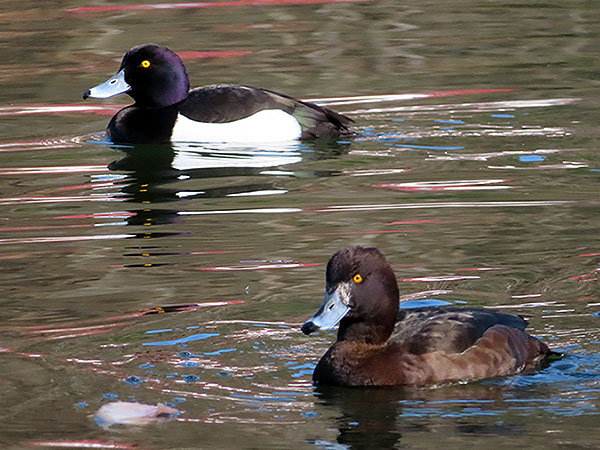
*********************
bearbeitet: 31.03.2021
Lady Tavistocks Sittich (Barnardius crommelinae Mathews)
Diese eigentlich vollkommen unbekannte ‘Art’ ist nur anhand eines einzigen Exemplars bekannt, eines Weibchens, das offenbar eine Zeitlang im Aviarium des Marquis of Tavistock in Gefangenschaft gehalten und nach dessen Frau benannt wurde. [1]
Es handelt sich hierbei offenbar um einen Barnardsittich (Barnardius barnardi (Vigors & Horsfield)) dem große Teile der gelben Areale fehlen. [2]
*********************
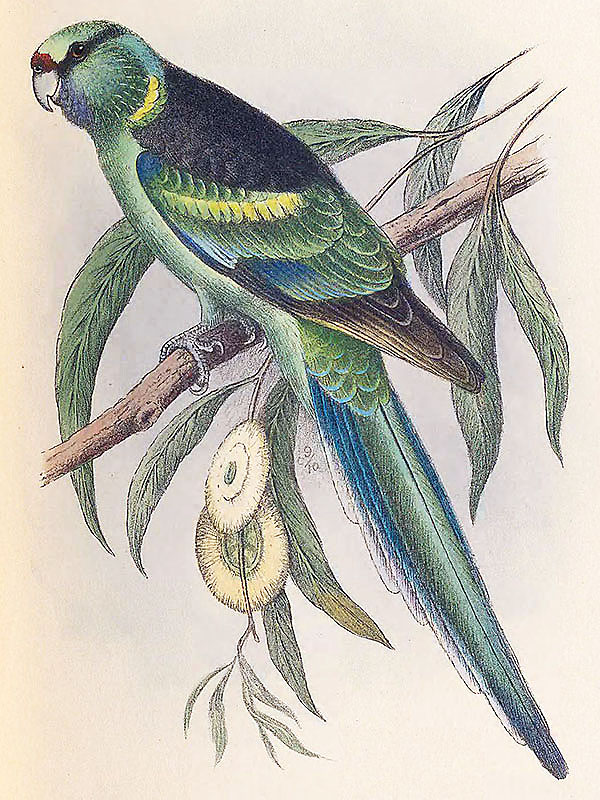
*********************
Quelle:
[1] Gregory M. Mathews: A new form of Barnardius. Bulletin of the British Ornithologists’ Club 46(299): 21. 1925
[2] Julian P. Hume: Extinct Birds. Bloomsbury Natural History; 2nd edition 2017
*********************
bearbeitet: 27.03.2021
Obskurer Papagei (Psittacus obscurus)
Der so genannte Obskure Papagei, der eigentlich besser Dunkler Papagei heißen sollte wurde ursprünglich im Jahr 1757 durch Fredric Hasselquist bzw. Carl von Linné beschrieben, dies ist die Beschreibung.:
“PSITTACUS (obscurus) niger, vertise cinereonigrescente vario, cauda cinerea.
CAPUT oblongum, lateribus compressum, dorso depressum, respectu corporis satis magnum.
Rostrum totum latum, crassum, obtusissimum, aduncum, capite triplo brevius. Maxilla superior subconvexa, inferius latiuscula, dorsum versus magis contracta, mobilis. Ad basin maxillae superioris infra nares sulcus conspieitur, quasi imbricata esset pergit. Apex maxillae superioris aduncus extra maxillam inferiorem, quo ad quartam sui partem extensus, extremitate obtusiusculus. Lobulus utrinque ad basin apicis, maxillae inferiori dum clauditur os, supra impositum, Maxilla inferior superiore crassior, magis comnvexa, brevior, quantitate apicis superioris, basi subtus gula distans, posterius aequalis; apice obtusa & fere emarginata; sinus semicircularis ad basin apicis. Nares proxime supra rostrum, perfecte circulares, magnitudine pennae gallinaceae.
Oculi vertici quam gulae, naribus etiam quam basi capitis propiores. Iris flava. Pupilla nigra. Area oculorum usque a fine maxillae superioris ad initium verticis latitudine, & a naribus, fere usque ad basin verticis longitudine nuda, rugosa, pilis vix conspicuis obsita.
Aurium apertura oblonga, transversalis, ab oculis aequali spatio, ut oculi a naribus, distans, basi capitis quam vertici multo propior, plumis tenuibus & membrana retractilis tecta.
Remiges circiter 20:1, 2 reliquis longiores; 3, 4, 5, paulo breviores, aequales; 6. 7. 8 ordine decrescentes; reliqui aequales breviores.
CAUDA cuneiformis. Rectrices circiter 10, laterales breviore intermedii longioribus.
PEDES, crura plumosa, usque ad flexuram tarsi.
Digiti 4: antici 2 & postici 2; ex anterioribus internus exteriori tribus articulis brevior est posterioribus, interior exteriori dimidio brevior; omnes digiti squamosi, squamis imbricatis, articulis duobus insimis impositis; reliqua pars pedis tuberculata, tuberculis levibus, circularibus, parum elevatis.
Lingua crassa, apice obtusissima & fere semicirculari, lateribus marginata, marginibus fursum inflexis, unde canaliculata evadit.
Ungues adungi, obtusiusculi.
COLOR: Rostrum nigrum. Area oculorum alba. Vertex ex cinereo & nigrescente variegatus. Colum & Alae supra nigra.
Abdomen & crura cinerea, cum lineis transversalibus canis. Tubercula pedum nigra. Ungues nigri. Cauda tota cinerea.
MAGNITUDO Graculi.” [1]
***
Ich muss gestehen, dass ich meine Übersetzungsversuche hier aufgegeben habe da sie nirgendwohin führten.
Wie dem auch sei, John Latham, der bekannte Autor vieler Vogelbücher des späten 18./frühen 19. Jahrhunderts, führt die Art im 2. Teil seines Werkes “A general history of birds”.:
“SIZE of a Jay. Bill black, the feathers round the base of it black, rough, and beset with hairs; space round the eye white; irides yellow; crown variegated cinereous and black; upper parts of the neck and wings black; belly and thighs cinereous, marked with transverse hoary lines; tail wholly ash-coloured, cuneiform; legs tuberculated, black; toes the same; claws crooked, and black.
Inhabits Africa. The only one who has described this is Hasselquist, from whom Linnaeus had his account; as to that which the latter refers in Brisson, it is quite a different species, and he mentions it as such in his last Mantissa.” [2]
Übersetzung:
“GRÖßE eines Hähers. Schnabel schwarz, die Federn rund um die Basis schwarz, rau und mit Haaren besetzt; Bereich um das Auge weiß; Iriden gelb; Scheitel grau und schwarz variegiert; obere Teile des Halses und Flügel schwarz; Bauch und Oberschenkel grau, markiert mit quer verlaufenden grauen Linien; Schwanz ganz aschfarben, keilförmig; Beine höckerig, schwarz; Zehen gleich; Krallen krumm und schwarz.
Bewohnt Afrika. Der Einzige, der ihn beschrieben hat, ist Hasselquist, von dem Linnaeus seinen Bericht hatte; worauf sich letzterer in Brisson bezieht, so handelt es sich um eine ganz andere Art, und er erwähnt sie in seiner letzten Mantisse als solche.“
***
Der Vogel wird Psittacus genannt und mag mit dem Graupapagei (Psittacus erithacus L.) und dem Timneh-Papagei (Psittacus timneh Fraser) verwandt gewesen sein; aber halt! Nahezu sämtliche Papageien wurden ursprünglich als Psittacus beschrieben, so dass dieser Name ebenfalls nirgendwo hinführt, es ist nicht einmal sicher, dass es sich hier überhaupt um einen Papagei handelt.
*********************
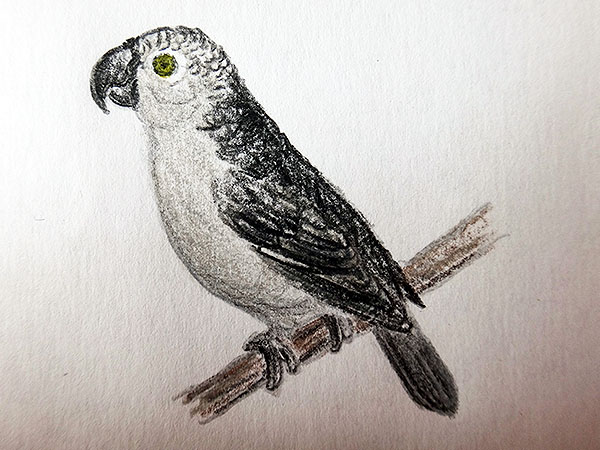
*********************
Quellen:
[1] Fredric Hasselquists: Iter Palæstinum, eller Resa til Heliga Landet, förrättad ifrån år 1749 til 1752, med beskrifningar, rön, anmärkningar, öfver de märkvärdigaste naturalier, på Hennes Kongl. Maj:ts befallning, utgiven af Carl Linnaeus. Stockholm: Trykt på L. Salvii kåstnad 1757
[2] John Latham: A general history of birds. Winchester: printed by Jacob and Johnson, for the author: — sold in London by G. and W. B. Whittaker, Ave-Maria-Lane; John Warren, Bond Street, W. Wood, 428, Strand; and J. Mawman, 39, Ludgate-Street 1821-1828
[3] Julian P. Hume: Extinct Birds. Bloomsbury Natural History; 2nd edition 2017
*********************
edited: 26.03.2021
Purpurnaschvogel (Chlorophanes purpurascens Sclater & Salvin)
Diese ‘Art’ wurde im Jahr 1873 beschrieben, es ist nur ein einziges Exemplar bekannt, welches offenbar irgendwo in Venezuela gefunden wurde; einer anderen Quelle zufolge in Trinidad. [1][2]
Es handelt sich hierbei tatsächlich um einen Hybriden mit dem Kappennaschvogel (Chlorophanes spiza (L.)) und dem Türkisnaschvogel (Cyanerpes cyaneus (L.)) als Elternarten. [2]
*********************
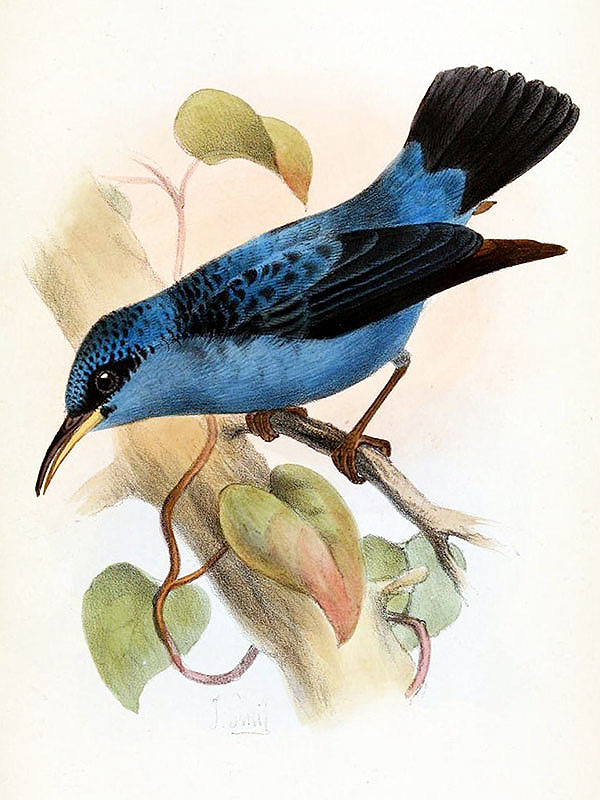
*********************
bearbeitet: 25.03.2021
*********************
Quellen:
[1] Philip Lutley Sclater: Catalogue of the Passeriformes, or perching birds, in the collection of the British Museum. Fringilliformes: part II; containing the families Coerebidae, Tanagridae, and Icteridae. London 1886
[2] Julian P. Hume: Extinct Birds. Bloomsbury Natural History; 2nd edition 2017
Mähnenparadiesvogel (kein wissenschaftlicher Name)
“LENGTH ten inches. Bill one inch and a quarter long, a trifle bent, and dusky, the base surrounded with velvet-like black feathers, covering the nostrils; top of the head, even with the eye, and to the beginning of the back, deep green, varying to bright green in some lights; the feathers of a plush-like texture; those on the hind part of the neck are long, pointed, and like hackles, but on the chin and throat they are similar to those on the crown, and both appear, in some lights, to be scaly, either indigo or green, and glossy, like metal; on each side of the neck is a stripe of blue, dividing the green above and below, and coming forwards to the breast, where it occupies a broad space; on the middle of the crown arise four bristles, near two inches long, tending backwards; upper part of the back, and wings, greenish black, in some lights appearing quite black; from the breast to the vent deep, dull ash-colour; tail even at the end, and three inches in length, the two middle feathers dull green, pointed at the tips; the others dusky within, and green on the outer webs, and all of them curve a little outwards; legs scaly; claws black, and hooked, though not very stout.
Native place uncertain; in the collection of General Davies.” [1]
Übersetzung:
“LÄNGE zehn Zoll [ca. 25,5 cm]. Schnabel einen Zoll und ein Viertel lang, eine Kleinigkeit gebogen und düster, die Basis von samtartigen schwarzen Federn umgeben, die die Nasenlöcher bedecken; Oberseite des Kopfes, in Augenhöhe, und bis zum Anfang des Rückens, tiefgrün, in bestimmtem Licht bis hellgrün variierend; die Federn von einer plüschartigen Textur; die am hinteren Teil des Halses sind lang, spitz und wie eine Mähne, aber am Kinn und am Hals ähneln sie denen auf dem Scheitel, und beide erscheinen in bestimmtem Licht schuppig, entweder Indigo oder Grün, und glänzend wie Metall; Auf jeder Seite des Halses befindet sich ein blauer Streifen, der das Grün oben und unten teilt und nach vorne zur Brust kommt, wo er einen weiten Raum einnimmt; in der Mitte des Scheitels stehen vier Borsten, die fast zwei Zoll lang sind und nach hinten tendieren; oberer Teil des Rückens und Flügel, grünlich schwarz, in bestimmtem Licht, ziemlich schwarz erscheinend; von der Brust bis zum Rumpf tief, matt aschefarben; Schwanz gerade am Ende und drei Zoll lang, die beiden mittleren Federn mattgrün, spitz; die anderen sind innen dunkel und auf den Außenfahnen grün, und alle krümmen sich ein wenig nach außen; Beine beschuppt; Krallen schwarz und gebogen, wenn auch nicht sehr kräftig.
Heimatort ungewiss; in der Sammlung von General Davies.”
***
Ich muss gestehen, dass ich keinerlei Ahnung habe womit wir es hier zu tun haben könnten, es könnte sich tatsächlich um einen Paradiesvogel(hybriden) handeln oder aber auch um einen vollkommen anderen Vogel, z. B. eine Starenart; am wahrscheinlichsten aber haben wir es hier mit einem der damals offenbar gar nicht so selten anzutreffenden Fälschungen zu tun, die aus allerlei Vogelteilen zusammengebaut und an den meistbietenden Kuriositätensammler verschachert wurden.
*********************

*********************
Quelle:
[1] John Latham: A general history of birds. Winchester: printed by Jacob and Johnson, for the author: — sold in London by G. and W. B. Whittaker, Ave-Maria-Lane; John Warren, Bond-Street, W. Wood, 428; and J. Mawman, 39, Ludgate-Street 1821-1828
*********************
bearbeitet: 25.03.2021
Schöner Hartschnabel (Sparactes superbus (Shaw))
“Von der Größe einer Drossel; der ganze obere Theil des Körpers schwarz, mit Ausnahme des Bürzels und der obern Deckfedern des Schwanzes, welche gelbgrünlich sind. Auf dem Kopfe steht ein vier Zoll langer Federbush aus zerschlissenen Federn bestehend, welche gegen den Schnabel gekehrt sind; die Kehle ist mit steifen Borsten besezt und lebhaft roth, mit einigen gelblichen Flecken nach unten; Brust und Bauch schwarz; über die Brust läuft ein Gürtel von lebhaftem Gelb, mit rothen Streifen, und an den Seiten mit schwarzen Punkten; der Schnabel ist eisengrau, die Füße blaulich und die Nägel schwarz.
Das Vaterland dieses Vogels ist unbekannt, das einzig vorhandene Exemplar wurde von Vaillant beschrieben und bekannt gemacht. Man will aber entdeckt haben, daß es ein künstlich zusammengesetzter Vogel sey, womit dann freilich diese Gattung ganz wegfallen würde.” [1]
***
Wie so viele nicht näher miteinander verwandte Vogelformen wurde auch diese zuerst einmal als eine Art Würger (Laniidae) beschrieben später aber unter anderem den Kuckucksvögeln (Cuculidae) zugeordnet, vielleicht aufgrund der zygodactylen Füße, die in den mir bekannten Abbildungen aber anisodactyl dargestellt wurden.
Bereits zu Beginn das 19. Jahrhunderts wurde dieser Vogel als eine Fälschung erkannt, vermutlich diente ein Senegal-Furchenschnabel (Lybius dubius (Gmelin)) als Ausgangsmaterial, ein Vogel also, der, obwohl er tatsächlich existiert, eigentlich schon absonderlich und unecht genug wirkt.
*********************
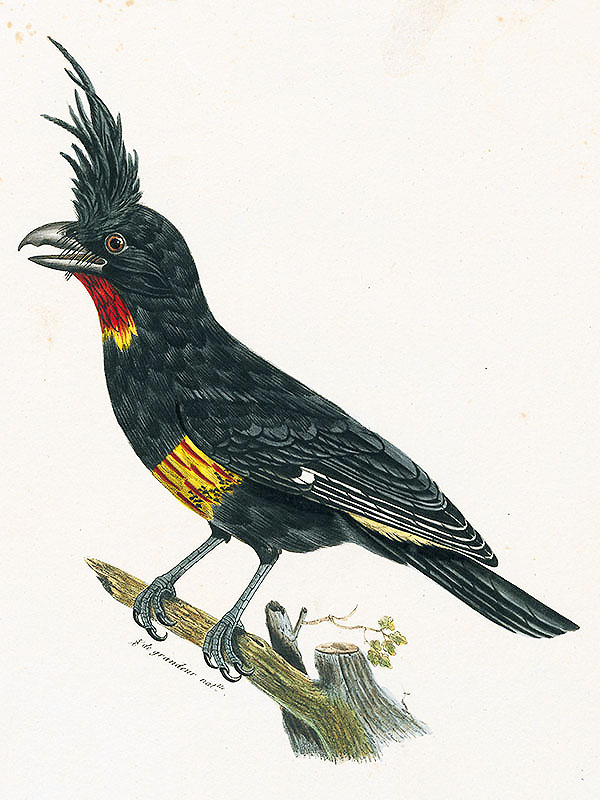
***
Witzigerweise findet die hier gezeigte Abbildung auch auf der Wikipedia-Seite über den Braun-Haubendickkopf (Ornorectes cristatus (Salvadori)) Verwendung, einer Vogelart, die tatsächlich existiert und vollkommen anders aussieht.
*********************
Quelle:
[1] H. R. Schinz; Joseph Brodtmann: Naturgeschichte und Abbildungen der Vögel: nach den neuesten Systemen bearbeitet. Leipzig: Weidmann’sche Buchhandlung 1836
*********************
bearbeitet: 23.03.2021
Karmesintaube (Columba rosea Miller & Shaw)
“Unter all dem schönen Hausgeflügel, welches uns Indien geliefert hat, ist die köstliche Karmesintaube gewiss der prächtigste Vogel. Sie ist eine Haustaube, und ohngefähr so gross wie die unsrigen. Ihr Gefieder ist hauptsächlich ein glänzendes Karmesin, welches sich an mehreren Stellen in ein schönes Rosenroth verläuft. Die Kehle, Scheitel, Augenkreise und Spitzen der Flügelfedern sind weiss, die Schwung- und Schwanzfedern aber braun. Die Ostindier halten diese prächtige Taube häufig für ihre schönen Hühnerhöfe.“
Dieser Text stammt aus einem Kinderbuch und behandelt eine der eigenartigsten mysteriösen Vogelformen überhaupt; tatsächlich taucht ihr Name immer einmal wieder in Auflistungen ausgestorbener Vogelarten auf – trotzdem hat sie jedoch wohl nie existiert.
Im 18. Jahrhundert war es keinesfalls selten in diversen wissenschaftlichen Schriften, und zwar nicht nur solchen für Kinder, allerlei ausgedachtes, mehr oder weniger fantastisch anmutendes unterzubringen um die geneigte Leserschaft angemessen zu unterhalten, darunter eben auch komplett ausgedachte Tierarten.
*********************

*********************
Quellen:
[1] F. J. Bertuch: Bilderbuch Für Kinder: enthaltend eine angenehme Sammlung von Thieren, Pflanzen, Blumen, Früchten, Mineralien, Trachten und allerhand andern unterrichtenden Gegenständen aus dem Reiche der Natur, der Künste und Wissenschaften; alle nach den besten Originalen gewählt, gestochen, und mit einer kurzen wissenschaftlichen, und den Verstandes-Kräften eines Kindes angemessenen Erklärung begleitet. Weimar, im Verlage des Industrie-Comptoirs 1802
[2] Pauline Knip: Les pigeons, par Madame Knip, née Pauline de Courcelles, le texte par C. J. Themminck. Paris: chez Mme. Knip 1838-1843
[3] Julian P. Hume: Extinct Birds. Bloomsbury Natural History; 2nd edition 2017
*********************
bearbeitet: 22.03.2021
San Domingo-Taube (Columba dominicensis Latham)
“Cette jolie espèce, dont Buffon a donné le premier une figure très exacte, habite, avec l’espèce du précédent article, les contrées méridionales du nouveau continent. Nous ne connoissons de cette Colombe que l’extérieur, dont nous donnerons une description succincte. La longueur totale de la Colombe à Moustache est de onze pouces; la queue est moins longue que dans les espèces dont nous venons de parler; elle est cependant à pennes d’inégale longueur, et présente la forme d’un cône. Le front et la région des yeux sont blancs; la gorge l’est aussi. Cette couleur se dirige sur une partie des côtés du cou, et se joint sur la nuque. Sur le haut de la tête est une large bande transversale noire, qui semble la partager en deux parties. De la base du bec se dirige, en passant sous les yeux, une moustache noire qui s’élargit vers son extrémité, et dont les plumes recouvrent l’orifice des oreilles: un large collier noir entoure le cou vers le milieu de sa longueur. La poitrine est de couleur vineuse; mais vers les parties latérales il y a des plumes pourprées à reflets métalliques: toutes les parties supérieures sont d’un brun-terreux. Sur les plumes scapulaires et les grandes couvertures sont quelques taches noires. Les rémiges sont noirâtres, bordées extérieurement de gris-blanc. Le ventre est brun-cendré; les pennes de la queue sont grises; toutes, excepté les deux du milieu, ont leur extrémité blanche: le bec est noir, et les pieds sont rougeâtres.
On trouve l’espèce à Saint-Domingue, et probablement aussi dans les autres parties de l’Amérique méridionale situées sous le même degré. Nous présumons que l’individu figuré par nous à cet article est le mâle de l’espèce: nous ne saurions cependant raffirmer. Le seul individu que nous ayons eu occasion de voir faisoit autrefois partie du Muséum Leverian, à Londres.” [1]
Übersetzung:
“Diese hübsche Art, von der Buffon als erster eine sehr genaue Abbildung lieferte, lebt zusammen mit der Art im vorherigen Artikel in den südlichen Regionen des neuen Kontinents. Wir kennen von dieser Taube nur das Äußere, von dem wir eine kurze Beschreibung geben werden. Die Gesamtlänge der Schnurrbarttaube beträgt elf Zoll [ca. 28 cm];der Schwanz ist kürzer als bei der gerade erwähnten Art; er besitzt jedoch Federn von ungleicher Länge und hat die Form eines Kegels. Stirn und Augenpartie sind weiß; der Hals auch. Diese Farbe verläuft an einem Teil der Seiten des Halses und verbindet sich im Nacken. Auf der Oberseite des Kopfes befindet sich ein breites schwarzes Querband, das ihn in zwei Teile zu teilen scheint. Von der Basis des Schnabels verläuft unter den Augen ein schwarzer Schnurrbart, der sich zum Ende hin erweitert und dessen Federn die Öffnung der Ohren bedecken: Ein großer schwarzer Kragen umgibt den Hals zur Mitte seiner Länge. Die Brust hat eine weinrote Farbe; aber zu den Seiten hin gibt es lila Federn mit metallischem Schimmer: Alle oberen Teile sind erdbraun. Auf den Schulter- und den größeren Flügeldecken befinden sich einige schwarze Flecken. Die Flugfedern sind schwärzlich und außen grauweiß eingefasst. Der Bauch ist aschbraun, die Schwanzfedern sind grau; Alle außer den beiden in der Mitte haben weiße Spitzen: Der Schnabel ist schwarz und die Füße rötlich.
Die Art kommt in Santo Domingo [Haiti/Hispaniola] und wahrscheinlich auch in anderen Teilen Südamerikas unter dem gleichen Grad vor. Wir gehen davon aus, dass das von uns in diesem Artikel vorgestellte Individuum das Männchen der Art ist. Dies können wir jedoch nicht bestätigen. Das einzige Individuum, das wir sehen konnten, war früher Teil des Leverian Museum in London.“
***
Diese ‘Art’ ist ursprünglich anhand einer Darstellung aus dem Jahr 1771bekannt, die dann wiederum als Vorlage für eine Beschreibung durch John Latham im Jahr 1790 diente und eben offenbar auch der oben wiedergegebenen aus dem 19. Jahrhundert. [2]
Interessant finde ich allerdings die Aussage der Autoren (Temminck und Knip) ein Exemplar gesehen haben zu wollen, das vormals Bestandteil der ehemaligen Leverianischen Sammlung in Leicester House in Westminster, London gewesen sein soll; außerdem fällt beim Lesen der Beschreibung auf, dass sie nicht so ganz zu der dazugehörigen Darstellung passen möchte.
*********************
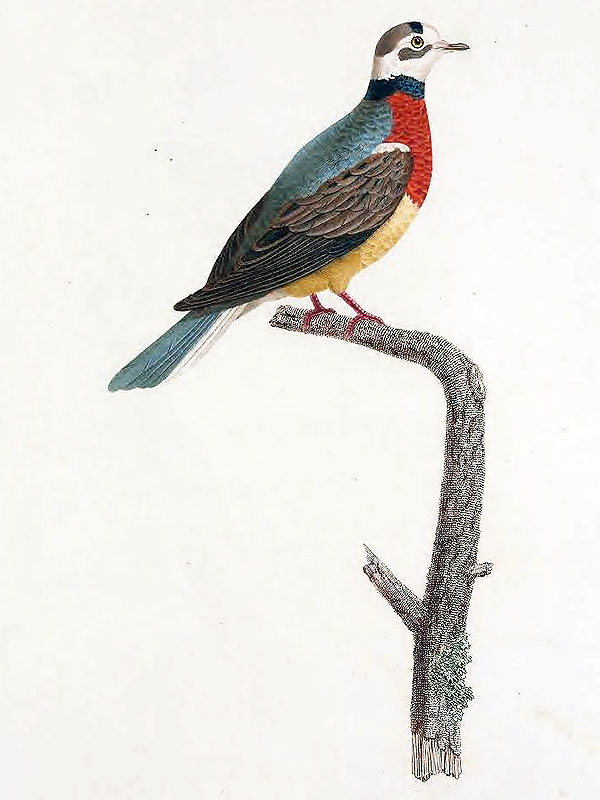
*********************
Quellen:
[1] Pauline Knip: Les pigeons, par Madame Knip, née Pauline de Courcelles, le texte par C. J. Themminck. Paris: chez Mme. Knip 1838-1843
[2] Julian P. Hume: Extinct Birds. Bloomsbury Natural History; 2nd edition 2017
*********************
bearbeitet: 22.03.2021
Azurtaube (Columba dorsocaerulea Temminck & Knip)
“Toutes les parties supérieures de cette jolie Colombe étant d’une brillante et vive couleur d’azur, nous en avons tiré son signalement spécifique. On nous a assuré que l’espèce habite au Bengale; ce dont nous ne saurions cependant garantir l’authenticité.
La longueur totale de la Colombe azurée est de neuf pouces; ses ailes atteignent à la moitié de la longueur de la queue, qui est arrondie.
Un bleu céleste ou couleur de turquoise orientale est répandu sur les parties supérieures; les joues et la gorge sont d’un blanc pur. On remarque sur le devant du cou et de la poitrine des teintes d’un brun fauve, nuancé d’un ton vineux; le ventre et l’abdomen sont blanchâtres; les pieds et le cercle nu qui enture les yeux sont rouges; la base du bec est rougèatre, mais la ointe est d’un blanc jaunâtre.
Un individu de cette belle espèce faisoit partie du cabinet de M. Holthuysen, à Amsterdam.” [1]
Übersetzung:
“Alle oberen Teile dieser hübschen Taube haben eine brillante und lebendige azurblaue Farbe, wir haben daraus ihre spezifische Beschreibung gezogen. Uns wurde versichert, dass die Art in Bengalen lebt, wir können jedoch die Echtheit nicht garantieren.
Die Gesamtlänge der Azurtaube beträgt 9 Zoll [ca. 23 cm]; ihre Flügel erreichen die halbe Länge des Schwanzes, der abgerundet ist.
Ein himmlisches Blau oder orientalisches Türkis ist auf den oberen Teilen verteilt; die Wangen und der Hals sind rein weiß. Man bemerkt auf der Vorderseite des Halses und auf der Brust ein Rehbraun, nuanciert mit einem weinroten Ton; die Brust und der Bauch sind weißlich; die Füße und der nackte Ring um die Augen sind rot; die Basis des Schnabels ist rötlich, aber die Schnabelspitze ist gelblich weiß.
Ein Individuum dieser schönen Art befand sich im Kabinett von Herrn Holthuysen in Amsterdam.“
Ich kann nicht wirklich sagen, was ich mit diesem Vogel anfangen soll, mit ziemlicher Sicherheit stammt er nicht aus Bengalen (im Nordosten Indiens) und mit ebenso ziemlicher Sicherheit handelt es sich bei dem (einzigen existierenden?) Exemplar im Kabinett des Herrn Holthuysen in Amsterdam um eine der damals nicht unüblichen gefälschten Stopfpräparate, die, wenn sie besonders gelungen waren, für durchaus nicht wenig Geld an interessierte Sammler seltener Schätze gebracht wurden.
Doch, da jenes Originalexemplar nicht mehr existiert, handelte es sich hierbei um eine gewöhnliche, eingefärbte Taube oder um einen vollkommen anderen Vogel, dem ein Taubenköpfchen aufgesetzt wurde? Dies werden wir wahrscheinlich nie erfahren.
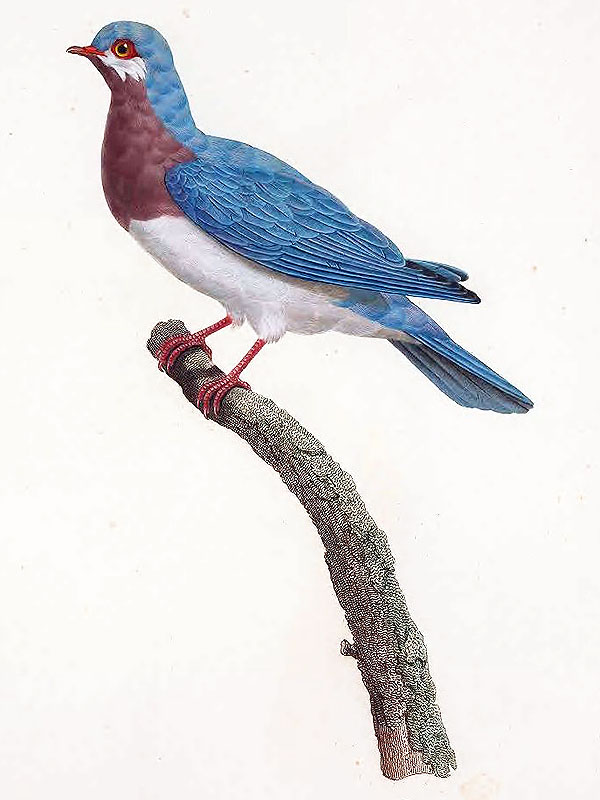
Es existieren auch Versionen dieses Gemäldes auf denen die weinroten Gefiederbereiche komplett grau und die Beine sehr blass, fast weißlich gefärbt sind.
*********************
Quelle:
[1] Pauline Knip: Les pigeons, par Madame Knip, née Pauline de Courcelles, le texte par C. J. Themminck. Paris: chez Mme. Knip 1838-1843
*********************
bearbeitet: 21.03.2021
Nauru-Ralle (Gallirallus sp.)
Nauru; die gesamte Insel war einst mit einem Substrat bedeckt, das zu großen Teilen aus Guano bestand, und vollkommen bewaldet.
Heute sieht sie so aus, eine raue und trostlose Karstlandschaft, die nicht natürlichen Ursprungs ist sondern menschgemacht.:
*********************
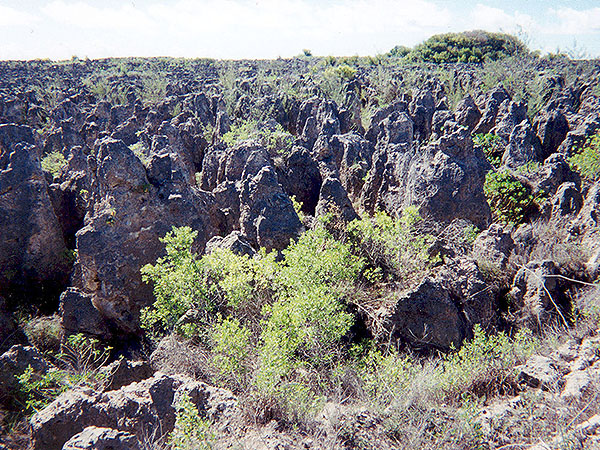
***
“Es gibt auch Vögel auf Nauru, wie Fregattvogel, schwarze Seeschwalbe, weiße Seeschwalbe, Regenpfeifer, Brachvogel, Möve, Schnepfe, Uferläufer, Ralle, Lachmöve und Rohrdrossel.” [1]
“Die Vogelwelt ist nach Zahl und Art reicher. Der Fregattvogel (Tachypetes aquila), itsi, die schwarze Seeschwalbe (Anous), doror, die weiße Seeschwalbe (Gygis), dagiagia, werden als Haustiere gehalten; der erste galt früher als heiliger Vogel, mit den beiden anderen werden Kampfspiele veranstaltet. Am Strande trifft man den Steinwälzer (Strepsilas interpres), dagiduba, den Regenpfeifer (Numenius), den Uferläufer (Tringoides), ibibito, die Schnepfe, ikirer, den Brachvogel ikiuoi, den Strandreiter iuji, die Ralle, earero bauo und zwei Möwenarten (Sterna), igogora und ederakui. Im Busche beobachtet man an den Blüten der Kokospalme den kleinen Honigsauger raigide, die Rohrdrossel (Calamoherpe syrinx), itirir und den Fliegenschnäpper (Rhipidura), temarubi.” [1]
***
Diese beiden knappen Aufzählungen sind alles was von der ehemaligen Existenz einer Rallenart auf der Insel Nauru kündigt, und offiziell wird dieser Bericht denn auch als nicht vertrauenswürdig abgetan [3], dabei ist gerade das ehemalige Vorkommen einer Rallenart auf Nauru geradezu zweifelsfrei sicher.
Die Familie der Rallen ist führend im Besiedeln selbst der entlegensten Inseln, und anhand von archäologischen und paläontologischen Ausgrabungen ist heute bekannt, dass es innerhalb von Mikronesien weitaus mehr Rallenarten gab als die wenigen, die bis ins 20. Jahrhundert überlebt haben (in der Gattung Gallirallus sind dies genau zwei, die Guam-Ralle (Gallirallus owstoni (Rothschild)) und die Wake-Ralle (Gallirallus wakensis (Rothschild))). [2]
Das Vorkommen einer solchen endemischen Form auf Nauru ist daher geradezu absolut sicher.
*********************
Quellen:
[1] Paul Hambruch: Nauru. Ergebnisse der Südsee-Expedition 1908-1910. II. Ethnographie: B. Mikronesien, Band 1.1 Halbband. Hamburg, Friedrichsen 1914
[2] David W. Steadman: Extinction and Biogeography of Tropical Pacific Birds. University of Chicago Press 2006
[3] Donald W. Buden: The birds of Nauru. Notornis 55: 8-19. 2008
*********************
bearbeitet: 20.03.2021
Nauru-Fächerschwanz (Rhipidura sp.)
Mikronesien beherbergt heute noch drei Arten von Fächerschwänzen, den Pohnpei-Fächerschwanz (Rhipidura kubaryi Finsch), den Palau-Fächerschwanz (Rhipidura lepida Hartlaub & Finsch) sowie den Fuchsfächerschwanz (Rhipidura rufifrons (Latham)), der mit einigen Unterarten die Marianen bewohnt.
Es mag vormals durchaus mehr Formen gegeben haben ….
Der einzige Hinweis auf des ehemalige Vorkommen einer Fächerschwanzart auf der isolierten Insel Nauru ist der Bericht des Ethnologen Paul Hambruch aus dem Jahr 1910, der wiederum Erzählungen aufgeschrieben hat, die ihm von einem Einheimischen der Insel erzählt wurden.:
“Die Vogelwelt ist nach Zahl und Art reicher. Der Fregattvogel (Tachypetes aquila), itsi, die schwarze Seeschwalbe (Anous), doror, die weiße Seeschwalbe (Gygis), dagiagia, werden als Haustiere gehalten; der erste galt früher als heiliger Vogel, mit den beiden anderen werden Kampfspiele veranstaltet. Am Strande trifft man den Steinwälzer (Strepsilas interpres), dagiduba, den Regenpfeifer (Numenius), den Uferläufer (Tringoides), ibibito, die Schnepfe, ikirer, den Brachvogel ikiuoi, den Strandreiter iuji, die Ralle, earero bauo und zwei Möwenarten (Sterna), igogora und ederakui. Im Busche beobachtet man an den Blüten der Kokospalme den kleinen Honigsauger raigide, die Rohrdrossel (Calamoherpe syrinx), itirir und den Fliegenschnäpper (Rhipidura), temarubi.” [1]
***
Dieser Bericht wird offiziell als unwahrscheinlich abgelehnt [3], was ich persönlich nicht verstehe, denn er erscheint mir durchaus zuverlässig, selbst wenn es die dort aufgezählten Vögel zu der Zeit bereits nicht mehr gegeben haben sollte, so können die Überlieferungen durchaus länger überdauert haben.
Das Foto zeigt den Pohnpei-Fächerschwanz von der gleichnamigen Insel.
***
Es ist erstaunlich, dass auch die Inseln Chuuk und Yap offenbar keine einheimischen Fächerschwanzarten beherbergen – hier geht man für gewöhnlich oft davon aus, dass es solche Arten durchaus vormals gegeben haben dürfte, dass sie aber schon bald nach der Besiedlung durch Menschen ausgestorben sind. [2]
*********************
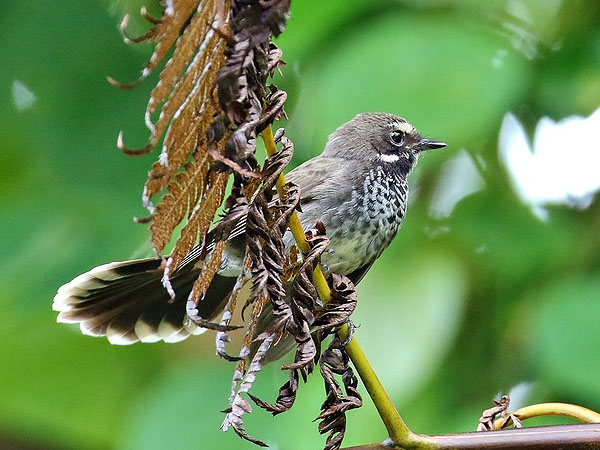
*********************
Quellen:
[1] Paul Hambruch: Nauru. Ergebnisse der Südsee-Expedition 1908-1910. II. Ethnographie: B. Mikronesien, Band 1.1 Halbband. Hamburg, Friedrichsen 1914
[2] David W. Steadman: Extinction and Biogeography of Tropical Pacific Birds. University of Chicago Press 2006
[3] Donald W. Buden: The birds of Nauru. Notornis 55: 8-19. 2008
*********************
bearbeitet: 20.03.2021
Nauru-Honigfresser (Myzomela sp.)
Diese Art (oder Unterart) mag auf der Insel Nauru vorgekommen sein, sie wird allerdings offenbar in nur einem einzigen Bericht erwähnt, und dabei handelt es sich um Erzählungen aus zweiter Hand.
Paul Hambruch, der Enthnologe der zu Beginn des 20. Jahrhunderts das Leben der Einwohner der Insel Nauru erforschte erwähnt in seinem Bericht Geschichten, die ihm von einem Einheimischen namens Auuiyeda erzählt wurden und in denen unter anderem auch von den einheimischen Vögeln die Rede ist.:
“Die Vogelwelt ist nach Zahl und Art reicher. Der Fregattvogel (Tachypetes aquila), itsi, die schwarze Seeschwalbe (Anous), doror, die weiße Seeschwalbe (Gygis), dagiagia, werden als Haustiere gehalten; der erste galt früher als heiliger Vogel, mit den beiden anderen werden Kampfspiele veranstaltet. Am Strande trifft man den Steinwälzer (Strepsilas interpres), dagiduba, den Regenpfeifer (Numenius), den Uferläufer (Tringoides), ibibito, die Schnepfe, ikirer, den Brachvogel ikiuoi, den Strandreiter iuji, die Ralle, earero bauo und zwei Möwenarten (Sterna), igogora und ederakui. Im Busche beobachtet man an den Blüten der Kokospalme den kleinen Honigsauger raigide, die Rohrdrossel (Calamoherpe syrinx), itirir und den Fliegenschnäpper (Rhipidura), temarubi.” [1]
***
Seltsamerweise gilt der Bericht als unglaubwürdig [2], was ich persönlich überhaupt nicht verstehe, denn die drei hier genannten Vogelformen (eine Ralle, ein Honigfresser und ein Fächerschwanz) sind sehr wohl aus Mikronesien bekannt und kommen bzw. kamen auf etlichen der Inseln vor.
Im Falle dieses Honigfressers mag es sich, der doch recht isolierten Lage Naurus entsprechend, um eine eigenständige Art gehandelt haben oder aber um eine Unterart des Mikronesischen Honigfressers (Myzomela rubratra (Lesson)) (siehe Foto), der in Mikronesien mit vier Unterarten verbreitet und dort eigentlich auch überall recht häufig ist.
Der Nauru-Honigfresser verschwand vermutlich aufgrund von Bejagung (der roten Federn wegen aber auch weil diese Vögel in ihrer Heimat als Delikatesse gelten) sowie in Folge der nahezu kompletten Zerstörung der Vegetation durch den massiven Guano/Phosphat-Abbau, der auf Nauru stattfand.
*********************
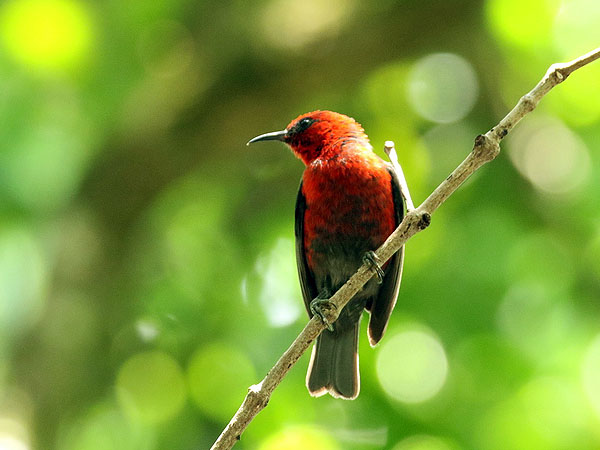
*********************
Quellen:
[1] Paul Hambruch: Nauru. Ergebnisse der Südsee-Expedition 1908-1910. II. Ethnographie: B. Mikronesien, Band 1.1 Halbband. Hamburg, Friedrichsen 1914
[2] Donald W. Buden: The birds of Nauru. Notornis 55: 8-19. 2008
*********************
bearbeitet: 20.03.2021
Wilhelmina-Paradiesvogel (Lamprothorax wilhelminae Meyer)
Der Wilhelmina-Paradiesvogel ist eine jener Paradiesvogel’arten’, die nach einem Mitglied eines der zahlreichen europäischen Königshäuser benannt wurde – in diesem Fall war dies die damalige niederländische Königin (Wilhelmina Helena Pauline Maria von Oranien-Nassau (Königin Wilhelmina 1880-1962)).
Die ‘Art’ ist nur anhand von drei (männlichen) Exemplaren bekannt, und es ist diese Tatsache, dass nahezu alle jene ‘lost birds of paradise’ [1] nur anhand männlicher Exemplare bekannt sind, die einem zu denken geben sollte. Würde es sich tatsächlich um heute ausgestorbene Arten handeln, so wären sicher einige dazugehörigen Weibchen gefunden wurden, dem ist aber nicht so, in keinem einzigen Fall! (… in den beiden Fällen in denen eine solche Form anhand eines Weibchens bekannt ist, fehlen wiederum die passenden Männchen ….)
***
Es handelt sich auch hier um eine Hybridform, und zwar mit dem Sichelschwanz-Paradiesvogel (Cicinnurus magnificus (J. R. Forst.)) und dem Kragenparadiesvogel (Lophorina superba J. R. Forst) als Elternarten. [2]
*********************
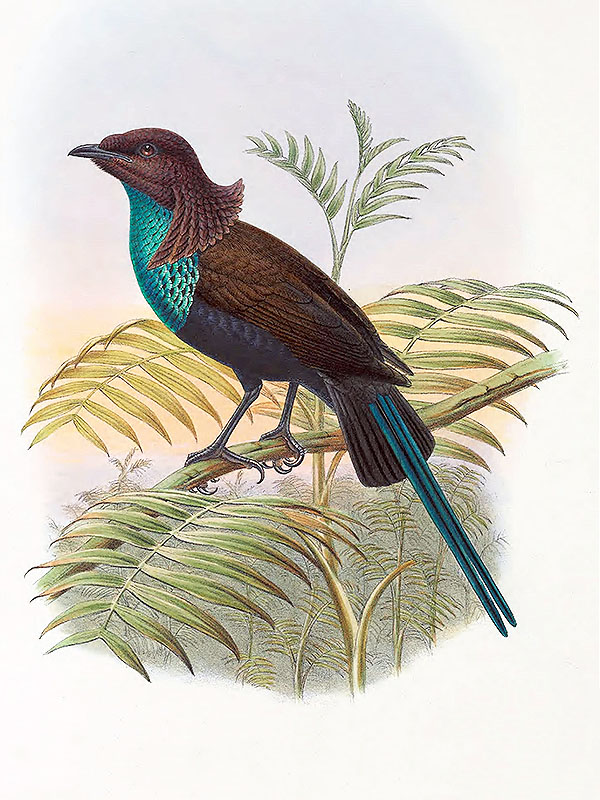
*********************
Quellen:
[1] Errol Fuller: The Lost Birds of Paradise. Airlife 1996
[2] Clifford B. Frith; Bruce M. Beehler: The Birds of Paradise: Paradisaeidae. Oxford University Press 1998
*********************
bearbeitet: 20.03.2021
Rothschilds Lappenschnabel-Paradiesvogel (Loboramphus nobilis Rothschild)
Dieser außerordentlich schöne Vogel wurde im Jahre 1901 als eigenständige Art beschrieben, nur ein einziges Exemplar ist bekannt.
Es handelt sich wohl um eine der außergewöhnlichsten Hybriden überhaupt, eine Kreuzung zweier ungemein unterschiedlicher Arten, nämlich dem Kragenparadiesvogel (Lophorina superba J. R. Forst) und der Langschwanz-Paradigalla (Paradigalla carunculata Lesson); dies ist jedoch nicht hundertprozentig klar. [1]
Einige Ornithologen halten diese Form nach wie vor für eine eigenständige, heute ausgestorbene Art.
*********************

*********************
Quelle:
[1] Clifford B. Frith; Bruce M. Beehler: The Birds of Paradise: Paradisaeidae. Oxford University Press 1998
*********************
bearbeitet: 20.03.2021
Wundervoller Paradiesvogel (Paradisaea mirabilis Reichenow)
Der Wundervolle Paradiesvogel, der ‘Wonderful Bird of Paradise’, ist anhand von ganzen fünf (männlichen) Exemplaren bekannt, es handelt sich hierbei um die ziemlich unwahrscheinliche und trotzdem geschehene Kreuzung zwischen dem Kleinen Paradiesvogel (Paradisaea minor Shaw) und dem Fadenhopf (Seleucidis melanoleuca (Daudin)).
Diese beiden durchaus unterschiedlich aussehenden Arten, ja Gattungen, haben einen prachtvollen Mix aus beiden Elternteilen hervorgebracht, dem die hier gezeigte Darstellung nicht ansatzweise gerecht wird.
*********************

*********************
Quelle:
[1] Clifford B. Frith; Bruce M. Beehler: The Birds of Paradise: Paradisaeidae. Oxford University Press 1998
*********************
bearbeitet: 14.03.2021
Waigiou-Paradiesvogel (Diphyllodes gulielmi III Meyer)
Der Waigiou-Paradiesvogel, sicher besser bekannt unter dem englischen Namen ‘King of Holland’s Bird of Paradise’, ist eine der am häufigsten auftauchenden Hybridformen innerhalb der Familie.
Es war im 19. Jahrhundert Mode neu entdeckte Paradiesvögel nach Mitgliedern diverser europäischer Königshäuser zu benennen, so wurde diese Form nach dem damaligen holländischen König (Wilhelm Alexander Paul Friedrich Ludwig von Oranien-Nassau (König Wilhelm III 1817-1890)) benannt.
Es handelt sich hierbei um eine offenbar häufiger auftretende Kreuzung der äußerlich so verschiedenen und doch nah verwandten Arten Sichelschwanz-Paradiesvogel (Cicinnurus magnificus (J. R. Forst.)) und Königsparadiesvogel (Cicinnurus regius (L.)), offenbar mit anschließender Rückkreuzung mit der ersteren Art.
***
Im Gegensatz zu den meisten anderen Paradiesvogelhybriden kann man diesem hier die beiden Elternarten sehr gut ansehen.
*********************
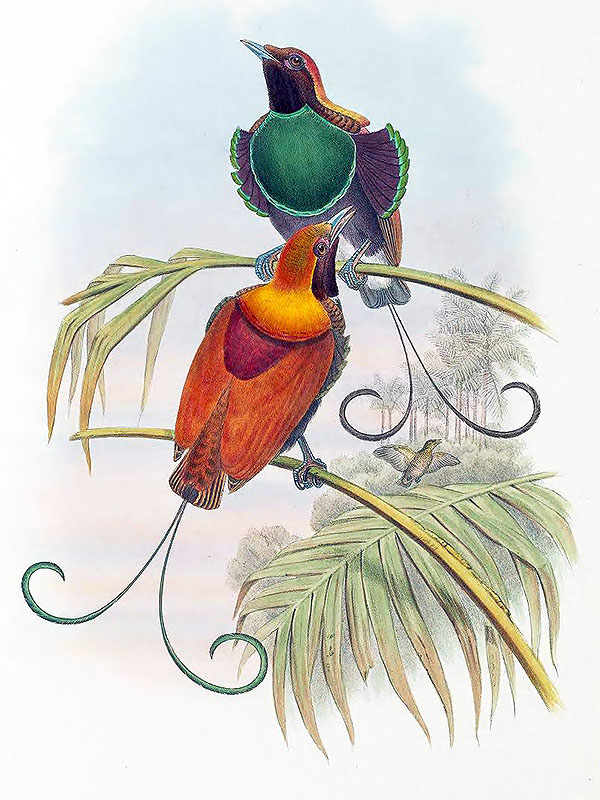
*********************
Quellen:
[1] Clifford B. Frith; Bruce M. Beehler: The Birds of Paradise: Paradisaeidae. Oxford University Press 1998
*********************
bearbeitet: 14.03.2021

********************
bearbeitet: 14.03.2021
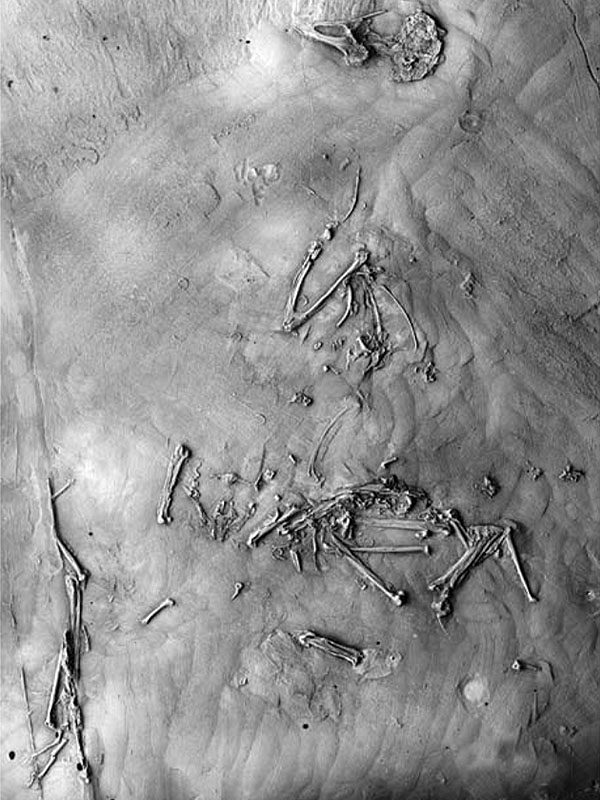

*********************
bearbeitet: 20.01.2021
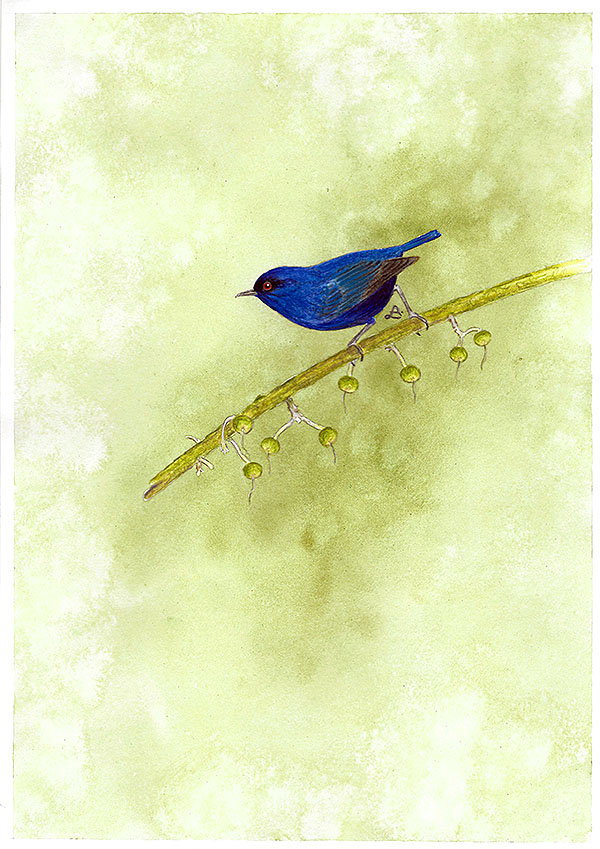
*********************
bearbeitet: 13.01.2021
The Black-headed Bulbul is a typical representative of the bulbuls; it comes from Southeast Asia, where it occurs with four subspecies from northeast India, Malaysia and Thailand to Borneo, Java, and Sumatra in Indonesia.
The species reaches a size of about 17 cm.
The picture shows the nominate form, which is widespread on the Southeast Asian mainland, there are three color morphs, in addition to the most common one shown here, there is one in which the yellow and green are completely replaced by gray and one with a gray basic coloration in which at least the wings are colored yellow.
*********************

*********************
edited: 20.07.2023
Ich habe hier ja schon mehrfach über oligozäne Vögel mit offenbar brüchigen Gliedmaßen gesprochen ….
Dieser hier ist ein winziges Fossil, bestehend aus einer Platte und deren Gegenplatte (Positivplatte und Negativplatte?), und besteht aus einem einzelnen Fuß, einem ca. 3,6 cm langen, rechten Fuß, an dem obendrein auch nur der erste und der zweite Zeh erhalten geblieben sind.
Dieser Teilfuß wurde mit diversen anderen Vogelformen verglichen und weist die größten Übereinstimmungen mit den Taubenvögeln (Columbiformes) auf, so dass es sich hierbei eventuell tatsächlich um den Fuß einer fossilen Taube handeln könnte – es wäre dies dann die älteste bislang bekannte Taubenform. Die ältesten bis dahin bekannten Taubenfossilien stammen aus dem Miozän bzw. der Grenze zwischen dem Oberoligozän und dem Untermiozän, sie erinnern durchweg an moderne Formen und lassen sich oft auch heutigen Linien innerhalb der Columbiformes zuordnen.
Wie dem auch sei, ZPALWr. A/4003 ist nur in Teilen erhalten, so dass eine genauere Bestimmung erst wirklich möglich ist wenn weitere Funde auftauchen sollten. [1]

Sollte es sich hierbei tatsächlich um eine echte Taubenform handeln, so lässt sich deren Größe auf etwa 25 cm schätzen.
*********************
Quelle:
[1] Zbigniew M. Bocheński; Teresa Tomek; Ewa Świdnicka: A columbid-like avian foot from the Oligocene of Poland. Acta Ornithologica 45(2): 233-236. 2010
*********************
bearbeitet: 26.12.2020
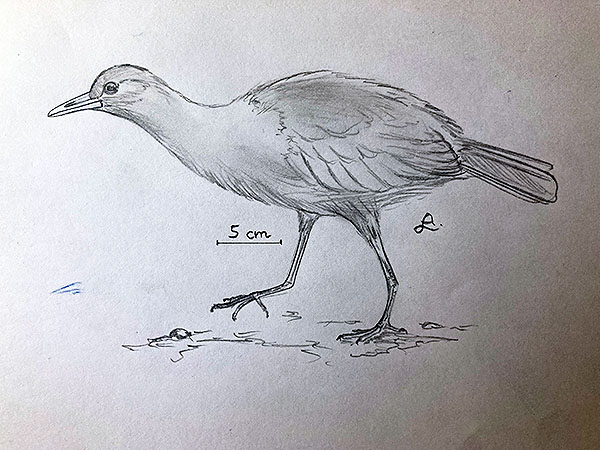
Die Art wird von den Autoren der Gruppe der Tyrannida zugeordnet, einer Gruppe von suboscinen Passeriformes, die heute ausschließlich in Süd- und mit einigen wenigen Arten auch in Nordamerika verbreitet ist und weist hier die größten Gemeinsamkeiten mit den Schnurrvögeln (Pipridae) auf. [2]
Die Tyrannida haben sich jedoch, so wird vermutet, auf den amerikanischen Kontinenten entwickelt, und zwar so ziemlich ungestört seit wohl bereits ca. 64 Millionen Jahren, also zu Beginn des Paläozän. Demnach wäre die Zuordnung dieses oligozänen Vogels aus Europa zu den Tyrannida doch etwas fraglich. [1]
Vielleicht handelt es sich hierbei um eine komplett ausgestorbene Linie von Pipra-ähnlichen suboscinen Vögeln, die später in Europa durch oscine Arten verdrängt wurden.
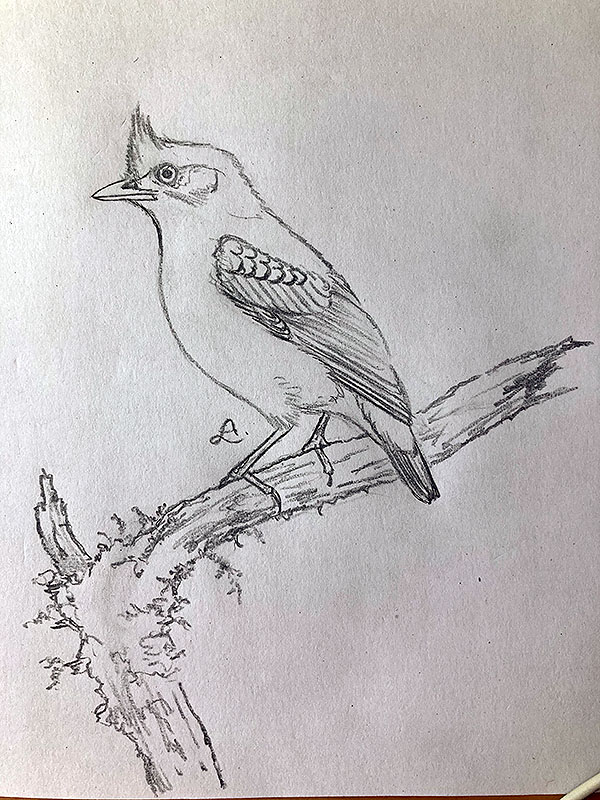
Es ist sehr ungewöhnlich, dass NT-LBR-014, trotz seiner äußerst guten Erhaltung, von den Autoren keinen Namen erhalten hat.
*********************
Quellen:
[1] John Reilly: The Ascent of Birds: how modern science is revealing their story. PELAGIC PUB LTD 2018
[2] Ségolène Riamon; Nicolas Tourment; Antoine Louchart: The earliest Tyrannida (Aves, Passeriformes), from the Oligocene of France. Scientific Reports 10(9776): 1-14. 2020
*********************
bearbeitet: 25.12.2020

*********************
Quelle:
[1] Andrea Cau: Falcatakely: eterodossia e pluralismo nell’Anno di Oculudentavis. Theropoda. 27 Novembre 2020
[2] Mickey Mortimer: Is Falcatakely a bird? The Theropod Database Blog. November 28, 2020
[3] Patrick O’Connor; Alan H. Turner; Joseph R. Groenke; Ryan N. Felice; Raymond R. Rogers; David W. Krause; Lydia J. Rahantarisoa: Late Cretacous bird from Madagascar reveals unique development of beaks. Nature. 2020 Nov 25. doi: 10.1038/s41586-020-2945-x.
*********************
bearbeitet: 28.11.2020
This little feather comes from an Elephant-foot Moa (Pachyornis elephantopus (Owen)), which was found on the South Island of New Zealand and was exterminated about 600 to 500 years ago through hunting and habitat destruction.

The feather is approx. 3.5 cm long and incomplete, but the original colors have been preserved to this day. [1]
*********************
References:
[1] Nicolas J. Rawlence; Jamie R. Wood; Kyle N. Armstrong; Alan Cooper: DNA content and distribution in ancient feathers and potential to reconstruct the plumage of extinct avian taxa. Proceedings of the Royal Society 276: 3395-3402. 2009
*********************
edited: 21.11.2020
Diese (nicht mehr ganz so) älteste bekannte Feder stammt mit ziemlich großer Wahrscheinlichkeit von dem weltberühmten Urvogel (Archaeopteryx lithographica von Meyer), der tatsächlich aber gar kein wirklicher Vogel im eigentlichen Sinn des Wortes war – aber dies genauer zu erklären überlasse ich Berufs-Paläoornithologen.

Die Feder, bislang erstaunlicherweise einzigartig geblieben, ist etwa 6 cm lang, sie war ziemlich wahrscheinlich sehr dunkel grau bis schwarz gefärbt und stammte wohl aus der Region der Flügeldecken. [1]
*********************
Quelle:
[1] Ryan M. Carney; Helmut Tischlinger; Matthew D. Shawkey: Evidence corrobates identity of isolated fossil feather as a wing covert of Archaeopteryx. Scientific Reports 10: 15593. 2020
*********************
bearbeitet: 15.11.2020
Im Moment beschäftige ich mich mit den Bermudas, einer der entlegensten Insel(gruppe)n und auch eine der Regionen über die nicht nur ich nicht viel weiß ….
Die Bermudas waren einst eine einzige, große Insel; durch den immer wieder ansteigenden und abfallenden Meeresspiegel während des Pleistozän ist die Landmasse aber immer wieder mehr oder weniger vollständig überflutet worden, was einerseits zur Entstehung – andererseits aber auch immer wieder zum Aussterben vieler endemischer Arten geführt hat. Vermutlich haben aber viele der einheimischen Vogelarten viel länger überlebt als allgemein gedacht und sind erst zu Beginn des 17. Jahrhunderts nach der Ankunft der ersten menschlichen Siedler ausgerottet worden.
Das kann man den wenigen zeitgenössischen Berichten entnehmen, wenn man diese denn zu entziffern vermag. 🙂
… ja ja, zeitgenössische Beschreibungen … diese hier stammt von Captain John Smith (derselbe, der in der unfassbar verfälschten Geschichte um die Powhatan-‘Häuptlings’tochter Amonute, besser bekannt als Pocahontas, eine zentrale Rolle spielt) und wurde im Jahr 1623 niedergeschrieben.:
“Birds.
Neither hath the aire for her part been wanting with due supplies of many sorts of Fowles, as the gray and white Hearne, the gray and greene Plover, some wilde Ducks and Malards, Coots and Red-shankes, Sea-wigions, Gray-bitterns, Cormorants, numbers of small Birds like Sparrowes and Robins, which have lately beene destroyed by the wilde Cats, Wood-pickars, very many Crowes, which since this Plantation are kild, the rest fled or seldome seene except in the most uninhabited places, from whence they are observed to take their flight about sun set, directing their course towards the North-west, which makes many coniecture there are some more Ilands not far off that way. Sometimes are also seene Falcons & Jar-falcons, Ospraies, a Bird like a Hobby, but because they come seldome, they are held but as passengers; but above all these, most deserving observation and respect are those two sorts of Birds, the one for the tune of his voice, the other for the effect, called the Cahow, and Egge bird, which on the first of May, a day constantly observed, fall a laying infinite store of Eggs neere as big as Hens, upon certaine small sandie baies especially in Coupers Ile; and although men sit downe amongst them when hundreds have bin gathered in a morning, yet there is hath stayed amongst them till they have gathered as many more: they continue this course till Midsummer, and so tame & feareles, you must thrust them off from their Eggs with your hand; then they grow so faint with laying, they suffer them to breed & take infinite numbers of their young to eat, which are very excellent meat.” [1]
Ich habe versucht, dieses etwas kauderwelschige Englisch ins Deutsche zu übertragen, direkt übersetzen lässt sich das leider nicht immer alles.:
“Vögel.
Weder hat die Luft ihrerseits die richtige Versorgung mit vielen Arten von Geflügel verfehlt, wie dem grau-weißen Reiher [?], dem grau-grünen Regenpfeifer, einigen wilden Enten und Stockenten, Blässhühnern und Rotschenkeln, Meerenten [?], Graudommeln, Kormorane, eine Anzahl kleiner Vögel wie Spatzen und Fliegenschnäpper, die in letzter Zeit von den wilden Katzen vernichtet wurden, Spechten und sehr vielen Krähen, die seit der [Anlage der] Plantage getötet wurden, der Rest floh oder wird selten gesehen, außer an den unbewohntesten Plätzen, von wo aus beobachtet wird, dass sie ihren Flug gegen Sonnenuntergang antreten und ihren Kurs in Richtung Nordwesten richten, was viele Vermutungen zulässt, dass es einige weitere Inseln gibt, die nicht weit von diesem Weg entfernt sind. Manchmal werden auch Falken gesehen & Jar-Falken [?],Fischadler, ein Vogel wie ein großer Falke, aber weil sie selten kommen, werden sie nur für Besucher gehalten; vor allem aber verdienen diese beiden Arten von Vögeln Beachtung und Respekt, die eine für die Melodie seiner Stimme, die andere für sein Wirken, genannt [werden sie] Cahow, und Eier-Vogel, die am Ersten des Mai, einem stets beobachteten Tag, einen unendlichen Vorrat an Eiern, fast groß wie Hühner[eier], an bestimmte kleinen Sandküsten legen, besonders auf Coopers Island [seit den 1940ern künstlich mit St David’s Island verbunden]; und obwohl Männer unter ihnen sitzen, wenn sich an einem Morgen Hunderte versammelt haben, so bleiben sie doch unter ihnen, bis sie sich noch viele mehr versammelt haben: Sie setzen dies bis Mittsommer fort, und so zahm und angstlos, Du musst sie mit der Hand von ihren Eiern schieben, dann sind sie so schwach vom Legen, dass sie es nicht schaffen sie auszubrüten & [die Menschen] nehmen unendlich viele ihrer Jungen zum Essen, die sehr gutes Fleisch sind.”
***
Viele der hier aufgezählten Vögel lassen sich identifizieren: der ‘grau-weiße Reiher’ ist vermutlich der Kanada-Reiher (Ardea herodias L.), bei den Enten, Stockenten und Meerenten handelt es sich ziemlich wahrscheinlich um verschiedene Wintergäste, wie sie auch heute noch auftreten, die Blässhühner dürften Amerikanische Blässhühner (Fulica americana Gmelin) sein, die Kormorane sind sicher Ohrenscharben (Phalacrocorax auritus (Lesson)); bei den ‘Fliegenschnäppern’ handelt es sich mit einiger Sicherheit um Bermuda-Weißaugenvireos (Vireo griseus ssp. bermudianus Bangs & Bradlee), die einzige noch existierende endemische Vogelform der Inseln.
Einige, wie der ‘grau-grüne Regenpfeifer’ oder der ‘Rotschenkel’ lassen sich nicht wirklich identifizieren (zumindest aber handelt es sich bei letzterem mit ziemlicher Sicherheit nicht um den eigentlichen Rotschenkel (Tringa totanus (L.))); auch die Falken lassen sich nicht eindeutig identifizieren, da einige Arten immer mal wieder als Zugvögel auf den Bermudas auftauchen.
Mindestens drei der hier augezählten Vögel existieren heute nicht mehr, die ‘Graudommeln’, welche ziemlich sicher Bermuda-Krabbenreiher (Nyctanassa carcinocatactes Olson & Wingate) waren, die ‘Spatzen’, die wohl Bermuda-Grundrötel (Pipilo naufragum Olson & Wingate) waren und die Spechte, die wiederum Bermuda-Goldspechte (Colaptes oceanicus Olson) gewesen sein dürften.
All diese Arten wurden ausschließlich anhand von Knochenfunden beschrieben und zwar 2006, 2006 und 2013. [2][3][4]
***
Das größte Rätsel sind die hier erwähnten sehr vielen Krähen, denn davon gibt es auf den Inseln auch heute noch sehr viele, und zwar Amerikanerkrähen (Corvus brachyrhynchos Brehm), diese gehen jedoch nachgewiesenermaßen auf zwei Vögel zurück, die 1838 als Stubenvögel auf die Inseln gebracht worden waren.
Das bedeutet, dass es auf den Bermudas einst auch eine einheimische Krähenart gegeben haben muss, und dass diese obendrein auch noch sehr zahlreich gewesen sein muss.
Diese Form wurde offenbar von den ersten Siedlern ausgerottet, die die Krähen als Landwirtschaftsschädlinge betrachteten – scheinbar wiederholt sich die Geschichte nun, denn auch die heutzutage auf den Inseln lebenden Amerikanerkrähen werden als Schädlinge angesehen und verfolgt.
*********************
Referenzen:
[1] John Smith: The Generall Historie of Virginia, New-England, and the Summer Isles: with the Names of the Adventurers, Planters, and Governours from their first beginning, An: 1584. to this present 1624. With the Procedings of Those Severall Colonies and the Accidents that befell them in all their Journyes and Discoveries. Also the Maps and Descriptions of all those Countryes, their Commodities, people, Government, Customes, and Religion yet knowne. Divided into Sixe Bookes. By Captaine Iohn Smith, sometymes Governour in those Countryes & Admirall of New England. London: printed by I. D. and I. H. for Michael Sparkes 1624
[2] Storrs L. Olson; D. B. Wingate: A New Species of Night-heron (Ardeidae: Nyctanassa) from Quaternary Deposits on Bermuda. Proceedings of the Biological Society of Washington 119(2): 326-337. 2006
[3] Storrs L. Olson; David B. Wingate: A new species of towhee (Aves: Emberizidae: Pipilo) from Quaternary deposits on Bermuda. Proceedings of the Biological Society of Washington 125(1): 85–96. 2012
[4] Storrs L. Olson: Fossil woodpeckers from Bermuda with the description of a new species of Colaptes (Aves: Picidae). Proceedings of the Biological Society of Washington 126(1): 17–24. 2013
*********************
bearbeitet: 05.11.2020
Endlich, endlich beschrieben!
Das dazugehörige Fossil ist schon seit etlichen Jahren bekannt und wurde ursprünglich als Angehöriger der ausgestorbenen Familie Salmilidae aus der Ordnung der Seriemaartigen (Cariamaformes) betrachtet.
Des Weiteren konnte man oft lesen, dass es sich um einen flugunfähigen Vogel mit winzigen Stummelflügeln gehandelt haben muss, schließlich kann man diese Flügelchen ja im Foto ganz gut erkennen … nun, nein, kann man eben nicht, was man hier sieht sind einfach nur etwas ‘unglücklich’ gewachsene Federn; schaut man genau hin findet sich aber nicht die Spur irgendeines Flügelknochens!
Tatsächlich sind die Vordergliedmaßen des Tieres nach dem Tod bzw. während der Verwesung vollständig abhanden gekommen; sämtliche noch vorhandenen restlichen Teile weisen auf einen normal flugfähigen Vogel hin, er wird also zu Lebzeiten ganz normal ausgebildete Flügel besessen haben..
***
Nahmavis grandei, so heißt der Vogel nun, ist ein sehr ursprünglicher Vertreter der Regenpfeiferfamilie (Charadriiformes).
*********************
Referenzen:
[1] Lance Grande: The Lost World of Fossil Lake: Snapshots from Deep Time. University of Chicago Press 2013
[2] Grace Musser; Julia A. Clarke: An exceptionally preserved specimen from the Green River Formation elucidates complex phenotypic evolution in Gruiformes and Charadriiformes. Frontiers in Ecology and Evolution. 8:559929. doi: 10.3389/fevo.2020.559929. 2020
*********************

*********************
bearbeitet: 26.10.2020
“Two species of Kingfishers were common on Bora-Bora (Halcyon veneratus and Todiramphus tutus), ….“
and
“HALCYON VENERATUS. (Ruru.)
This species is fairly common, especially on the island of Bora-Bora.
TODIRAMPHUS TUTUS.
Common throughout the Tahiti group.” [2]
***
These two rather cursory marginal notes from 1907 are an indication of the former existence of a bird species that no longer exists today and of which (almost) no trace can be found today.
***
The Society Islands are one of the very few places where two kingfisher species coexist, at least on the islands of Mo’orea and Tahiti in the eastern part of the archipelago; here you will find the widespread Chattering Kingfisher (Todiramphus tutus (Gmelin)), which occurs throughout the archipelago, as well as the Tahiti Kingfisher (Todiramphus veneratus (Gmelin)) and Moorea Kingfisher (Todiramphus youngi Sharpe), both restricted to a single island each.
However, the two references to the island of Bora Bora indicate that this was apparently also the case on other of the islands.
In fact, the mysterious kingfisher is not only known from small marginal notes but from at least two specimens that were collected at the beginning of the 19th century, one of which apparently still exists. This sole surviving specimen was examined in 2008 and compared to the Tahiti- and Moorea Kingfisher.
The authors concluded that this is an incompletely colored juvenile of the Tahitian species, but also note some differences, including a much shorter beak and some differences in plumage pattern, and conclude that it may also be an extinct subspecies. [3]
The species has also been depicted at least once (see below). [1]
***
Between Bora Bora in the northwestern part of the archipelago and Mo’orea and Tahiti in the eastern part are four other islands, namely Huahine, Mai’ao, Ra’iatea and Taha’a, each of which, at least today, is inhabited only by the Chattering Kingfisher.
If the island of Bora Bora was indeed once home to two species of kingfishers, then this bird must not have been a subspecies of the Tahitian Kingfisher, but a separate species; and, the other islands between Bora Bora and Mo’orea and Tahiti must most likely also have harbored now extinct and unknown distinct species.
***
In my humble opinion, however, the location of Bora Bora is simply an error, and the two birds collected there are more likely to be from the island of Tahiti. … but who knows ….
*********************

*********************
References:
[1] M. L. I. Duperrey: Voyage autour du monde: Exécuté par Ordre du Roi, Sur la Corvette de Sa Majesté, La Coquille, pendant les années 1822, 1823, 1824, et 1825, par M. L. I. Duperrey; Zoologie, par Mm. Lesson et Garnot. Paris: Arthus Bertrand 1828
[2] S. B. Wilson: Notes on birds of Tahiti and the Society group. Ibis Ser. 9(1): 373-379. 1907
[3] Claire Voisin; Jean-François Voisin: List of type specimens of birds in the collections of the Muséum national d’Histoire naturelle (Paris, France). 18. Coraciiformes. Journal of the National Museum (Prague), Natural History Series 177(1): 1-25. 2008
[4] Justin J. F. J. Jansen & Roland E. van der Vliet: The chequered history of the Chattering Kingfisher Todiramphus on Tahiti: I: type specimens. Bulletin of the British Ornithologists’ Club 135(2): 108-120. 2015
[5] Justin J. F. J. Jansen & Roland E. van der Vliet: The chequered history of the Chattering Kingfisher Todiramphus on Tahiti: II: review of status. Bulletin of the British Ornithologists’ Club 135(2): 121-130. 2015
[6] Michael Lee & David T. Holyoak: The chequered history of Chattering Kingfisher Todiramphus tutus on Tahiti: a response. Bulletin of the British Ornithologists’ Club 137(3): 211-217. 2017
[7] Roland E. van der Vliet & Justin J. F. J. Jansen: Reply to Lee & Holyoak: how definite are 20th-cetury reports of Chattering Kingfisher Todiramphus tutus from Tahiti? Bulletin of the British Ornithologists’ Club 137(3): 218-225. 2017
*********************
edited: 06.07.2023

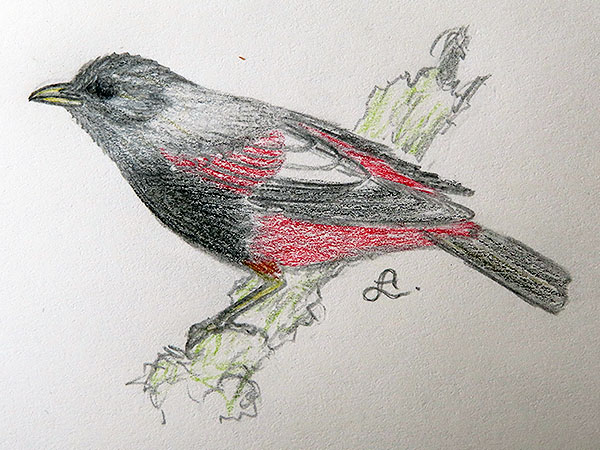
*******************
bearbeitet: 18.10.2020
Mit dem Ende der Kreidezeit starben sämtliche so genannten Nichtvogeldinosaurier (was für ein Wortungetüm) aus, also alles was man landläufig als Dinosaurier bezeichnet aber eben auch sämtliche Vögel, die nicht der einzigen heute noch existierenden Gruppe der Vögel, den Neornithes, zugeordnet werden können.
… oder doch nicht?
***
Qinornis paleocenica ist anhand einiger Reste aus dem unteren oder mittleren Paläozän (vor etwa 61 Millionen Jahren) bekannt, die von einem einzelnen Individuum stammen: ein nahezu vollständiger linker Tibiotarsus, Teile des rechten Tibiotarsus sowie ein nahezu vollständiger rechter Tarsometatarsus mit fast allen Zehenknochen. [1]
Diese fossilen Knochen weisen einige Merkmale auf, die man bei heutigen Vögeln so nicht mehr findet, wohl aber bei einigen aus der Kreidezeit; vor allem ist der Tarsometatarsus nicht vollständig verschmolzen, er weist noch einige Riefen auf, wie man sie heutzutage nur noch bei juvenilen, nicht ausgewachsenen Vögeln findet, nicht aber mehr bei erwachsenen.
Laut einiger Experten für fossile Vögel handelt es sich bei dem Fossil aber durchaus um einen ausgewachsenen Vogel, und Qinornis paleocenica mag einer der allerletzten Vertreter einer der vielen kreidezeitlichen Vogelformen sein, die man zwar der Klade Ornithurae zuordnen kann, zu der auch die Neornithes gehören, die aber trotzdem außerhalb der Neornithes stehen. [2]
*********************

*********************
Referenzen:
[1] X. Xue: Qinornis paleocenica – a Paleocene bird discovered in China. Courier Forschungsinstitut Senckenberg 181: 89-93. 1995
[2] Gerald Mayr: The birds from the Paleocene fissure filling of Walbeck (Germany). Journal of Vertebrate Paleontology, 27(2): 394-408. 2007
*********************
bearbeitet: 01.09.2020
P. H. Bahr in the year 1912 quotes a Dr. B. Glanvill Corney, at that time Chief Medical Officer in the Fiji Islands.:
“There is, or was until eight or ten years ago, a bird in the interior and northern coast of Vitilevu called the ‘Sasa’; described as having speckled plumage and running along the ground among reeds, cane-brakes, and undergrowth. … The Sasa did not fly, and seems to have been a mound-builder. I once met with some dogs in a remote mountain village that the natives had specially trained to hunt the Sasa, which they described as Koli dankata sasa, i. e. Sasa-catching dogs; but I never succeeded in seeing a Sasa, nor did my friend Mr. Frank R. S. Baxendale, who, as Assistant Resident Commissioner in the hill districts, lived for more than a year in the Sasa country. His successor, Mr. Georgius Wright, however, had several living specimens in his possession for some time, and told me that he considered they were Megapodes of the same or of an allied species to those met with in the island of Ninafou [Niuafo’ou] (Boscawen Island) and in Samoa. Some natives linkened them to Guinea-fowl, but said they were not so large as the latter, and that they laid a single egg. Between the years 1876 and 1905 they were still comparatively common and well known in the locality mentioned (where there are only a very few Europeans).” [1]
***
What follows is an account by Rollo H. Beck, an American ornithologist, who quotes some notes that he received by a Mr. G. T. Barker on June 5, 1925, during a stay on the island of Viti Levu, Fiji.:
“Saca Megapode
On the Tova Estate (Viti Levu Bay) one day, as I was riding toward the Wainibaka River, I heard a zooming noise on the rocks at my right. I dismounted to ascertain, if possible, what it was, as the place which had no trees, ws such an unusual one for a pigeon. The note, too, was different, having a more vibrant tone.
Grawling twenty feet along a runway but keeping myself hidden I came upon an abandoned clearing covered with short grass. The bird was about tne yards away. It ws slightly smaller than an English game rooster, had an aggressive head with yellow beak, and a stumpy tail. The coloring which was the same on the head as on the body was a mixed yellow, approaching red, and dingy black.
The bird continued its calling for a few minutes, and was answered from the far end of the clearing. Suddenly it took alarm, and as it flew out of the clearing I saw that under the rudimentary wings there were no yellow feathers. The wings had no long feathers made a whirring sound when the birds flew. I also noticed that its legs were stout, of yellow color, and that the foot had three toes. On questioning the natives, I was told that about sixty years ago there was a great area of grass country in that part, owing probably to a denser population, and also to the fact that the people were more industrious. At that time they used to hunt the bird with dogs and would secure up to fifty in a day. Even up to the coming of the mongoose, hese birds were still hunted, but owing to the spreading of the reeds over the country the catch became small.
The birds nested, generally, under the shelter of the dead leaves of the tree fern, never out in the open, and the birds used to take turns sitting on the nest. The natives described the eggs as being white, quite round, generally one, but on rare occasions, two in a nest. They used to hunt for the eggs, and when all hands were out, as many as a hundred a day would be secured. The eggs were hatched under hens in the village, but the saca always went back to the grass and would not remain in the town.
About two years after I had seen the bird, a dependable native who had hunted the birds in his youth, told me that he had seen a pair about two miles away from The place where I had observed them. Twenty was the largest number that had been observed in one flock.
The natives said that the flesh of the saca was dark, and always lean. Its wings seem to have been of some use for the bird is called in that part “the bird that lands on eight hillocks before being cought.”
The annual rainfall in that region averages ninety inches.” [2]
In my humble opinion this whole description, except for the nesting behaviour, sounds a lot like the description of a species of megapode (Megapodius sp.).
“Yasaca
This bird I have never seen, but from all accounts it differs from the saca. First it was called “Nasataudrau”, literally, “in hundreds”, meaning that a flock would be of about one hundred. It was said of them hat they buried their eggs for the sun to hatch out.
Personally, I am doubtful if this bird ever existed in Fiji. I remember of asking a Sabeto Chief in the year 1890 if he had ever seen one – Sabeto, to the Segatoka River, being the region where the ordinary “saca” was most plentiful. This chief was then a man over sixty years old; now add on the thirty-five years since that time – ninety five years ago, and he had never seen yasaca. He had only heard the trdition in his youth.
I am inclined to believe that the natives of this region brought the tale whith them from the Solomon Islands, where megapodes still are found. See, “A Naturalist Amongst the Head Hunters” by Woodward. Mr. A. Barker has a copy of this book. There is a remarkable similarity of language between that part of the Solomons and Fiji, hence the tradition.” [2][4]
***
It is now well known that the Fiji Islands indeed were inhabited by at least two species of megapode, the Consumed Scrubfowl (Megapodius alimentum Steadman) and the Viti Levu Megapodius (Megapodius amissus Worthy). [3]
It is not really known when exactly these species disappeared; the abovementioned accounts, however, show that at least one of the species survived well into quite modern times.
*********************
References:
[1] P. H. Bahr: On a Journey to the Fiji Islands, with Notes on the present Status of their Avifauna, made during a Year’s Stay in the Group, 1910-1911. The Ibis 9(6): 282-313. 1912
[2] Whitney South Sea Expedition of the American Museum of Natural History. Extracts from the journal of Rollo H. Beck. Vol. 2, Dec. 1923 – Aug. 1925
[3] T. H. Worthy: The fossil megapodes (Aves: Megapodiidae) of Fiji with descriptions of a new genus and two new species. Journal of the Royal Society of New Zealand 30(4): 337-364. 2000
[4] Danke Hr. Antonius, für den Hinweis, damit liegen Sie natürlich vollkommen richtig! 🙂
*********************
edited: 31.01.2022
The Polynesian Ground-Dove (Pampusana erythroptera (Gmelin)) and the Friendly Ground-Dove (Pampusana stairi (Gray)) are mentioned in several enumerations of birds that are thought to inhabit the Gilbert Islands in the Micronesian part of Kiribati.
So, I did a little search to find out something more ….:
The first thing I found was that D. H. R. Spennemann and H. Benjamin name these two species as inhabitants of the Marshall Islands, which apparently is an error since they use A. B. Amerson’s account as their source, in which they are clearly named as inhabiting the Gilbert – but not the Marshall Islands. [2][4].
This is the abovementioned account by A. B. Amerson Jr..:
“Gallicolumba erythroptera* Ground Dove
Status — Introduced breeder in the Gilbert Islands.
Marshall-Gilbert Distribution Records — Breeding: Gilberts – Abemama, Nonouti.
Pacific Distribution — Native to the Society and Tuamotu Islands (Baker, 1951).
*Remarks — I am using the species designation given by Child (1960), who says this species was reported to have been introduced into the Gilberts from Nauru about 1940. Pearson (1962) did not find any doves at Nauru in 1961.” [2]
The Gilbertese name of this bird is given here as bitin, more about that later.
“Gallicolumba stairi* Friendly Ground Dove
Status — Introduced, possible breeder in the Gilbert Islands.
Marshall-Gilbert Distribution Records — Gilberts – Abemama.
Pacific Distribution — Present only at Fiji, Tonga, and Samoa Islands (Peters, 1934)
*Remarks — I am using the species designation given by Child (1960) who says this species was probably introduced from Fiji.” [2]
Here the author states “Child (1960)” as his source, so let’s see where that leads me to.
I could trace all accounts back to the following one, which appears to be the first that mentiones these two dove species, it is from a Peter Child who worked for about one year as an radio operator in the Coastwatching Organisation during WWII and who visited nearly all the islands in the ‘colony’ within a time of three years from 1953 to 1956.
He was an amateur bird-watcher, as he called himself, but his accounts are in fact reliable, in my opinion.
Here they are.:
“24. Gallicolumba erythroptera: Ground Dove.
Lupe palangi. Bitin (Taobe)
While Ducula is a native in the Ellice, being referred to in many old songs and legends, the ground doves are undoubtedly recent introductions of the present century, probably mainly from Fiji. At Abemama they are reported to have been introduced from Nauru about 20 years ago [ca. 1936 because this account was originally puplished in 1956], and have multiplied considerably so that there is now a fair number in a wild state. A few pairs have also been taken from Abemama to some other Gilbert Islands as pets, but in most of the Colony they are unknown. A pair taken to Nanouti had four offspring, and in June two females had nests about ten feet of the ground in an old deserted house; the nests were of grass and stra and built inside old boxes; each contained two eggs, oval in shape and creamy-white in colour. At Abemama they are said to nest in coconut crowns, often high above the ground. They feed mainly on the ground; when disturbed they fly up into the palms and their call, a soft “coo”, may then be heard.
The colouring is typically darkish greys and white; the head, neck, back and upper breats are grey with a purplish and greenish sheen or irridescence; the secondary wing feathers are mainly dark grey and the primaries and tail feathers mainly white; the abdomen is white, often speckled with grey, and he under tail-coverts white. The short bill is dark grey with a small whitish operculum at the base; the legs and feet are coral red, or purplish red. Some birds have less white than others, and hardly any two are exactly alike.” [1]
The name Bitin apparently is the local variation of the English word pigeon, while the name Taobeundoubtedly is the local variation of the German word Taube which means nothing but dove/pigeon; both these names suggest that the birds were imported from somewhere else.
The name Lupe palangi is the Tuvaluan name given to this bird, it can be translated as foreign pigeon (!).
It also appears to me that he did see this species with his own eyes.
He goes on with the second dove species.:
“25. Gallicolumba stairii. Friendly Ground Dove.
There are few individuals in a semi-wild state at Abemama, probably of this species, and probably introduced from Fiji where it is common. The habits are similar to those of G. erythroptera, and there is no distinction in vernacular names of the two species.
The colouring is mainly brown with a little white on the wings and lower breast; the upperparts have a greenish sheen in some lights. The bill is dark and the feet deep red or purplish red.“
*********************
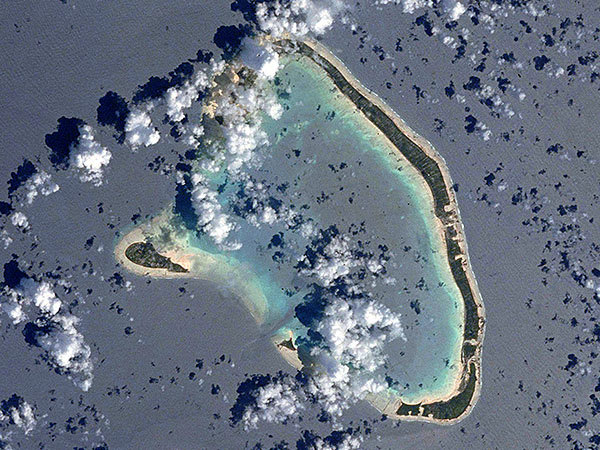
All in all it appears to me that both, the Polynesian- as well as the Friendly Ground Doves, indeed had been introduced sometimes during the middle 1930s, during WWII to at least the Abemama atoll, it appears not to be known by whom, and it also appears not to be known if they still exist there.
Interesting is the statement that at least one of them had been brought from Nauru, where no groud dove species is known to have existed – and if one has existed it might rather have been a distinct, endemic one, but not the Polynesian Ground Dove.
Maybe someone with an interest in birds will be able to make a visit to the Abemama atoll some day and clarify these questions.
*********************
References:
[1] P. Child: Birds of the Gilbert and Ellice Islands colony. Atoll Research Bulletin 74:1-38. 1960
[2] A. B. Amerson Jr.: Ornithology of the Marshall and Gilbert Islands. Atoll Research Bulletin 127: 1-348. 1969
[3] Robert P. Owen: A checklist of the birds of Micronesia. Micronesica 13(1): 65-81. 1977
[4] Dirk H. R. Spennemann; Hemley Benjamin: Notes on the Avifauna of Ebon Atoll, Republic of the Marshall Islands. Historic Preservation Office 1992
*********************
edited: 30.07.2020
When you’re dealing with extirpated/extinct birds, you will sooner or later come across species that raise more questions than others.
Such a species is the Mangareva-yes-what-actually?:
“Lanius gambieranus Lesson, 1844, Écho du Monde Savant, p. 232 (cf. Ménegaux, p. 180). IlesGambier. Type perdu depuis longtemps.
Connue seulement par la description du spécimen qui était autrefois dans la collection du Docteur Abeillé de Bordeaux. Lesson précise qu’une peinture fut préparée par M. Charles Thélot de Rochefort, mais nous n’avons pas retrouvé cette peinture, ni d’ailleurs le spécimen.
[RÉPARTITION ET STATUT]. – Selon Lesson, le spécimen décrit provenait des îles Gambier. Ces îles furent visitées par plusieurs expéditions maritimes françaises avant 1840, et le spécimen fut probablement rapporté par le frère de Lesson, le Docteur Adolphe Lesson, qui voyagea durant quatre années dans les mers du Sud comme «Chirurgien» à bord d’un bateau. Le spécimen était autrefois dans la collection Lesson à Rochefort.
Les seules autres mentions de passereaux aux îles Gambier sont données par Garrett qui trouva des fauvettes durant la seconde moitié du xix* siècle (Wiglesworth, 1891b) et par Buck (1938) qui note KOMAKO – «Reed Warbler». Signalons aussi qu’une fauvette fut observée sur l’îlot Tepapuri en 1971 (Thibault, 1973b). Ce dernier oiseau, blanchâtre dessus et brun dessous, devait être un erratique de la forme habitant les atolls au nord des Gambier, A. caffer ravus. Deux spécimens M.N.H.N ont été considerés comme des oiseaux pouvant provenir des îles Gambier (Lacan et Mougin, 1974b), mais il s’agit vraisemblabIement d’une forme éteinte d’ A. luscinia provenant de Micronésie (Holyoak et Thibault, 1978b). L’expédition Whitney ne trouva pas de fauvette en visitant les îles Gambier, en dépit de nombreuses recherches en 1922 (Beck et Quayle, ms).
[DISCUSSION], – L’oiseau décrit par Lesson ne correspond à aucune forme de spécimens connus. Il est douteux qu’il s’agisse d’une pie-grièche (Laniidae), comme l’avait pensé Lesson. Il est également peu probable que se soit un siffleur (Pachycephala), comme certains auteurs l’ont suggéré (Lacan et Mougin, 1974b; Thibault, 1973b).
La taille, la forme et la coloration font plutôt penser à une fauvette, voisine des formes habitant les îles Cook. Cette hypothèse serait d’autant plus vraisemblable qu’il serait étonnant que des îles volcaniques de la taille des Gambier n’aient pas eu de fauvettes. Sans doute, Lesson avait déjà décrit en 1820 la Fauvette de Tahiti comme appartenant au genre Tatare, mais il n’est pas étonnant qu’il n’ait pas établi de relation entre cette fauvette et l’oiseau des Gambier, en raison de leurs différences morphologiques importantes.
De nombreuses interrogations subsistent au sujet de cet oiseau et il n’est pas évident qu’il ait été véritablement collecté aux Gambier, bien que les autres descriptions de Lesson ne présentent pas d erreurs de localité. “
translation:
“Lanius gambieranus Lesson, 1844, Écho du Monde Savant, p. 232 (cf. Ménegaux, p. 180). Gambier Islands. Type long lost.
Known only by the description of the specimen that was once in the collection of Doctor Abeillé de Bordeaux. Lesson specifies that a painting was prepared by Mr. Charles Thélot de Rochefort, but we have not found this painting, nor indeed the specimen.
[DIVISION AND STATUS]. – According to Lesson, the described specimen came from the Gambier Islands. These islands were visited by several French maritime expeditions before 1840, and the specimen was probably brought back by Lesson’s brother, Doctor Adolphe Lesson, who traveled for four years in the South Seas as a “surgeon” aboard a boat. The specimen was formerly in the Lesson collection in Rochefort.
The only other records of passerines in the Gambier Islands are given by Garrett who found warblers in the second half of the nineteenth century (Wiglesworth, 1891b) and by Buck (1938) who noted KOMAKO – “Reed Warbler”. It should also be noted that a warbler was observed on Tepapuri islet in 1971 (Thibault, 1973b). This last bird, whitish above and brown below [shouldn’t it be vice versa?], must have been an erratic of the form inhabiting the atolls north of the Gambiers, A. caffer ravus. Two M.N.H.N specimens have been considered as birds that may have originated from the Gambier Islands (Lacan and Mougin, 1974b), but they are probably an extinct form of A. luscinia from Micronesia (Holyoak and Thibault, 1978b). [they are now known to indeed be specimens of a species formerly inhabiting the island of Mangareva] The Whitney expedition did not find a warbler when visiting the Gambier Islands, despite extensive research in 1922 (Beck and Quayle, ms).
[DISCUSSION], – The bird described by Lesson does not correspond to any form of known specimens. It is doubtful that it is a shrike (Laniidae), as Lesson had thought. It is also unlikely to be a whistler (Pachycephala), as some authors have suggested (Lacan and Mougin, 1974b; Thibault, 1973b).
The size, shape and coloring are more like a warbler, similar to the forms found in the Cook Islands. This assumption would be all the more likely since it would be astonishing if volcanic islands the size of Gambier did not have warblers. No doubt Lesson had already described the Tahitian Warbler in 1820 as belonging to the genus Tatare, but it is not surprising that he did not establish a relationship between this warbler and the Gambier bird, because of their significant morphological differences.
Many questions remain about this bird and it is not obvious that it was really collected in Gambier, although the other descriptions of Lesson do not present errors of locality.” [3]
Today, most ornithologists think that the description fits best with the extinct Mangarevan Reed-Warbler, a bird that is known to have indeed existed. Yet, there are in fact two surviving specimens of this species, Acrocephalus astrolabii Holyoak & Thibault, which, however, are still often referred to as having been collected somewhere in Micronesia, an assumption that is now obsoleted. [4]
However, the reed-warbler was much larger than 14 cm, and it lacks the yellow underside that our enigmatic bird is said to have had; but let’s just take a look on the original description, it is in French and reads as follows:
„Cette pie-grièche est fort voisine du Lanius tabuensis de Latham. Comme elle, on la trouve dans le mer du Sud, et c’est aux îles Gambier qu’elle vit.
Cette espèce a les formes courtes et trapues. Elle mesure 14 centimètres. Ses ailes sont presque aussi longues que laqueue; son bec est peu crochu, bien que denté; il est noiràtre ainsi que les tarses; tout le plumage en dessus, les ailes et la queue sont d’un brun olivàtre uniforme; le devant du cou, à partir du menton jusqu’au haut de la poitrine, est olivàtre foncé; tout le dessous du corps, depuis le haut du thorax jusqu’aux couvertures inférieures, est du jaune le plus vif et le plus égal; les plumes tibiales sont brunes, mais cerclées d’une sorte de jarretiere jaune à d’articulation le dedans des ailes est varié de jaune et de blanc, ce qui forme un rebord étroit, blanc dessous du fouet de l’aile; la queue est légèrement échancrée, et le sommet des rectrices présente un point jaune.” [1]
Here is my translation:
“This shrike is very close to Lanius tabuensis [Aplonis tabuensis (Gmelin)] of Latham. Like this, it is found in the South Sea, and it lives in the Gambier Islands.
This species has a short, squat form. It measures 14 centimeters. Its wings are almost as long as the tail; the beak is slightly hooked, but dentate; it is black as well as the tarsi; all the plumage above, the wings and the tail are uniformly olive brown; the front of the neck, from the chin to the top of the breast, is dark olive; the whole lower part of the body, from the top of the thorax to the lower coverts, is the liveliest and most even yellow; the tibial feathers are brown, but circled in a sort of yellow, hinged garter, the underside of the wings is varied with yellow and white, forming a narrow, white rim beneath the whip of the wing; the tail is slightly forked, and the top of the rectrices are dotted yellow.”
You see, the species was described as a shrike (Laniidae) and as being very closely related to Lanius tabuensis.
Well, shrikes, of course, do not exist in Oceania at all, and Lanius tabuensis is called Aplonis tabuensis today and is a starling (Sturnidae), the South Sea Starling. You must know that in the 19th century still no one really had any idea of biogeography, and the same applies to the relationships between the different bird species.
Not a shrike, but what about a starling – Aplonis gambieranus?
Hm, according to the description rather not, the size (14 cm) seems a bit too small (my gut feeling), and the colors do not fit to any other Polynesian starling.
Not a starling, but what about a robin – Eopsaltria gambierana?
“EOPSALTRIA GAMBIERANA.
Lanius gambieranus, Less. Echo de M. S. 1844, p. 232.
Eopsaltria gambierana, Hartl. Wiegm. Arch. für Naturg. 1852, p. 133.
Low or Paumotu Islands (Gambier’s Islands or Mangarewa).” [2]
This genus does not occur in Polynesia, but the closely related genus Petroica does indeed (both genera belong to the family Petroicidae), however, both genera, in my eyes, can be excluded for biogeographic reasons.
Not a robin, but what about a whistler – Pachycephala gambierana?
The bird was for some time also thought to may have been a whistler and the genus Pachycephala indeed is occuring in Polynesia, yet only in the western part, namely in Fiji, Samoa and Tonga but not further east, so, no.
Not a whistler, but what about a monarch – Monarcha gambierana?
Personally, I think that the mysterious bird from the island of Mangareva most likely was a monarch species (Monarchidae), namely one of the genus Monarcha (formerly Pomarea). The size indication fits very well, as well as the specified colors, these fit quite well with the young birds of the surviving species of this genus. Apart from that, this genus also fits very well for biogeographical reasons, the distance between the Society Islands and the Gambier Archipelago is only slightly larger than that between the Society Islands and the Marquesas (where the genus still occurs today).
***
Lastly, I would like to mention that this species is officially no longer regarded as having existed at all, not just as dead/extinct, but as ‘having never existed’!
But why?
Because the type does not exist anymore? – this applies also to other species!
Because there was a picture that is now lost as well? – who actually is screwing up something like that, and … this too applies also to other species!
Because no one can say what kind of bird it actually could have been?
In my humble opinion this enigmatic bird, which might very well have existed, most likely was either an somewhat aberrant starling or a member of the monarch family.
*********************
References:
[1] R.-P. Lesson: Catalogue descriptif des oiseaux nouveaux, rares ou peu connus, de la collection Abeillé. L’Écho du monde savant et l’Hermès: journal analytique des nouvelles et des cours scientifiques. 1844 pt. 2: 232
[2] George Robert Gray: Catalogue of the birds of the tropical islands of the Pacific Ocean in the collection of the British Museum. London: printed by order of the Trustees 1859
[3] D. T. Holyoak; J.-C. Thibault: Contribution à l’étude des oiseaux de Polynésie orientale. Mémoires du Muséum national d’histoire naturelle 127(1): 1-209. 1984
[4] Alice Cibois; Jon S. Beadell; Gary R. Graves; Eric Pasquet; Beth Slikas; Sarah A. Sonsthagen; Jean-Claude Thibault; Robert C. Fleischer: Charting the course of reed-warblers across the Pacific islands. Journal of Biogeography 38(10): 1963-1975. 2011
*********************
edited: 29.07.2020
Was there formerly a quail species living on the Fijian Islands?
Well, here is an account by Rollo H. Beck, an American ornithologist, who quotes some notes that he received by a Mr. G. T. Barker on June 5, 1925, during a stay on the island of Viti Levu, Fiji.:
“Moa (Quail)
It is commonly said, by whites, that quail are the offspring of imported birds, but this cannot be so for I have tales that run back for hundreds of years mentioning this bird. A Mr. Coster who was one of the first white settlers on the Island of Koro said that quail were present in great numbers when he arrived there and this was many years back.” [1]
Indeed, there was a quail species living on the Fijian Islands, and it still does, because this account clearly refers to the Brown Quail (Synoicus ypsilophorus ssp. australis (Latham)) (see photo), an Australian species that was introduced to the Fijian Islands sometimes in the early 1900s.
The species is commonly called moa on the islands, it was introduced at least to the islands of Makogai, Vanua Levu, and Viti Levu; it is, however, now apparently restricted to the (artificial) grasslands of Vanua- and Viti Levu. [2]
*********************
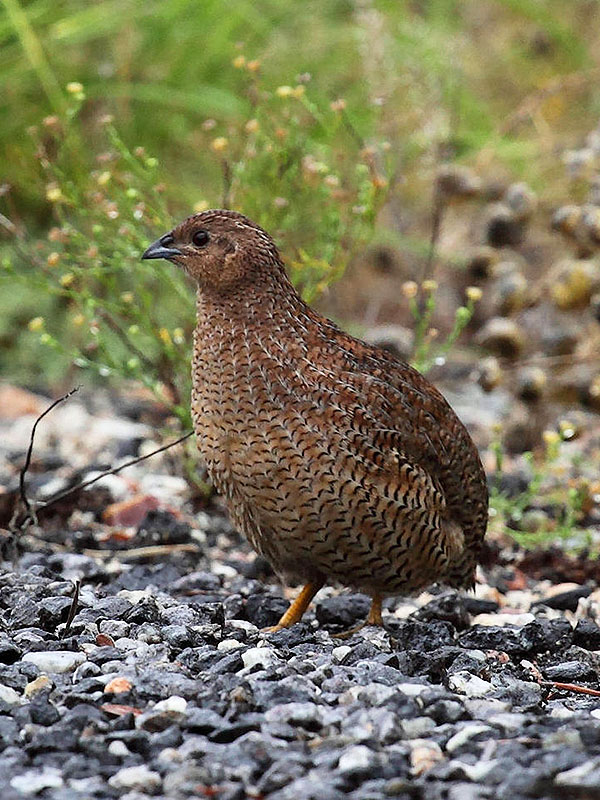
*********************
References:
[1] Whitney South Sea Expedition of the American Museum of Natural History. Extracts from the journal of Rollo H. Beck. Vol. 2, Dec. 1923 – Aug. 1925
[2] Edward Narayan: Troublesome birds of Fiji Islands. Lulu, Inc. 2014
*********************
edited: 29.07.2020
The ‘Blue Parrotfinch’ of Micronesia is actually not really a mysterious bird, it is just the Blue-faced Parrotfinch (Erythrura trichroa (Kittlitz)).
This species inhabits northern Australia, New Guinea, the Maluku Islands, parts of Melanesia and, not least, the Micronesian islands, where it is found today on Chuuk, Kosrae, Palau, and Pohnpei; it very likely was once more widespread and did also inhabit the atolls surrounding these islands, especially those between Chuuk and Pohnpei, which share the same subspecies (ssp. clara Taka-Tsukasa & Yamashina).
The following sentence was taken from an account by J. D. E. Schmeltz and R. Krause from 1881 and apparently refers to the Satawan atoll (unfortunately I couldn’t get my hands on the original).:
“Ein verschlagenes Exemplar der Erythrura trichroa schoss K. [Kubary] einmal hier.” [1][2]
translation:
“K. shoot a stray specimen of the Erythrura trichroa here once.”
***
This species is now mainly found in the higher parts of the abovementioned islands, but very likely was more widespread once, and it is absloutely possible, I guess, that it also inhabited at least some of the atolls between the islands, like so many other Micronesian land birds do.
***
The name ‘Blue Parrotfinch’ refers to a specimen that was collected on Pohnpei and was kept in spirit for some years, thus it lost its green color and its plumage turned into a plain blue; this specimen was later described in 1876 as a distinct species, Erythrura glauca Finsch (see photo).
*********************
References:
[1] J. D. E. Schmeltz; R. Krause: Ein Beitrag zur Kunde der Südsee-Völker. Die Ethnographisch- Anthropologische Abtheilung des Museum Godeffroy in Hamburg. L. Friederichsen & Co., Hamburg 1881
[2] Donald W. Buden: The birds of Satawan Atoll and the Mortlock Islands, Chuuk, including the first record of Tree Martin Hirundo nigricans in Micronesia. Bulletin of the British Ornithologists’ Club 126(2): 137-152. 2006
*********************
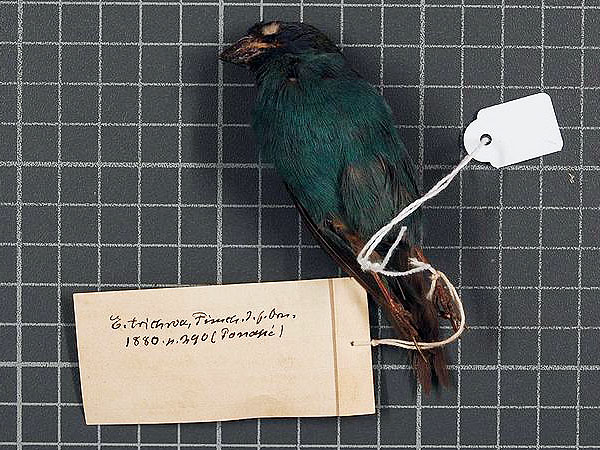
*********************
edited: 29.07.2020
Miller’s Rail is one of the more commonly known so-called mysterious birds.
This species is actually known exclusively from a single drawing made by Georg Forster sometimes between 1772 and 75 during the second voyage of James Cook [and a copy of it made by John Frederick Miller, who described the bird as a new species in 1784]. The annotation just states that it is a Rallus minutus, [a small rail], [called] Maho, [and coming from] Taheitee, [Tahiti].
The drawing is rather a crude one, not „fieldguide-suitable“ and shows a small bird, clearly identifiable as a crake, with rather dark, almost black feathers, sitting on its red legs.
The bird could very well just be a Spotless Crake (Zapornia tabuensis (Gmelin)), which today is still [patchily these days] distributed all over Polynesia, and of course was even more so 250 years ago!
***
There is yet another quite detailed description supposed to be of this species, made by John Latham in 1785 from the actual type, that is now lost.:
„Otaheite R[ail].
LENGTH six inches. Bill three quarters of an inch, black: the head, neck, and all the under parts of the body, dark ash-colour: palest on the chin: the upper parts, and wing coverts, deep red brown: quills dusky, edged with white: edge of the wing, and the first quill feather, white: tail an inch and a half long, rounded in shape, and black: legs dusky yellow. Claws black.
Inhabits Otaheite, and the Friendly Isles. Sir Joseph Banks.“ [2]
***
The same book contains the description of a variety of the Tabuan rail [now Spottless Crake (Zapornia tabuensis)] from the island of Tanna in the Solomon Islands chain which is often regarded to as being the description of the actual type specimen of Miller’s Rail, however, the description differs quite significantly from G. Forster’s depiction.:
“This varies in having the plumage more inclined to brown: the vent white, transversely barred with black lines: legs red.
Inhabits the island of Tanna. Sir Joseph Banks.” [1]
The island of Tanna, mentioned here as place of origin of this bird, was just one of several islands that were visited by Cook and his entourage in the middle of the 18th century, and the place names given by J. Latham are very often completely wrong, however, the descriptions on the other hand are rather complete and trustworthy.
It has to be taken into account that such old books most often lack any kind of register and that they mostly just use common names but lack scientific ones, searching inside them is a long-term venture.
***
It is now quite well known that in former times probably all of the islands in the tropical Pacific Ocean were inhabited by endemic rails, with several islands being known to have been inhabited by more than one species, and in many cases these were congeneric species, meaning species from one and the same genus – something that today is extremely rare, which, however, is a relict situation, left behind by human-induced extinctions. [5]
***
In ancient Tahiti, the meho too was thought to represent a deity, namely Tu (in his manifestation of moonlit sky), the meho‘s cry is given as having been a “ho”, which is also thought to be the characteristic sound made by Tu himself. [3][4]
This little sentence is yet another prove for the former existence of another rail species on Tahiti beside the Red-billed Rail (Gallirallus pacificus (Gmelin)), which is also mentioned in this short enumeration of birds representincg gods in ancient Tahiti.
*********************
References:
[1] John Latham: A General Synopsis of Birds 3(1): 235. Leigh & Sotheby, London 1785
[2] John Latham: A General Synopsis of Birds 3(1): 236. Leigh & Sotheby, London 1785
[3] Teuira Henry: Ancient Tahiti. Bishop Museum Bulletins 48: 1-651. 1928
[4] Douglas L. Oliver: Ancient Tahitian Society. The University Press of Hawai’i, Honolulu 1974
[5] David W. Steadman: Extinction and Biogeography of Tropical Pacific Birds. University of Chicago Press 2006
*********************

*********************
edited: 28.07.2020
Diese heute wohl kaum mehr bekannte ‘Art’ wurde im Jahr 1788 anhand eines einzelnen Exemplars sowie einer Beschreibung von John Latham [1] als Trochilus multicolor Gmelin beschrieben.
Der Harlequinkolibri erreichte laut Beschreibung eine Größe von insgesamt 12,7 cm, hatte einen relativ langen Schnabel und war recht auffällig gefärbt.
Es sind einige Abbildungen dieser ‘Art’ überliefert, im Ganzen existieren allerdings eigentlich nur zwei verschiedene Darstellungen, die wieder und wieder von verschiedenen Künstlern kopiert wurden. [2]
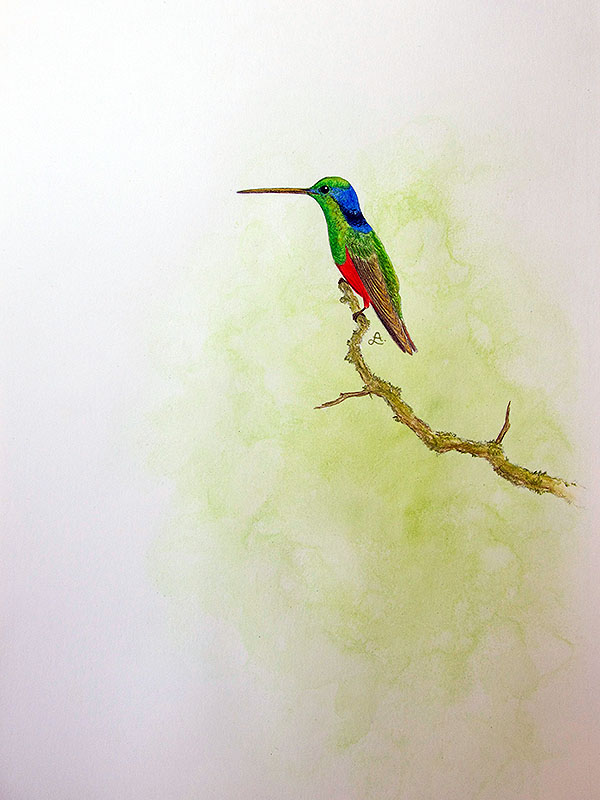
Das einzige bekannte Harlequinkolibri-Exemplar wurde 1819 (?) als Fälschung erkannt und letzlich weggeworfen, so dass es nicht mehr für weitere Untersuchungen zur Verfügung steht. [2]
*********************
Referenzen:
[1] John Latham: Supplement to the General synopsis of birds. London: printed for Leigh & Sotheby 1787
[2] Robert Prŷs-Jones; Rick Wright: Rise and fall of the Harlequin Hummingird ‘Trochilus multicolor’: a species that never was. Bulletin of the British Ornithologists’ Club 139(3): 215-227. 2019
*********************
bearbeitet: 17.05.2020
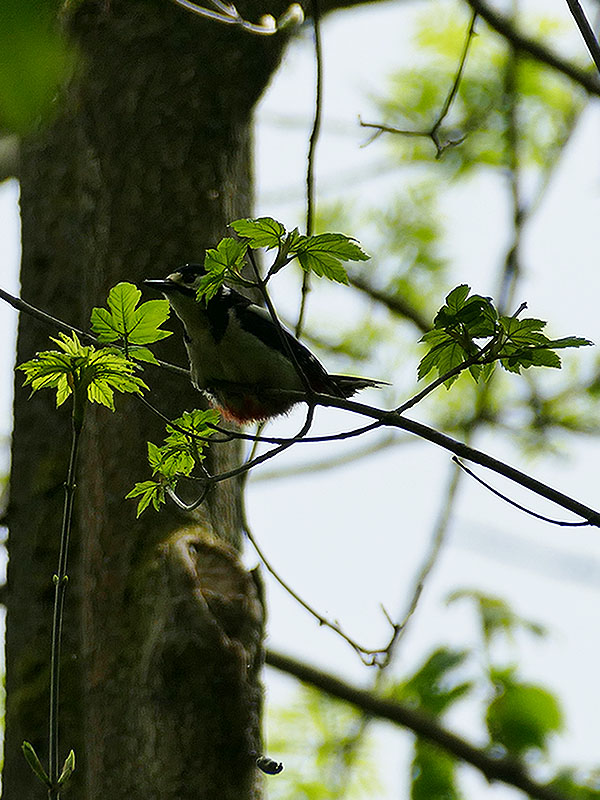
********************
bearbeitet: 10.05.2020
Hinter diesem Arbeitsnamen verbirgt sich ein winziges Knochenfragment, das distale Ende eines linken Humerus, gerade einmal 0,27 cm hoch und 0,26 cm breit, es stammt aus einer etwa 26 Millionen Jahre alten Fundstätte bei Herrlingen, Baden-Württemberg, Deutschland.
Auch wenn es sich hierbei um das wohl kleinste Fragment handelt, das in Herrlingen gefunden wurde, lässt sich dieses, im Gegensatz zu nahezu allen anderen, zumindest grob einer Gruppe zuordnen, nämlich zu den Euoscines oder Eupasseres, zu denen heute nur noch die Dickichtvögel (Atrichornithidae) und Leierschwänze (Menuridae) Australiens gehören.
Der Vogel wird zu Lebzeiten eine Größe von etwa ca. 9 bis 12,5 cm erreicht haben, je nachdem an welchem Referenzmaterial man sich orientiert.
*********************
References:
[1] Albrecht Manegold: Passerine diversity in the late Oligocene of Germany: earliest evidence for the sympatric coexistence of Suboscines and Oscines.
*********************
edited: 07.05.2020
Die Ordnung der Sperlingsvögel, die heute weltweit verbreitet ist (abgesehen vom antarktischen Kontinent), lässt sich ganz grob in drei Unterordnungen aufspalten: die Passeri (oder Oscines), die Tyranni (oder Suboscines) und schließlich die Acanthisitti, die nur noch zwei Gattungen und Arten umfassen, die auf Neuseeland beschränkt sind.
***
Anhand von oberoligozänen (vor 28 bis 23 Millionen Jahren) Fossilfunden aus Herrlingen, Baden-Württemberg, Deutschland ist noch mindestens eine vermutliche weitere “primitive” Unterordnung mit mindestens einer Art belegt. [1]
Vermutlich gab es zu jener Zeit noch weitere solcher Unterordnungen von deren ehemaliger Existenz aber heute keine Fossilbelege mehr zeugen.
Ich habe mal ein bisschen herumgemessen und -gerechnet und bin auf eine geschätzte Gesamtgröße dieses Vogels von ungefähr 9 bis 15 cm gekommen, das ist so ziemlich genau total ungenau, als Referenzvögel habe ich Fotos von Starenskeletten sowie die Zeichnung eines Hopfstar-Skelettes (Fregilupus varius (Boddaert)) verwendet, wahrscheinlich kommt aber der kleinere Wert der Wahrheit am nächsten.
Vielleicht werde ich diesen namenlosen Vogel dann auch irgendwann einmal zeichnen.
*********************
Referenzen:
[1] Albrecht Manegold: The early fossil record of perching birds (Passeriformes). Palaeontologica Africana 44: 103-107. 2009
*********************
bearbeitet: 06.05.2020
Pünktlich zum 6. Mai sind sie wieder da, meine Lieblingsvögel – die Mauersegler.

*********************
bearbeitet: 06.05.2020
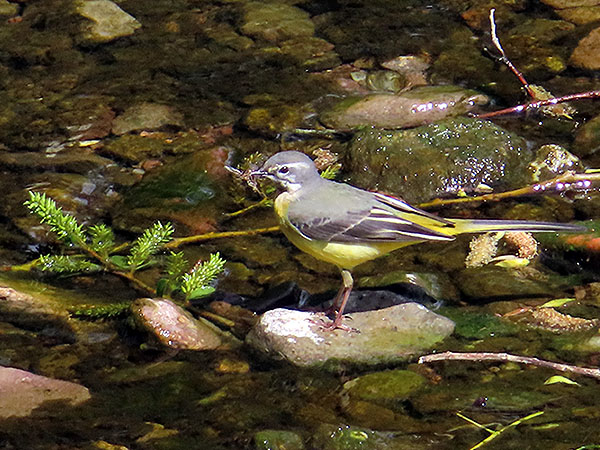
*********************
bearbeitet: 23.01.2021

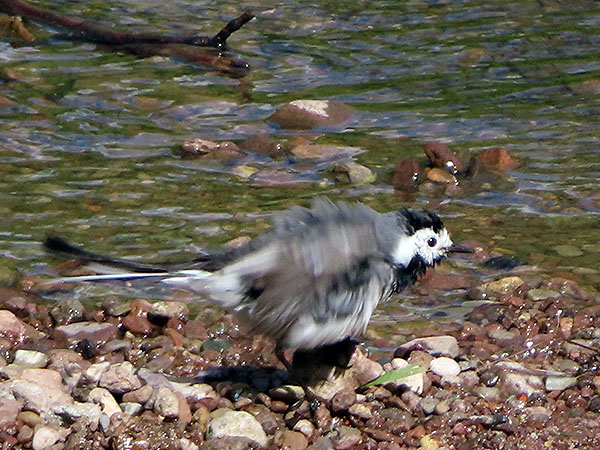
*********************
bearbeitet: 23.01.2021

*********************
bearbeitet: 01.04.2021
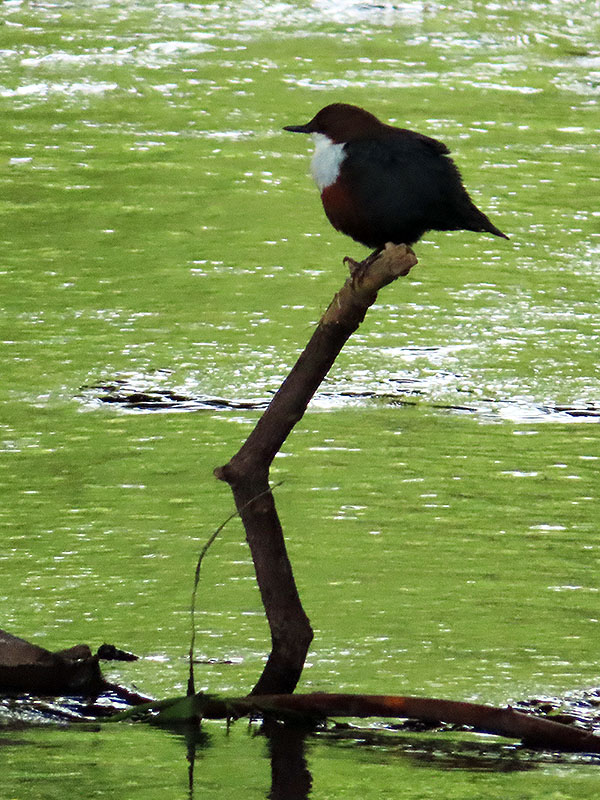
*********************
bearbeitet: 01.04.2021
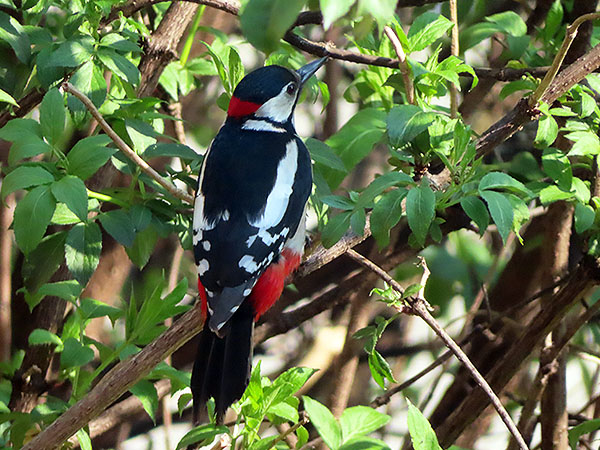
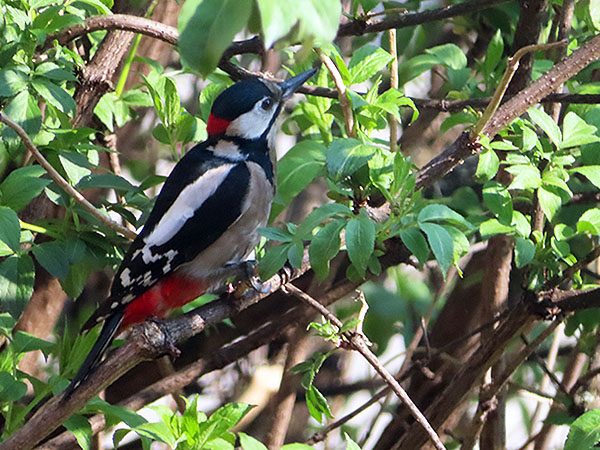
*********************
bearbeitet: 23.01.2021
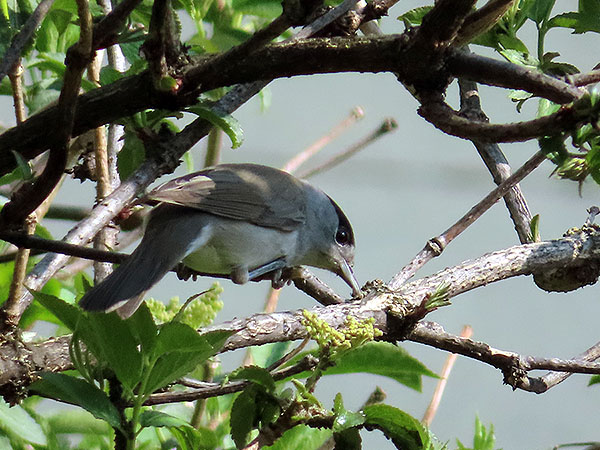
*********************
bearbeitet: 23.01.2021
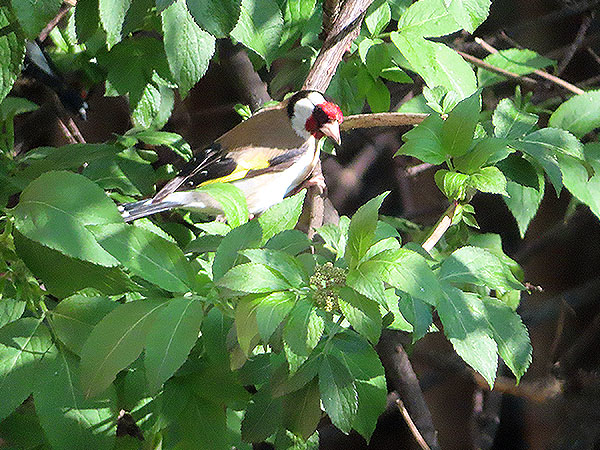
*********************
bearbeitet: 23.01.2021
Wir waren heute in Schönau vor dem Walde um nach interessanten Fotomotiven zu suchen, dabei sind mir diese nicht ganz furchtbar schlechten Fotos einer Goldammer gelungen. 🙂
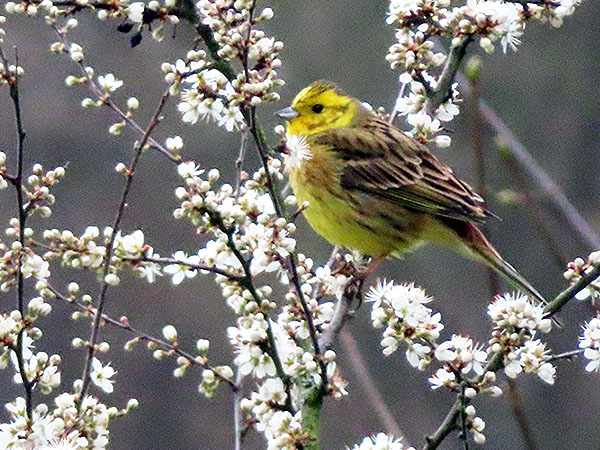
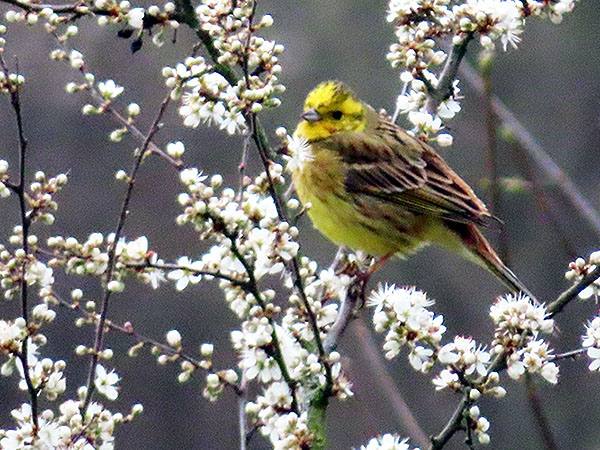
*********************
bearbeitet: 23.01.2021
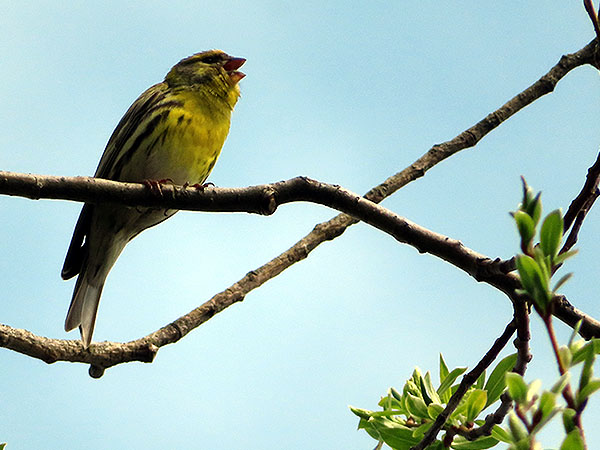
*********************
bearbeitet: 29.06.2023
Marquesas Kingfisher (Todiramphus godeffroyi), a nearly extinct bird endemic to the Marquesas Islands.
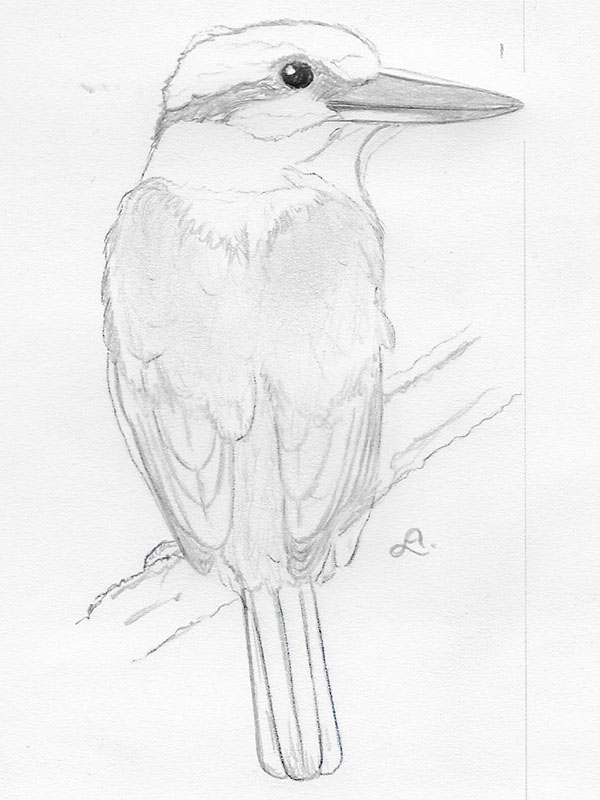
Dies ist der „neueste“ der europäischen Oligozänvögel mit „brüchigen Gliedmaßen“, diesmal sind nur die Flügelknochen erhalten. Diese unterscheiden sich von den Flügelknochen sämtlicher anderen bisher bekannten, lebenden oder ausgestorbenen Sperlingsvogelarten.
Der Vogel war klein, ungefähr so groß wie eine Kohlmeise (Parus major L.). Ich werde sehen, ob ich überhaupt in der Lage bin, eine Art Rekonstruktion anzufertigen. [1]
*********************
Quelle:
[1] Zbigniew M. Bocheński, Teresa Tomek, Krzysztof Wertz, Johannes Happ, Małgorzata Bujoczek & Ewa Świdnicka: Articulated avian remains from the early Oligocene of Poland adds to our understanding of Passerine evolution. Palaeontologia Electronica 21(2). 2018
*********************
… kleines Update.
Ich habe eine kleine Skizze gemacht, die auf einer Kohlmeise basiert. Da ich jedoch wusste, dass dieser Vogel mit keinem der modernen Passeriformes verwandt war, habe ich beim Zeichnen an eine kleine singvogelähnliche Kreatur, die einigen der australisch / papuanischen „primitiven“ Singvögel ähnelt gedacht.
*********************
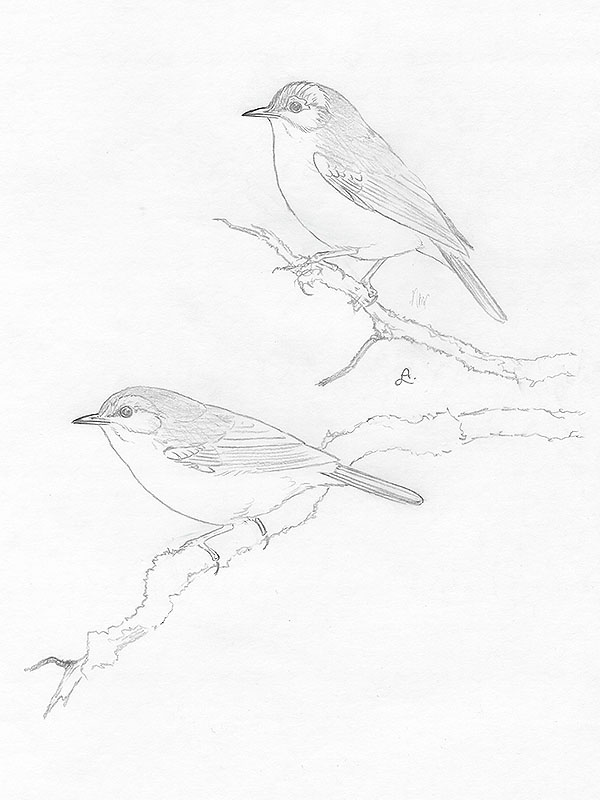
*********************
bearbeitet: 06.04.2020
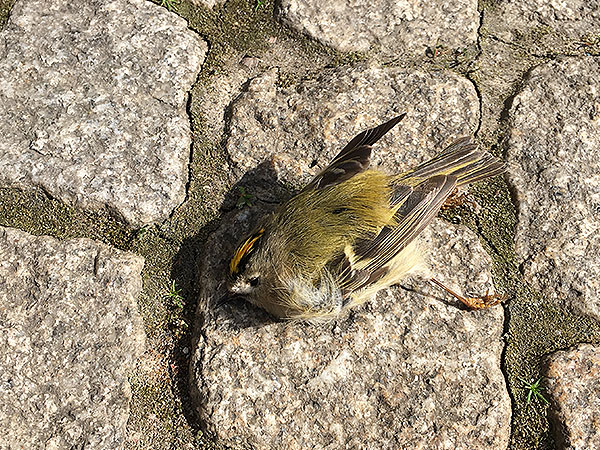
Levaillant’s Pie-Grièche Rouge A Plastron Blanc, the White Shrike with the Red Breastplate, is one of several enigmatic species of birds that were described in the early 1800s based on stuffed specimens that were actually just fakes composed by some business-minded taxidermist from the parts of several other birds, a practise that was quite common in former times.
The more unusual such a specimen the higher probably was its price ….

Here is a part of the description, which mentions the supposed origin of this ‘species’ as having been the islands of the South Seas, which actually could be anywhere …:
“Cette belle espèce appartient, à ce qu’on m’a assuré, aux îles de la mer du Sud. De quatre individus que j’ai vus, deux avoient la barre de l’aîle blanche au lieu d’être rouge; celles-ci seroient- elles des femelles? C’est ce que j’ignore, n’ ayant euà leur égard aucun renseignement quelconque, et n’ayant vu que les peaux rembourrées de ces oiseaux.“
translation:
“This beautiful species belongs, as I have been assured, to the islands of the South Sea. Of the four individuals I saw, two had the bar of the wing white instead of being red; would these be females? This is what I do not know, having had no information whatsoever about them, and having only seen the padded skins of these birds.“
***
However, the fake was uncovered 60 years later.:
“Note. – The Lanius mystaceus, Lath. Ind. Orn. Suppl. p. xix; Levaill. Ois. d’Afr. t. 65 (Laniarius mystaceus, G. R. Gray, Gen. of B. i. p. 299), has been stated by Levaillant to be from an isle in the South Seas. It is, however, a made-up bird, being composed of a portion of the Lanius ferrugineus, Gm., with the feathers on the belly and tail from a species of red Psittacus, while the breast and vent are those from a species of Malaconotus.” [2]
The Lanius ferrugineus, Gm., mentioned here, is the Southern Boubou (Laniarius ferrugineus (J. F. Gmelin)) a bird without red feathers, so I personally think that the original body was ‘borrowed’ from another species, possibly from the Crimson-breasted Gonolek (Laniarius atrococcineus (Burchell)), which then got decorated with the red tail feathers of another bird, which might well have been some species of parrot.
*********************
References:
[1] François Le Vaillant: Histoire naturelle des oiseaux d’Afrique. Paris, chez J. J. Fuchs, libraire, Rue des Mathurins, Hôtel de Cluny: de l’imprimerie de Perroneau, Rue des Grands Augustins 1799
[2] George Robert Gray: Catalogue of the birds of the tropical islands of the Pacific Ocean in the collection of the British Museum. London: printed by order of the Trustees 1859
*********************
edited: 21.03.2020
A pigeon collected during one of J. Cook’s journeys in the middle of the 18th century on the island of Tahiti, Society Islands, was described and named Columba R. forsteri in 1829 by J. G. Wagler, this is the original description.:
“C. R. Forsteri. Habitus et magnitudo C. globicerae; capite et cervice prorsus nigris; dorso, uropygio, remigibus et rectricibus coeruleo et viridi nitentibus; gula, jugulo, pectore, abdomine femoribusque fuliginosis; crisso ferrugineo; capistro albo; cera prorsus non globosa.
Columba globicera var.? Reinh. Forster in Manuscr.
Rostrum nigrum; pedes rubri. Habitat in insula Otaheite, ab incolis Aroobu appeliate.” [1]
(my humble) translation:
“C. R. Forsteri. Shape and size of C. globicera; head and neck completely black; on the back, from the rump, and the rectrices shining blue and green; throat, neck, breast, belly (hips?) sooty; undertail coverts ferruginous; lores white; cere absolutely not globose.
Columba globicera var.? Reinh. Forster in Manuscr.
Beak black; feet red. Inhabits the island of Otaheite, named by the islanders Aroobu.“
***
According to S. L. Olson and D. W. Steadman this description fits very well with the Nuku Hiva Imperial Pigeon (Ducula galeata (Bonaparte)), which is now restricted to the island of Nuku Hiva, Marquesas, but which indeed is known to have been much more widespread in former times. [2]
However, this species is much larger than the Polynesian Imperial Pigeon (Ducula aurora Peale) from Tahiti, named Columba globicera in the description, and not of the same size, and its head and neck are slate-colored and not black as the description says; anyway, neither the adult nor the juvenile Polynesian Imperial Pigeon have ferruginous undertail coverts while the Nuku Hiva Imperial Pigeon again has.

So, after all, this little description may indeed be the only historical record of the Nuku Hiva Imperial Pigeon outside the island of Nuku Hiva, it disappeared sometimes during the 18th century. Subfossils assigned to this large bird are now known from Mangaia, Cook Islands; Hiva Oa, Tahuata and Ua Huka, Marquesas; as well as from Huahine, Society Islands. [3]
However, I personally still have some doubts about the identity of these large imperial pigeon forms outside of the Marquesas, in my humble opinion they should rather be considered distinct forms.
*********************
References:
[1] J. G. Wagler: Beiträge und Bemerkungen zu dem ersten Bande seines Sytsema Avium. (Fortsetzung III.) Isis von Oken 7: 735-762. 1829
[2] S. L. Olson; D. W. Steadman: Comments on the proposed suppression of Rallus nigra Miller, 1784 and Columba R. Forsteri Wagler, 1829 (Aves) .Bulletin of Zoological Nomenclature 44, 126-127. 1987
[3] David W. Steadman; Dominique S. Pahlavan: Extinction and biogeography of birds on Huahine, Society Islands, French Polynesia. Geoarchaeology 7(5): 449-483. 1992
*********************
edited: 18.03.2020
The genus Pampusana, formerly Gallicolumba and then Alopecoenas, apparently did once occur also as far northeast as to the Line Islands of Kiribati, as can be taken from an account from 1840 by Frederick Debell Bennett about a stay on Caroline Island, now named Karoraina.:
“At night, on the 22nd of April, many shoal-birds came about the ship, greeting us with their hoarse cries, so prophetic of the vicinity of land; and at daybreak on the following morning, Caroline Island was seen from the mast-head, bearing N.W., distant 10 miles.
…
The inland thickets contained a great number of small pigeons, with white head and neck, and the rest of their plumage of a rich brown colour.” [1]
This account might refer to a population of the Polynesian Ground Dove (Pampusana erythroptera (Gmelin)) as suggested by David W. Steadman & Dominique S. Pahlavan or, given the extreme distance between the northernmost Tuamotuan atolls and the island of Karoraina, may perhaps rather refer to a distinct, now extinct species. [2]
*********************
References:
[1] F. D. Bennett: Narrative of a Whaling Voyage round the Globe, from the year 1833 to 1836. London: Richard Bentley 1840
[2] David W. Steadman; Dominique S. Pahlavan: Extinction and biogeography of birds on Huahine, Society Islands, French Polynesia. Geoarchaeology 7(5): 449-483. 1992
*********************
edited: 17.03.2020
I found another interesting account that I had overlooked previously in ‘Te Manu: Bulletin de la Société d’Ornithologie de Polynésie. Nr 25. December 1998’.:
“De notre correspondant Yves GENTILLOMME à Rurutu
Lors du passage de Jean-Yves Meyer sur l’île de Rurutu, Yves Gentillomme lui a signalé avoir entendu le chant facilement reconnaissable d’une fauvette (Acrocephalus sp.). Il n’y a pas de description de fauvettes à Rurutu dans la littérature mais on en trouve une sur l’île voisine de Rimatara: Acrocephalus rimitarae (autrefois considérée comme une sous espèce de Acrocephalus vaughani de Pitcairn) – cf TE MANU n°23. Il s’agit peut être d’un oiseaux en provenance de cette île. Il existe une autre observation de fauvette aux Australes sur l’île de Raivavae. Cette observation ancienne n’a jamais été renouvelée.” [1]
translation:
“From our correspondent Yves GENTILLOMME in Rurutu
During Jean-Yves Meyer’s visit to Rurutu Island, Yves Gentillomme told him that he heard the easily recognizable song of a warbler (Acrocephalus sp.). There is no description of warblers in Rurutu in the literature but there is one on the neighboring island of Rimatara: Acrocephalus rimitarae (formerly considered as a subspecies of Acrocephalus vaughani from Pitcairn) – see TE MANU n°23. It may be a bird from this island. There is another sighting of a warbler in the Austral Islands on Raivavae Island. This ancient observation has never been repeated.“
***
Today the island of Rurutu does not harbor an endemic reed-warbler species but it may well have done so in former times; the neighboring island of Rimatara, however, still is home to an endemic form of reed-warbler, the Rimatara Reed-Warbler (Acrocephalus rimitarae (Murphy and Mathews)), and the bird heard singing on Rurutu in the late 1990s might indeed have been such a bird.
The Rimatara Reed-Warbler may be in the state of expanding its distributional area, or there may just be some stray birds appearing on neigboring islands from time to time.
There is, however, a very little possibility that there is an endemic Rurutu Reed-Warbler that has survived into the late 1990s.
*********************
References:
[1] Te Manu: Bulletin de la Société d’Ornithologie de Polynésie. Nr 25. December 1998
*********************
edited: 17.03.2020
We are more or less ‘housebound’ thanks to the Corona virus … so, we took a walk through the city.
It is now definitely spring because there are starlings singing from almost every tree.:
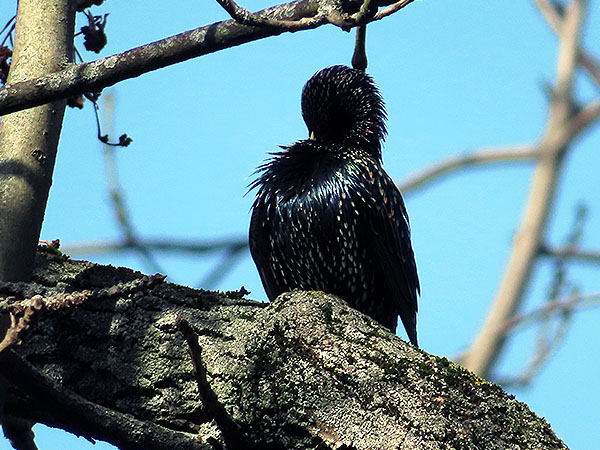
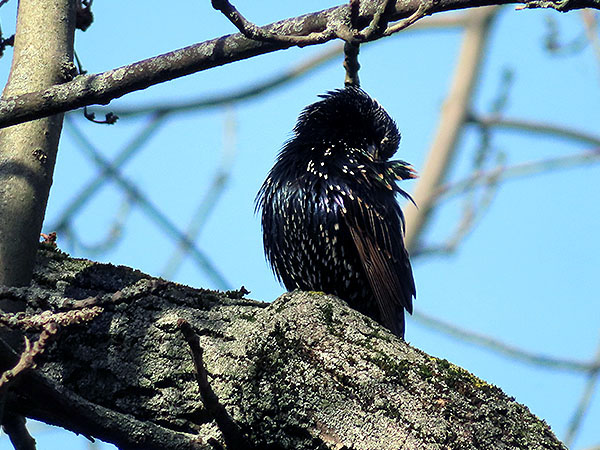
I usually don’t look at the Mallards because they are typical feral ducks, many of which don’t resemble wild ducks at all.:
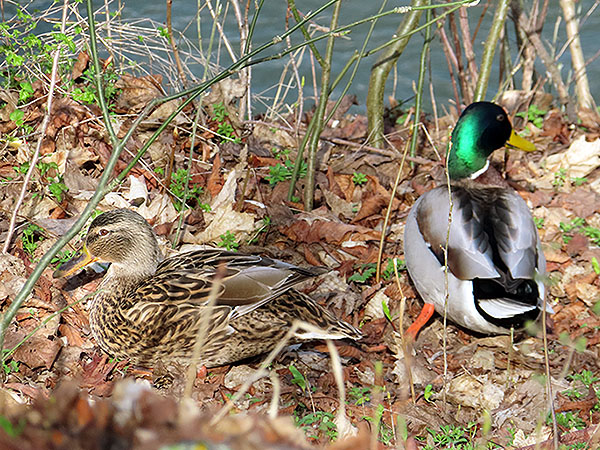
Another sign for/of spring are singing Chaffinches, like with the starlings, almost every tree has its own singing Chaffinch right now, however, they are very difficult to photograph because they usually fly away as soon as they spot the camera.:
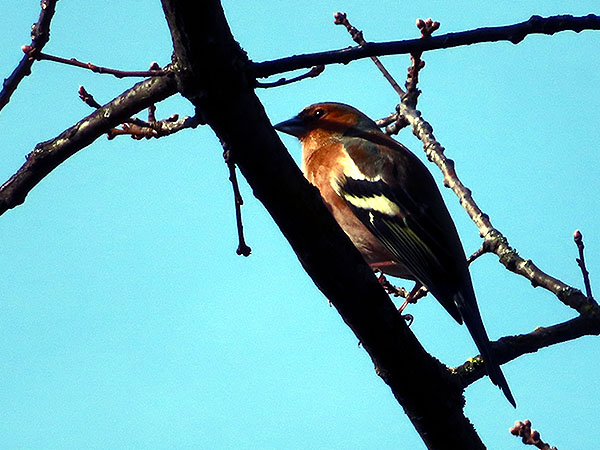
This is a Goldfinch, it has one of the most beautiful songs of all European birds.:
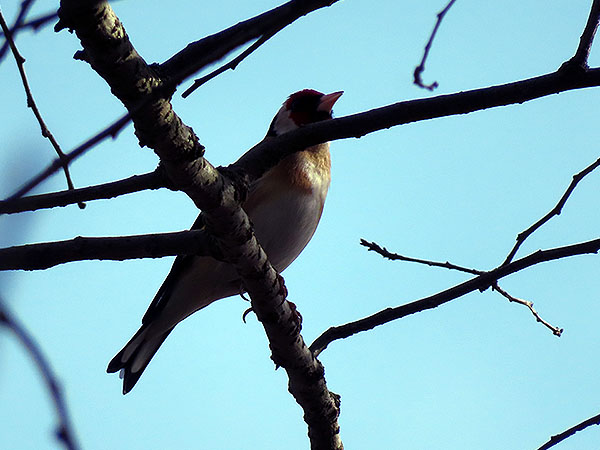
This little cutie was hopping about as close as only one meter away from us, so I could make at least two quite good pictures.:
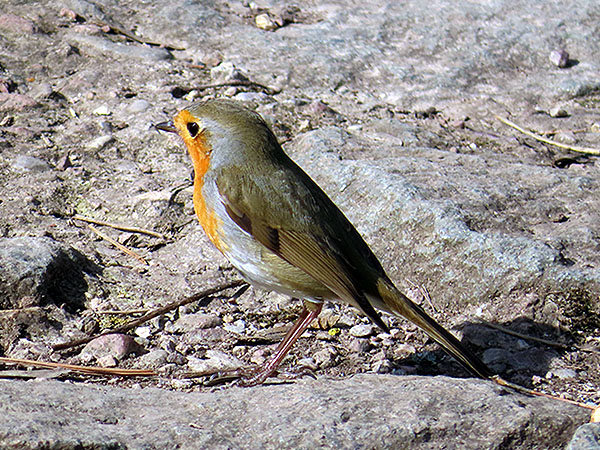
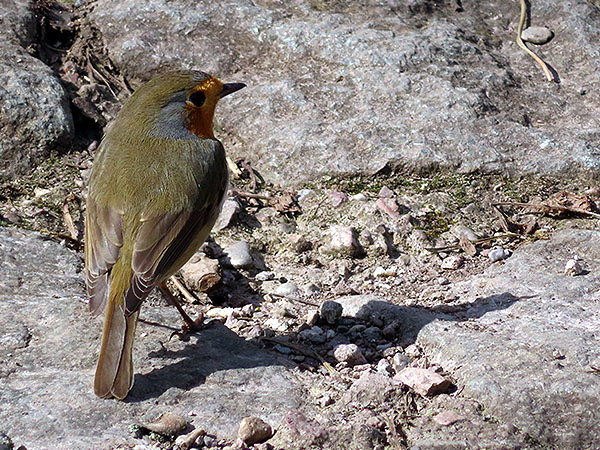
“The quail spoken of by an early writer as occurring on Christmas [Kiritimati] and possibly other islands was probably the native sandpiper, as it resembles a quail when running on the ground and a merchant here told me the other day of quail on Scilly Islands [Manua’e] which he is putting into coconuts.” [1]
***
This rather incidental and somewhat strange side note is the only reference to the past existence of a species of sandpiper (Prosobonia sp.) on the ‘Leeward Islands’ in the Society Islands group, a species of the same genus known to have inhabited the islands in the past islands of Mo’orea and Tahiti in the southeast of the same archipelago.
The only island in this group on which a fossil site has been discovered so far is Huahine, from where there are, at least so far, no finds of this genus.
The form from the Manua’e Atoll, if it really existed – and I think it might well have existed – might have been identical to that known from subfossil remains found on the island of Mangaia in the Cook Archipelago [2], or it may have been a distinct form; but it was certainly not identical with the birds of the islands of Mo’orea and Tahiti, and it was certainly not identical with the Tuamotu Sandpiper (Prosobonia parvirostris (Peale)), since the Manua’e Atoll is much closer to the Cook Archipelago than to the Tuamotu Archipelago.
Interestingly, the report cited above appears to date from the early 20th century, indicating that various Polynesian bird forms might have survived much longer than is often assumed.
*********************

*********************
References:
[1] Whitney South Sea Expedition of the American Museum of Natural History. Extracts from the journal of Rollo H. Beck. Vol. 1, Sept 1920 – June 1923
[2] D. W. Steadman: Extinction and Biogeography of Tropical Pacific Birds. University of Chicago Press 2006
*********************
edited: 05.07.2023
Rollo H. Beck, an American ornithologist, quotes some notes that he recieved by a Mr. G. T. Barker on June 5, 1925, during a stay on the island of Viti Levu, Fiji: ‘Notes by Mr. G. T. Barker, Suva, Fiji. June 5, 1925’.
One of these notes is about an alleged Fijian hummingbird.:
“Humming bird
One evening as I was sitting on the steps, I saw what I took to be a night moth settle on a hibiscus flower. …
The supposed moth kept its wings in rapid motion, while poised before the flower sucking the honey with its long slender bill.
I struck the “moth” with a fly switch which I had in my hand, and on picking it up, found that I had killed a small bird. I had seen only the pictures of humming birds but I concluded that this was one. Its slightly curved bill was black, as was the slender, pointed tail; the fine feathers on the breast were a bright red; the shoulders and patch under the tail were of darker tone.
Herewith is a sketch drawn to scale, which I made the next morning, after I found that the rats had eaten the bird from the wall where I pinned it.
1921“
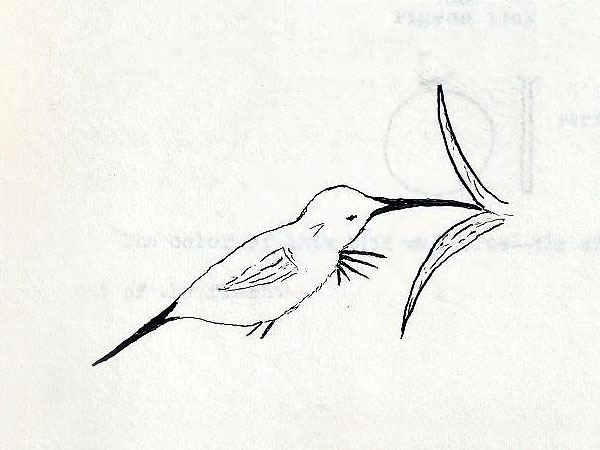
“Feathers, fine as the fur of flying fox
Wings, very small
Body, red
Head and back, darker than breast
Bill and legs, black” [1]
Of course, hummingbirds are not found outside of the Americas, and this anecdote is
supposed to have taken place on the island of Viti Levu, Fiji.
But what kind of bird is involved in this story then?
I have to confess that I have no real idea, the most likely candidate is the orange-breasted Myzomela (Myzomela jugularis Peale), however, this species hasn’t a red body.
***
I personally think that this account is a very bad eyewithness records, made by someone not really interested in the natural world.
*********************
References:
[1] Whitney South Sea Expedition of the American Museum of Natural History. Extracts from the journal of Rollo H. Beck. Vol. 2, Dec. 1923 – Aug. 1925
*********************
edited: 14.03.2020
The Collared Kingfisher (Todiramphus chloris (Boddaert)) has a extremely wide distribution and occurs from parts of Arabia well into western Polynesia; it is the only kingfisher living on the Fiji Islands (with three endemic subspecies) – yet, may there once have been another kingfisher species?
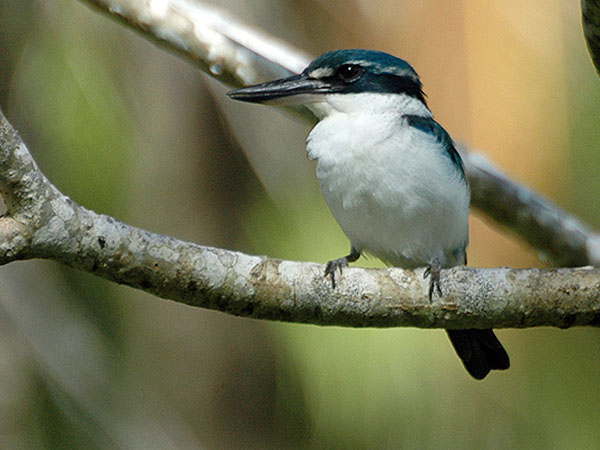
Rollo H. Beck, an American ornithologist, quotes some notes that he received by a Mr. G. T. Barker on June 5, 1925, during a stay on the island of Viti Levu, Fiji: ‘Notes by Mr. G. T. Barker, Suva, Fiji. June 5, 1925’.:
“Giant Kingfisher
I saw this bird, or a single bird at least, on two occasions and it rose, both times, from nearly the same place. On the last occasion, I was on the lookout for it and it passed within twenty feet in front of me so that I had a good opportunity to see it clearly. I was riding down from the village of Navuniwi, Viti Levu Bay, toward the beach and it was from a patch of swampy ground on my left that the bird arose.
The kingfisher was fully eleven inches long, with the same colored plumage as the small kind only more dingy. The blue was not so bright, and the white feathers on the wings were discolored. The back was nearly black. Its flight was heavy-much slower than that of the small species, and as it flew in a straight line toward the mangrove swamp on my right, I noticed that it held its head in a line with the shoulders.
Natives told me that these giant kingfishers were plentiful in the early days, but as the bird nested in the low mangrove, it has practically disappeared since the advent of the mongoose which is a vertitable beach comber, haunting the swamps and beaches. About twenty-five years previously I had seen one of them back of Ovalau, but was told that it was only stray in that part.
On the second occasion of my seeing the giant flycatcher [indeed, he writes flycatcher here instead of kingfisher], I dismounted from my horse and went into the swampy patch, finding that the bird had been eating the native sila (Job’s tears) [Coix lacryma-jobi (L.) Lam.].
Ordinary Flycatcher [?]
It is generally supposed that this bird is an insect eater, and does not eat fish, but this is not invariably so. As I was coming out of the Wainidoi River, ten miles below Suva, I saw a belo [Pacific Reef Heron (Egretta sacra (Gmelin))] fishing in shallow water, and getting close up, noticed that it had a kingfisher in company. Three times I saw the kingfisher dive into the shallow water after shrimps, then fly onto a rock to eat them.” [1]
So, what’s this somewhat strange account about?
There is indeed a possibility that the large Fijian Islands once harbored more than one kingfisher species, however, this particular account here pretty sure refers to the Collared Kingfisher, with the small species mentioned being the European Kingfisher (Alcedo atthis (L.)).
The whole account is expressed a bit unhappily, and this Mr. G. T. Barker very likely wasn’t a naturalist at all, that becomes very clear when he later also descibes a hummingbird that he had killed on the Fijian Island, and which in fact has been a honeyeater (Myzomela jugularis Peale) (his description, however, does not fully match that species, but that is another story ….).
*********************
References:
[1] Whitney South Sea Expedition of the American Museum of Natural History. Extracts from the journal of Rollo H. Beck. Vol. 2, Dec. 1923 – Aug. 1925
*********************
edited: 13.03.2020
Astrapia-Paradieshopf (Epimachus astrapioides Rothschild)
Der überaus schöne Astrapia-Paradieshopf ist anhand genau eines einzigen männlichen Exemplars bekannt.
Die Form, auch als Grünbrüstiger Reifelvogel bekannt, wurde 1897 als eigenständige Art beschrieben. Es handelt sich jedoch um einen Hybriden zwischen der Fächerparadieselster (Astrapia nigra (Gmelin)) und dem Breitschwanz-Paradieshopf (Epimachus fastuosus (Hermann)).
Es ist etwas seltsam, dass dieselben Arten die Eltern einer vollkommen anders aussehenden Form, nämlich Elliots Paradiesvogel (Epimachus elliotti Ward) sein sollen.
********************
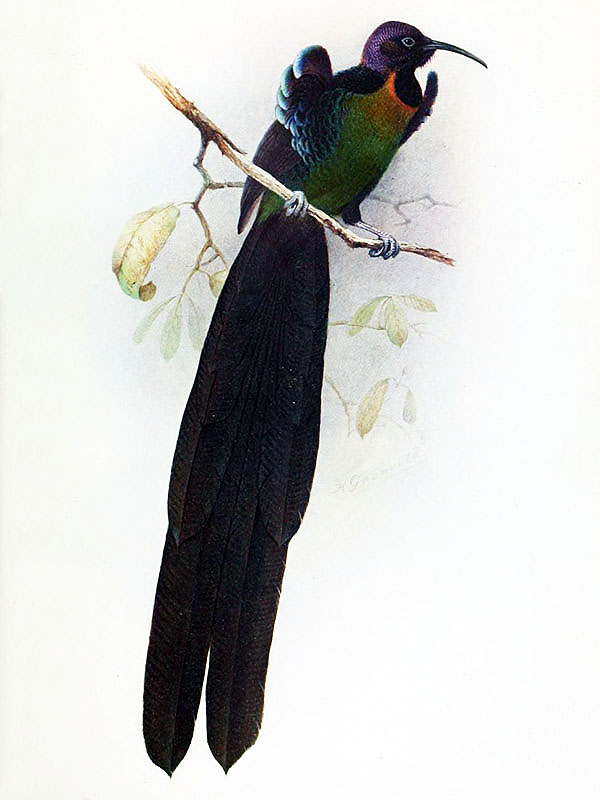
********************
Quelle:
[1] Clifford B. Frith; Bruce M. Beehler: The Birds of Paradise: Paradisaeidae. Oxford University Press 1998
********************
bearbeitet: 14.03.2021
While checking old papers regarding the enigmatic Divine Kingfisher from the island of Bora Bora, I found that the same paper mentions the existence of a lorikeet on the same island, well actually even two species of lorikeets, one being the Blue Lorikeet (Vini peruviana (Statius Müller)) and the other one being Kuhl’s Lorikeet (Vini kuhlii (Vigors)).
Or was it something else?
***
Well here are the original text passages.:
“On nous donna á Borabora une espèce vivante de perruche très-voisine du phigy de Levaillant …, peut-être encore plus voisine de la perruche fringillaire …, et que M. Vigors a décrite récemment … sous le nom de psittacula Kuhlii.
Cet oiseau, sur lequel nous fournirons de nouveaux détails dans la partie descriptive des espèces, a la langue terminée par un petit cercle de papilles nerveuses; ses habitudes sont vives et colériques, et son naturel sauvage.”
translated:
“We were given on Borabora a living species of parrot very close to the phigy of Levaillant …, perhaps even closer to the parakeet that Mr. Vigors has recently described … under the name of psittacula Kuhlii.
This bird, on which we will furnish new details in the descriptive part of the species, has the tongue terminated by a small circle of nerve papillae; his habits are lively and angry, and his temper is wild.”
and the second part:
“Cet oiseau a les narines en scissure et la langue terminée par un cercle de papilles longues, qu’on retrouve chez l’ Ari-manou. Il se nourrit de bananes, et son caractère est extrêmement colérique. Nous nous le sommes procuré dans l’île de Borabora.
Cette petite perruche à queue pointue a de longueur totale six pouces. Son bec et ses tarses sont orangés; le front est vert; les plumes de la tête et de l’occiput sont longues, étroites, d’un bleu céleste au sentre et frangées de noir sur les bords; les joues, le devant de la gorge et du cou, jusqu’au haut du ventre, sont d’un rouge vermillon mat: le milieu du ventre est aussi de ce même rouge, mais la région anale et les plumes des cuisses sont dún bleu pourpré. Le plumage est en entier d’un vert lustré clair, plus foncé et teint roussatre sur le manteau; la queue est jaune en-dessous et verte et jaune en-dessus. Les rémiges sont noires et vertes.”
translated:
“This bird has cracked nostrils and the tongue ends with a circle of long taste buds, found in the Ari-manou [?]. It feeds on bananas, and its character is extremely choleric. We obtained it on the island of Borabora.
This small parrot with a pointed tail has a total length of six inches [ca. 15,3 cm]. Its beak and tarsi are orange; the forehead is green; the feathers of the head and of the occiput are long, narrow, of a heavenly blue in the center, and fringed with black on the edges; the cheeks, the front of the throat and the neck, up to the upper part of the belly, are of a matt vermilion red: the middle of the belly is also of this same red, but the anal region and the feathers of the thighs are of a blue purple. The plumage is entirely lighter green, darker and reddish on the mantle; the tail is yellow below and green and yellow above. The flight feathers are black and green.”
***
Well, the description mostly fits with Kuhl’s Lorikeet, except for the color of the mantle (said to be darker and reddish; but is yellowish green in V. kuhlii), and the tail (said to be yellow below and green and yellow above; but is yellowish green and red in V. kuhlii).
So what do we have here?
Kuhl’s Lorikeet was once more widely distributed, this is a fact that is known, the bird inhabited mostly all of the Austral- and the Cook Islands, but what about the Society Islands?
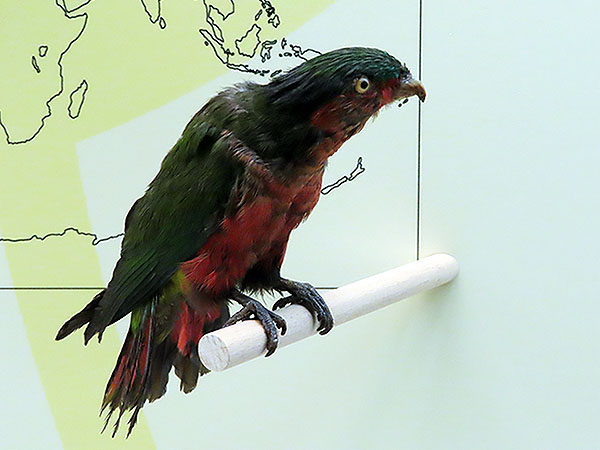
There are also some old oral traditions from the Society Island published in 1928, mentioning at least seven different kinds of parrots, some can be identified as well-known species, others can’t.
***
My guess is, the likeliest possibility is that this parrot from Bora Bora may represent a now extinct subspecies of Kuhl’s Lorikeet from the Society Islands.
***
There’s a little update here as well:
The following small account is found in G. R. Gray’s ‘ Catalogue of the birds of the tropical islands of the Pacific Ocean in the collection of the British Museum’.:
“CORIPHILUS KUHLII
…
‘Ari-manou’ of the natives of the Society Islands.
Society Islands (Borabora); Sandwich Islands.” [2]
I thus changed the name of the supposed bird in the headline.
*********************
References:
[1] Teuira Henry: Ancient Tahiti. Bishop Museum Bulletins 48: 1-651. 1928 [2] M. L. I. Duperrey: Voyage autour du monde: Exécuté par Ordre du Roi, Sur la Corvette de Sa Majesté, La Coquille, pendant les années 1822, 1823, 1824, et 1825, par M. L. I. Duperrey; Zoologie, par Mm. Lesson et Garnot. Paris: Arthus Bertrand 1828
[2] George Robert Gray: Catalogue of the birds of the tropical islands of the Pacific Ocean in the collection of the British Museum. London: printed by order of the Trustees 1859
*********************
edited: 05.01.2023
Swamphens (genus Porphyrio) are distributed worldwide (except of course Antarctica), five species are currently officially recognized. In my opinion there are actually more species, 11 to be exact, namely if the Purple Swamphen (species complex) is split into the distinct species which it actually consists of.
And then there are the extinct members including five described species and seven not-yet-described ones.
***
And … then there are the hypothetical ones … two so far, one of which I have already written about here:
The Tahitian Mountain Goose
The other one is way less mysterious and on the other hand much more mysterious, it is a swamphen from Ra’iatea, Society Islands.
The island of Ra’iatea lies 50 km east of Huahine, the home island of McNab’s Swamphen (Porphyrio mcnabiKirchman & Steadman), one of 12 the extinct swamphen forms known on the basis of subfossil bones only.
***
What do we actually known about the mysterious bird of today’s post?
Not much. There is a little note among a big listing of Polynesian (including Melanesian and Micronesian) birds, which says the following.:
„319.* Porphyrio sp.
Porphyrio sp. (Schmeltz), Cat. Mus. Godef. 1874 V, p. XVI; Garrett, 1. C. note.
Island of Raiatea, Society Is. (Garrett).
This species is known from two young specimens only.“ [1]
***
And that’s it.
I could not find out anything else.
But … the Australian Swamphen is known to be a trampy species and has colonized new Zealand only quite recently, maybe only after the colonization of the islands by the first Polynesians. The same species has also colonized parts of Oceania, where the ssp. pelewensis Hartlaub & Finsch has evolved in Palau and the ssp. samoensis Peale (including. ssp. vitiensis Peale) in western Polynesia.
So, the two Ra’iatean birds may in fact not have been collected on Ra’iatea at all but on another island, or they may have been taken there but may have originated from another place, maybe from Samoa, the closest place where swamphens still exist today.
… or the Ra’iatean birds were indeed a distinct subspecies or perhaps rather species that survived into the 19th century.
***
Here is a little update for this enigmatic bird.:
“Porphyrio porphyrio (L.), Talève poule-sultane.
La seule citation de l’espèce en Polynésie orientale est due à Wiglesworth (1891b) qui mentionne «Porphyrio species» à Raiatea d’apres deux spécimens immatures collectés par Andrew Garrett. Il semble que les spécimens aient disparu. Il est douteux qu’il s’agisse d’une erreur d’étiquetage car Garrett ne visita certainement pas les Samoa, ni d’autres îles de ‘ouest du Pacifique. Ces oiseaux étaient donc, soit des visiteurs de Samoa, soit les représentants d’une population vivant autrefois à Raiatea et éteinte depuis longtemps.” [2]
translation:
“Porphyrio porphyrio (L.), Purple Swamphen.
The only quotation of the species in Eastern Polynesia is due to Wiglesworth (1891b) which mentions «Porphyrio species» in Raiatea according to two immature specimens collected by Andrew Garrett. The specimens appear to have disappeared. It is doubtful that this was a labeling error because Garrett certainly did not visit Samoa or other islands in the western Pacific. These birds were therefore either visitors from Samoa or representatives of a population formerly living in Raiatea and extinct for a long time.“
*********************
[1] Lionel K. Wiglesworth: Aves polynesiae: a catalogue of the birds of the Polynesian subregion (not including the Sandwich Islands). Berlin: R. Friedlaender & Sohn 1891 In: Abhandlungen und Berichte des Königl. Zoologischen und Anthropologisch-Etnographischen Museums zu Dresden Bd. 3: 1-84. 1890/91. herausgegeben von Hofrath Dr. A. B. Meyer, Director des Museums
[2] D. T. Holyoak; J.-C. Thibault: Contribution à l’étude des oiseaux de Polynésie orientale. Mémoires du Muséum national d’histoire naturelle 127(1): 1-209. 1984
*********************
edited: 10.03.2020
Ohrentaube (Columba auricularis Temminck & Knip)
Erst kürzlich, also heute (10.03.2020), habe ich zum ersten Mal von dieser Taube gehört, was ist über diesen Vogel bekannt?
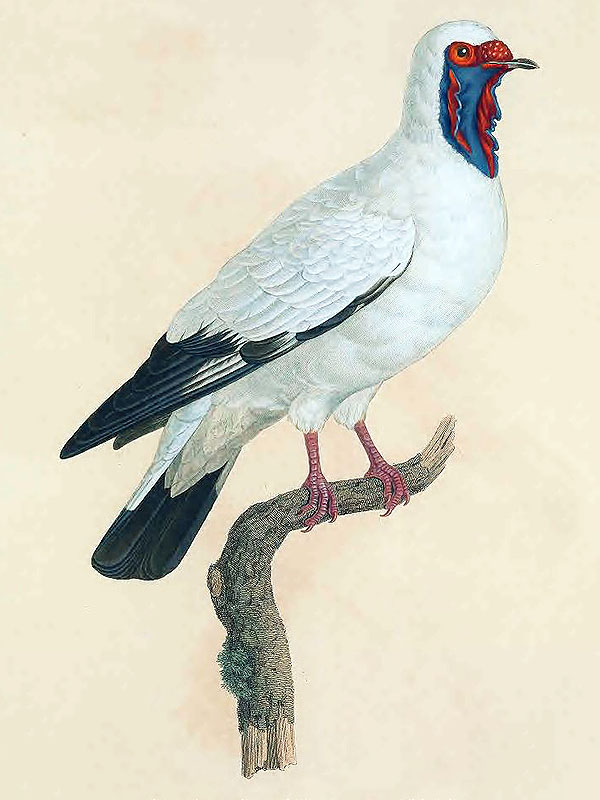
Nun, lesen wir (einen Teil) der Beschreibung.:
“Nous avons vu une variété entièrement blanche qui n’avoit du noir que sur la queue; d autres avoient le plumage plus ou moins marqué de taches grises et noires : ces derniers nous ont paru être de jeunes oiseaux. Les pieds sont constamment d’un beau rouge, et le bec est noir.
Nous présumons que l’Oricou habite les îles de la mer Pacifique, c’est du moins par des vaisseaux venant de ces parages que quelques individus ont été rapportés en Angleterre. Le Pigeon qui a servi de modèle à notre planche coloriée est déposé dans le cabinet de M. Raye de Breukelerwaert à Amsterdam. Cet amateur possède aussi la variété de cette espèce, dont les ailes sont entièrement blanches.” [1]
Übersetzung:
“Wir sahen eine völlig weiße Form, die nur am Schwanz schwarz war; andere hatten ein mehr oder weniger ausgeprägtes Gefieder mit grauen und schwarzen Flecken: Dies schienen uns junge Vögel zu sein. Die Füße sind durchgehend schön rot und der Schnabel ist schwarz.
Wir gehen davon aus, dass der Oricou auf den Inseln des Pazifischen Ozeans lebt, es wurden jedoch weniger Exemplare von Schiffen aus diesen Gebieten als in England gemeldet. Die Taube, die als Modell für unsere Farbtafel diente, befindet sich im Kabinett von Herrn Raye de Breukelerwaert in Amsterdam. Dieser Amateur hat auch eine Variante dieser Art, deren Flügel völlig weiß sind.“
Die Beschreibung basiert eindeutig auf einem ausgestopften Exemplar, und der erste und der letzte Satz sind besonders interessant … aus Gründen …
***
Der Vogel wird auch in einem anderen Werk erwähnt.:
“Note. – The Columba auricularis, Temm. Pig. t. 20,
…
is said to inhabit some of the islands of the Pacific Ocean; and others have more particularly given the Friendly Islands [Tonga] as the abode of this bird; but it is only an artificial production of some ingenious bird-preserver.” [2]
Übersetzung:
“Anmerkung. – Die Columba auricularis, Temm. Pig. t. 20,
…
soll einige der Inseln des Pazifischen Ozeans bewohnen; und andere haben insbesondere die Freundschaftsinseln [Tonga] als Wohnsitz dieses Vogels angegeben; aber es ist nur ein Kunstwerk eines genialen Präperators.“ [2]
Ah, da ist es: Das Colombe Oricou war offenbar eine der vielen erfundenen Tierarten, die in Museums- und Privatsammlungen auf der ganzen Welt aufbewahrt, von äußerst talentierten Präparatoren hergestellt und als äußerst seltene Exemplare zu höchsten Preisen verkauft wurden – eine Praxis die früher durchaus üblich war.
***
Bleibt nur noch die Frage: Um welche Vögel handelt es sich hier? Der Körper könnte der einer gewöhnlichen Wildtaube gewesen sein, und die nackten Teile könnten tatsächlich nur gerupft und nachträglich bemalt worden sein.
Das ist auch schon alles.
***
Ein kleines Update hierzu.:
Und … zum Beweis, dass es von dieser frei erfundenen Vogelarten tatsächlich mindestens ein Präparat gegeben hat ….:

*********************
Quellen:
[1] Pauline Knip: Les pigeons, par Madame Knip, née Pauline de Courcelles, le texte par C. J. Themminck. Paris: chez Mme. Knip 1838-1843
[2] George Robert Gray: Catalogue of the birds of the tropical islands of the Pacific Ocean in the collection of the British Museum. London: printed by order of the Trustees 1859
*********************
edited: 19.04.2024
Hi there!
While reading some stuff in my ‘reed warbler book’ [3] last night, I suddenly remembered that there was a sighting or rather a ‘hearing’ of a reed-warbler on an island where no such reed-warbler was known to exist, and I was quite sure that this was one of the Cook Islands but could not find any mention of it.
But then i found it and it was one of the Austral Islands, namely Raivavae, where a reed warbler was recorded in 1968, and it was apparently indeed not seen but heard only, but it was at least identified as being a reed-warbler.
The island of Raivavae has no surviving endemic land bird species today, but of course did have some of them in the past, among them very, very, veeery likely also a reed-warbler species, and in my humble opinion this appears to have survived until the mid 20th century at least.
***
So, I’ve checked my ‘usual suspects’ and found some furter informations, but not really that much, unfortunately.
Te Manu: Bulletin de la Société d’Ornithologie de Polynésie. Nr 24. September 1998:
“Une espèce non identifiée d’Acrocephalus a été notée à Raivavae en 1968 mais n’a pas été retrouvé en 1990 (Seitre et Seitre 1991) et pouvait donc être un oiseau erratique.“
translation:
“An unidentified species of Acrocephalus was recorded at Raivavae in 1968 but was not found in 1990 (Seitre and Seitre 1991) and could therefore be an erratic bird.“
This record obviously is mentioned by D. T. Holyoak and J.-C. Thibault in 1984 [1] but I was not able to read it myself, however, I’m rather convinced that the ‘erratic bird’ more likely is meant to be what in German is called a “Irrgast”, a migratory bird that appeared on the island inadvertently while flying from one point to another.
But are there migratory reed warblers flying over the Austral Islands? No, because if they fly from north to south or back, they just do not cross the middle of the Pacific Ocean since the migratory reed-warbler species only inhabit the continents of the ‘Old World’ and those inhabiting the Polynesian islands do not migrate, as far as I know.
***
In chapter 7 of David W. Steadman’s ‘Extinction and Biogeography of Tropical Pacific birds’ from 2006 [2] it is mentioned as Acrocephalus vaughani and as a ‘M, modern record’ from Raivavae. How could I actually miss that until today?
****
I personally are rather sure that this single record from the island of Raivavae is indeed the last record of a former existing population of native, probably endemic, Raivavae Reed-Warblers which now join the ever-growing list of extinct taxa.
***
Here is a little update, in the meantime I was able to finde the original work by D. T. Holyoak and J.-C. Thibault from 1984.:
“A. v. sous-espèce ?
Raevavae: des fauvettes furent entendues par Lacan (J.-L. Mougin, comm. pers.) en mai 1968.” [1]
translation:
“A. v. subspecies?
Raevavae: warblers were heard by Lacan (J.-L. Mougin, pers. comm.) in May 1968.“
*********************
References:
[1] D. T. Holyoak; J.-C. Thibault: Contribution à l’étude des oiseaux de Polynésie orientale. Mémoires du Muséum national d’histoire naturelle 127(1): 1-209. 1984
[2] David W. Steadman: Extinction and Biogeography of Tropical Pacific Birds. University of Chicago Press 2006
[3] David Pearson; Peter Kennerly: Reed and Bush Warblers. Christopher Helm 2009
*********************
edited: 10.03.2020
The Osprey (Pandion haliaetus (L.)) is a highly specialized bird of prey that is distributed almost around the whole world except for Antarctica, and it was once even more widespread and occurred as far east as western Polynesia.:
The Osprey still ocurs on New Caledonia, but not further east, however, it formerly did and it is known to have occurred on the Tongan Islands on the basis of subfossil bones of adult and juvenile birds that were found in several archaeological sites on the islands of Ha’ano and ‘Uiha in the Ha’apai Islands group in the middle of the Tongan Islands chain. [2]
***
“PANDION HALIAETUS (?).
Falco haliaetus, Forst. Descr.* &c. p. 257.
Isle of Pines (Island of Spruce Trees); Tonga Islands (Tongatabu or Tonga Island).” [1]
Is it possible that this Tongan form has survived into the early 19th century?
*********************
References:
[1] George Robert Gray: Catalogue of the birds of the tropical islands of the Pacific Ocean in the collection of the British Museum. London: printed by order of the Trustees 1859
[2] David W. Steadman: Extinction and Biogeography of Tropical Pacific Birds. University of Chicago Press 2006
*********************
edited: 10.03.2020
This time, just to try if it is possible to ‘shoot’ through a dirty window …
Yes, it is.:
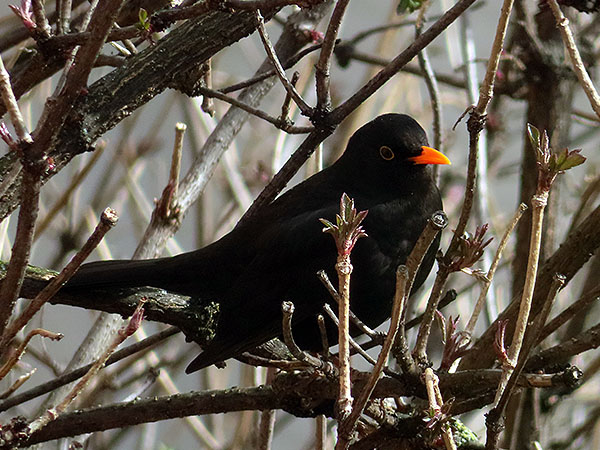
We used the little sunshine today ….
A Carrion Crow along the way was playing with- or trying to eat a walnut.
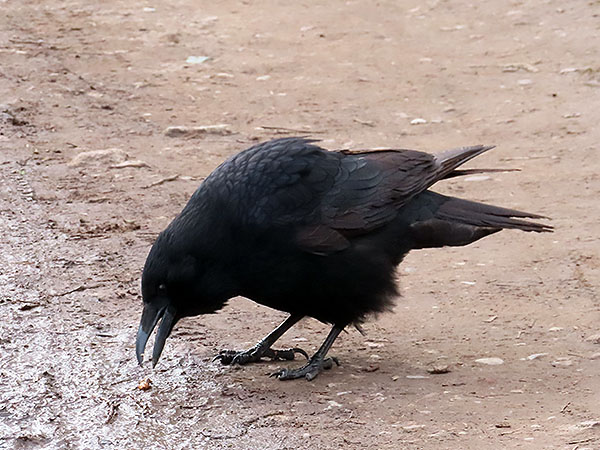
Along the river we saw at least three herons, two of them were wearing their breading plumage which differs by the redder beak and the blue instead of yellow skin around the eye.
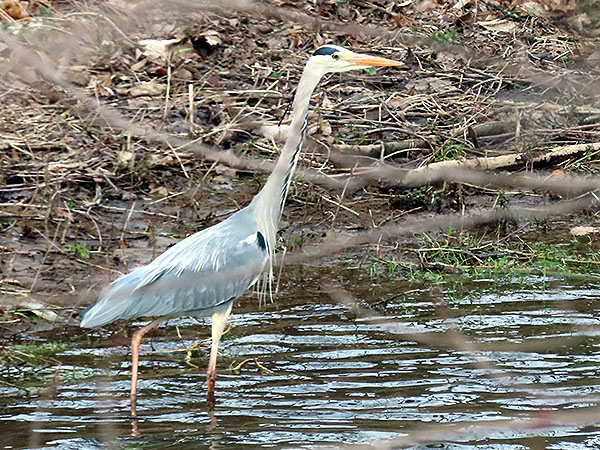

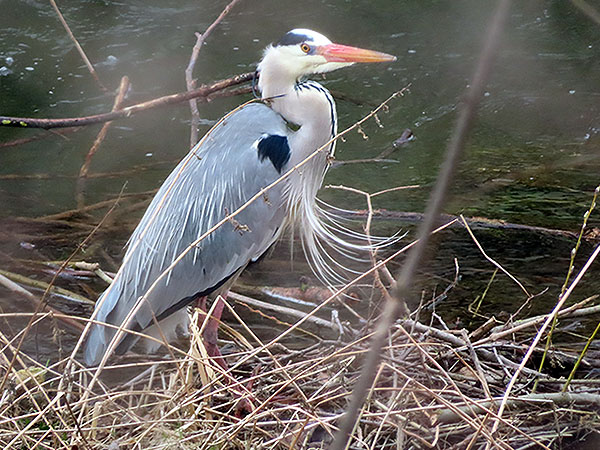
A tiny Blue Tit was willing to be photographed, however, I could get only one photo … well, better than nothing. 🙂
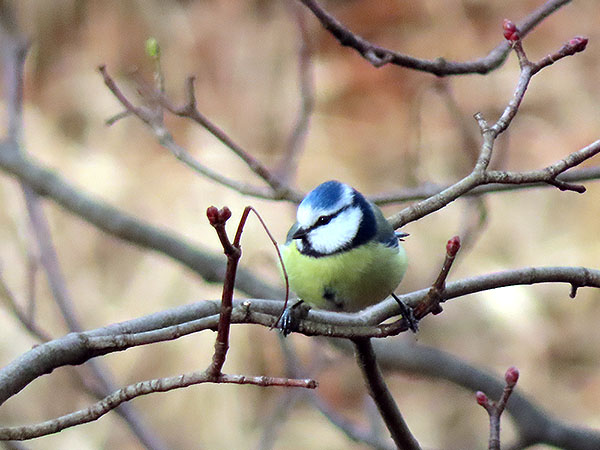
“The most mysterious of all the Pacific waterfowl is Coues’ Gadwall, Anas strepera couesi, only two specimens of which have ever been found, on Washington Island, more than six hundred miles south of Hawaii. The two specimens, the male type and a female, collected in 1874, are now in the U.S. National Museum in Washington. In appearance these birds are simply Gadwalls reduced to about two-thirds normal size. The plumage too is rather dull and somewhat unfinished-looking. Washington Island is a marshy place only a few miles long, with a small brackich lake near the centre and a fringe of palms. Since he original pair of birds were discovered, several expeditions have stopped at the island, but no one has ever seen Coues’ Gadwall again. Speculation is perhaps unprofitable, but sometimes it is irresistible. I often like to wonder how these birds ever came to Washington Island. It is my guess, for what it is worth, that these two specimens represent the last of a very small inbred breeding population of true Gadwalls which by an accident of migration had become established on the island. I suspect that their size and coloration are due to environment and inbreeding rather than to any genetic change.“ [4]
This account summarizes quite well what’s known about this bird.
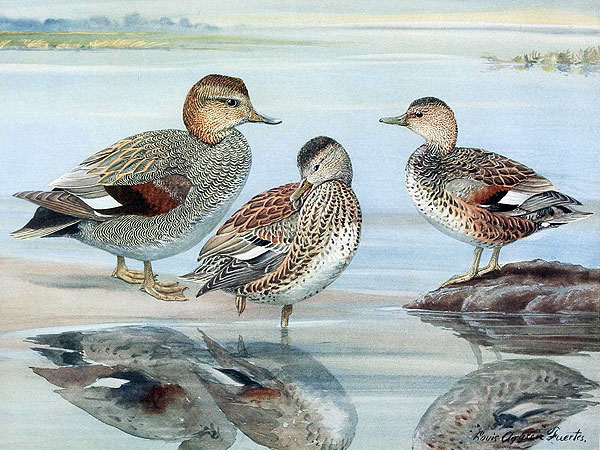
***
Then there are some strange accounts, or rather misinterpretations of accounts, let’s start with one that is rather less known, and speaks of the occurence of a form of gadwall on the Society Islands.:
“Forster met with a species of Gadwall on the Society Islands and identified it with A. strepera Linn. It is much more likely that is was C. couesi, for the range of that species doubtless extends beyond Washington Island, the only locality as yet known for it.” [2]
I read this original account by J. R. Forster, which is completely in Latin, and which merely is a enumeration of species, the duck is mentioned here just as “Anatem streperam“, that’s all, and this account almost for sure refers to the Pacific Black Duck (Anas superciliosa Gmelin), which occurs on the Society Islands, and which is not separately mentioned here … and in fact, Forster mentiones “Anas strepera” again in an enumeration of birds he describes from New Zealand, this also clearly refers to the Pacific Black Duck! [1]
***
Then there’s another account in a German book, which again is refering to an account in James C. Greenway’S “Extinct and vanishing birds of the world” from the 1960s.:
“Interessant ist eine weitere Bemerkung desselben Autors, wonach nach Angaben von Ripley ein auf den Tuamotu-Inseln gefundenes Entenkücken sich bei Erreichen der Geschlechtsreife als Schnatterente herausstellte.”
translation:
“Interesting is another comment of the same author [J. C. Greenway], based on which according to Ripley a duckling found on the Tuamotu islands, when reaching maturity, turned out to be a gadwall.” [6]
***
Okay … after purchasing J. C. Greenway’s book, which took me ages again, I can now proudly present you this abovementioned account by the ominous Ripley.:
“But, on the other hand, Dr. S. Dillon Ripley tells me that a duckling taken on the Tuamotu Islands was raised by Charles Nordhoff at Tahiti. When it reached maturity it turned out to be a gadwall.” [5]
That’s all, we actually deal with hearsay, an account of an account of someone who claimes to have caught a duckling on one of the Tuamotu Islands (these are actually the largest island group in the world consisting of no less than 76 atolls, just by the way ….) without naming the island in question.
However, given the geographic position of Washington Island/Teraina, a former occurence of this bird on the Tuamotu Archipelago makes much more sense than on the Society Islands.
***
But now let’s take a look on what these two persons, Dr. S. Dillon Ripley and Charles Nordhoff, have to tell; we start with Mr. Ripley …:
“It sometimes happens that migrating Ducks plummet down on to isolated islands in the Pacific. Mr. Charles Nordhoff told me once that a schooner captain inbound to Tahiti from Flint island, an isolated rock pinnacle three hundred miles or more north towards Hawaii from the Society Islands, brought him a duckling which he had picked up on the island. Mr. Nordhoff was able to raise the bird, and found that it was a Pintail, presumably from wild parents. If Pintails can fly so far south of Hawaii where they are in the habit of wintering, there seems no reason why Gadwalls should not be able to do the same thing.” [4]
… and go on with Mr. Nordhoff.:
“In his article in the Waterfowl number of the AVICULTURAL MAGAZINE, Dillon Ripley mentions a duckling I received some years ago from Flint Island, which when reared proved to be a fine male Pintail. I believe that a good many stray Ducks from the Northern Hemisphere land on the Pacific Islands, and occasionally, as Ripley suggests in the case of Coues’ Gadwall, give rise to a sedentary and eventually inbred race. I have reliable information that Shovelers in winter plumage have vistited both the Marquesas and the Tuamotu on several occasions, and that Pintail have been seen on Atiu in the Cook Group, south-west of Tahiti.” [3]
Well, well, so the Tuamotu Islands suddenly has changed into Flint Island, which in fact is not a part of the Tuamotu Archipelago but of Kiribati – and – the duckling that was supposed to turn out being a Gadwall was in fact a Pintail (Anas acuta L.), a completely different species of duck!
After all, we are left with probably more questions than answers.
*********************
References:
[1] Johann Reinhold Forster; Hinrich Lichtenstein: Descriptiones animalium quae in itinere ad Maris Australis terras per annos 1772, 1773 et 1774 suscepto. Berolini: Ex Officina Academica 1844
[2] Lionel K. Wiglesworth: Aves polynesiae: a catalogue of the birds of the Polynesian subregion (not including the Sandwich Islands). Berlin: R. Friedlaender & Sohn 1891 In: Abhandlungen und Berichte des Königl. Zoologischen und Anthropologisch-Etnographischen Museums zu Dresden Bd. 3: 1-84. 1890/91. herausgegeben von Hofrath Dr. A. B. Meyer, Director des Museums
[3] Charles Nordhoff: Notes on the birds of Tahiti. The Avicultural Magazine ser. 5. 8(5): 119-120. 1943
[4] Dillon Ripley: Pacific Waterfowl. The Avicultural Magazine ser. 5. 8(3): 67-70. 1943
[5] James C. Greenway, Jr: Extinct and vanishing birds of the world. Dover Publications, 2nd Edition 1967
[6] Dieter Luther: Die ausgestorbenen Vögel der Welt. Westarp Wissenschaften 1986
*********************
edited: 28.02.2020
While researching some accounts reffering to the Washington Island Gadwall (Mareca strepera ssp. couesi Streets), I stumbled accros a footnote that made me wonder … a bit at least.:
“The native birds of Tahiti are in a sad state; the Porphyrio is extinct, as is the small grey, Thrush-like Omaomao [Tahiti Reed-Warbler (Acrocephalus caffer (Sparrman))], famous for its beautiful song, and the magnificent large Fruit Pigeon [Polynesian Imperial-Pigeon (Ducula aurorae (Peale))], of which a few existed as late as 1920.” [1]
Well, aside the fact that the name “Omaomao” is rather applied to the Garrett’s Reed-Warbler (Acrocephalus musae ssp. garretti (Holyoak & Thibault)), the Tahiti Reed-Warbler is still alive.
What amazes me is that the author mentiones the term “Porphyrio” in a absolutely casual way, and this certain author, Charles Nordhoff, knew what a Porphyrio is, he kept six New Zealand Swamphens (Porphyrio melanotus (Temminck)) in the garden of his house while living on the island of Tahiti.
***
There is furthermore a painting by Paul Gaugin, made in 1897 during a stay on Tahiti, it is called “Vairumati” (see below) and shows a female islander sitting on a chair and to her left a strange-looking white bird that very much reminds on a swamphen.
I personally do not think that Gaugin painted a real bird here because the same bird appears in several of his paintings, always in the same pose, differing only in the coloration.
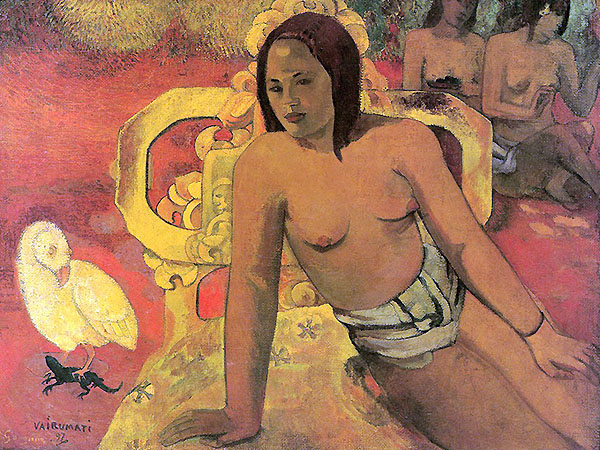
***
It nevertheless is almost certain that a swamphen species once inhabited the island of Tahiti, and that additional species inhabited all of the other Society islands, however, the only true evidence for that assumption are the subfossil remains of McNab’s Swamphen (Porphyrio mcnabi Kirchman & Steadman) found on the island of Huahine.
I only somehow doubt that this Tahiti Swamphen disappeared only around the 1940s … but, who knows.
*********************
References:
[1] Charles Nordhoff: Notes on the birds of Tahiti. The Avicultural Magazine ser. 5. 8(5): 119-120. 1943
*********************
edited: 27.02.2020
Duivenbodes Sechstrahliger Strahlenparadiesvogel (Parotia duivenbodei Rothschild)
Auf den ersten Blick sieht dieser Vogel wie ein typischer Strahlenparadiesvogel aus, der einen glänzenden Brustschild und längliche, fadenförmige Hinterhaupt’fähnchen’ trägt. Er hatte jedoch nur zwei von ihnen anstelle der üblichen sechs, so dass sein Trivialname eigentlich eher Duivenbodes zweistrahliger Strahlenparadiesvogel sein sollte.
Die Form ist anhand von zwei männlichen Exemplaren bekannt und wurde als Hybrid des Kragenparadiesvogel (Lophorina superba (J. R. Forst.)) und des Arfak-Strahlenparadiesvogel (Parotia sefilata (Pennant)) identifiziert.
*********************
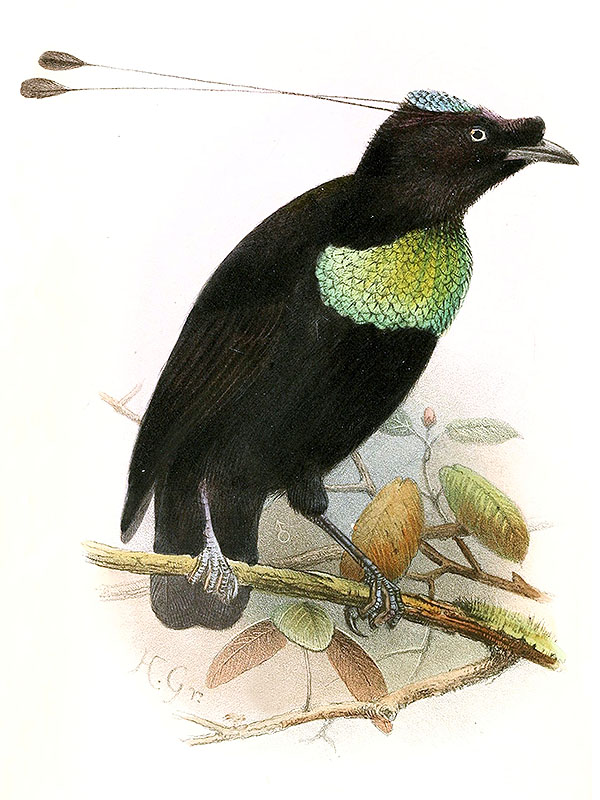
*********************
Quelle:
[1] Clifford B. Frith; Bruce M. Beehler: The Birds of Paradise: Paradisaeidae. Oxford University Press 1998
*********************
bearbeitet: 14.03.2021
Le Nébuleux (Nebulöser Fadenhopf)
Dies könnte der erste Teil einer kleinen Serie sein ….
Le Nébuleux oder der Nebulöse ist nur anhand zweier Gemälde von Jacques Barraband in François Le Vaillants “Histoire naturelle des Oiseaux de Paradis et des Rolliers” aus dem Jahr 1806 bekannt, die sehr wahrscheinlich ein einzelnes Exemplar in zwei verschiedenen Positionen zeigen. Es ist bekannt, dass Jacques Barraband absolut genau war, daher muss der von ihm dargestellte Vogel existiert haben und tatsächlich exakt wie in seinen Darstellungen ausgesehen haben.
Das Exemplar ist ganz klar ein Fadenhopf (Seleucidis melanoleuca (Daudin)), jedoch mit nur neun (oder zehn?) Anstelle von zwölf ‘Fäden’ und mit einer schwarz- statt gelb gefärbten Unterseite; seine weibchenähnlich braun gefärbten Flügel weisen darauf hin, dass es sich um einen subadulten Vogel handelte. [2]
Der Nebulöse könnte derselbe gewesen sein wie Bruijns Reifelvogel (Craspedophora bruyni Büttikofer) alias Mantous Reifelvogel (Craspedophora mantoui Oustalet), welche beide Hybriden des Prachtparadiesvogels (Ptiloris magnificus Vieillot) und des Fadenhopfes sind. [2]
Diese Form wurde nie wissenschaftlich beschrieben und trägt daher auch keinen wissenschaftlichen Namen.
*********************
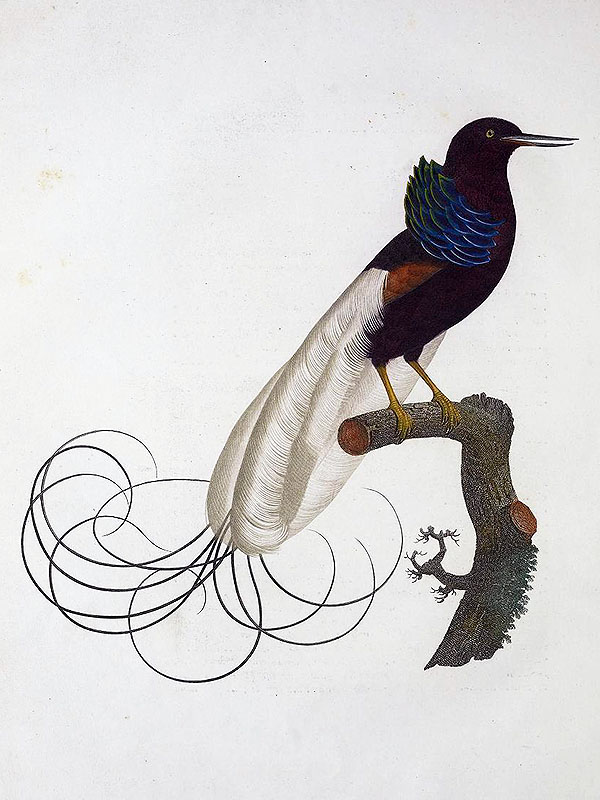
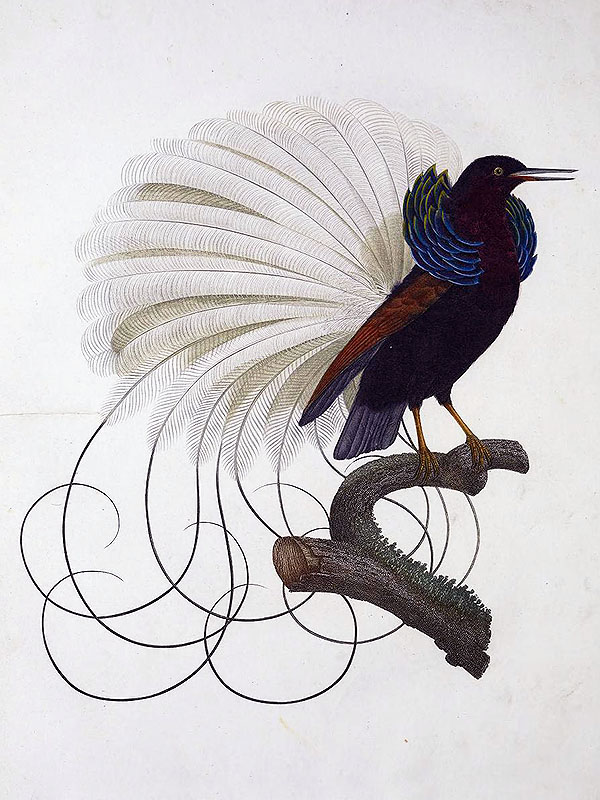
*********************
Quellen:
[1] François Le Vaillant: Histoire naturelle des oiseaux de paradis et des rolliers: suivie de celle des toucans et des barbus. Paris: Chez Denné le jeune, Libraire, rue Vivienne, n°. 10. & Perlet, Libraire, rue de Tournon 1806
[2] Clifford B. Frith; Bruce M. Beehler: The Birds of Paradise: Paradisaeidae. Oxford University Press 1998
*********************
bearbeitet: 14.03.2021
This is actually a undetermined cardinal, a member of the family Cardinalidae and thus not a real finch in the general sense … I need a picture of such a ‘thing’ for something I plan to write about, but I don’t want to say anything further now.

********************
edited: 20.02.2020
Today we have been in the Botanical Garden of Jena, some kilometers from home, I wanted to try to ‘catch’ some birds with my camera.
I was able to get a little Robin.:
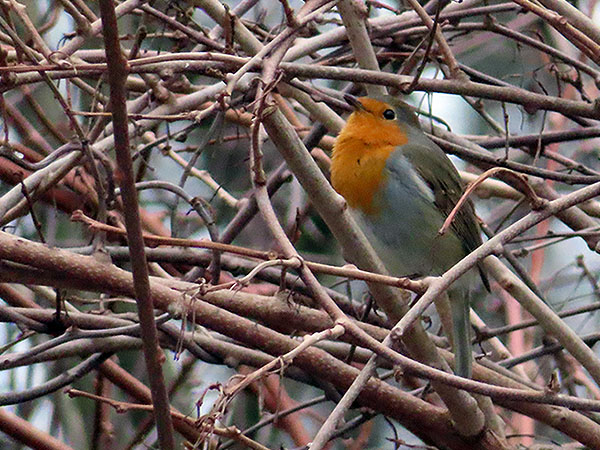
I also got two Blackbirds, a female and a male.
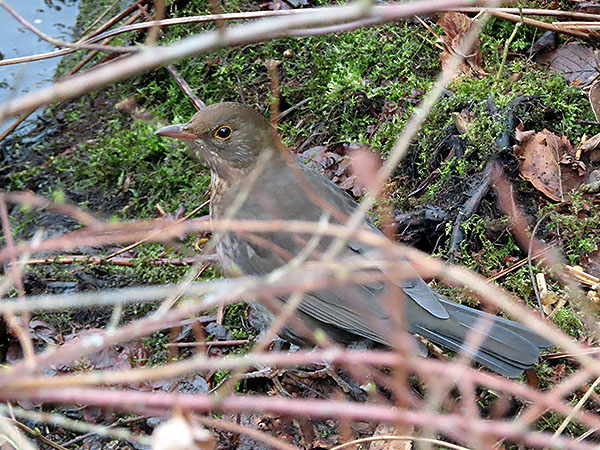

It is astonishingly warm these days – thanks to global warming.
*********************
edited: 01.02.2020
This guy stood in the water of the flood ditch and offered himself as a motive for me to try out my new camera ….
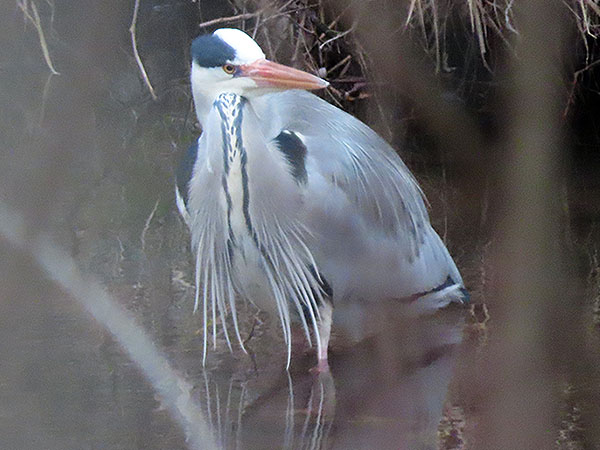
*********************
edited: 29.01.2020
The blog has moved, again, I hope this time it will be for good ….
I wanted to take a break from the strenuous work of logging on, uploading, and, and, and with two small trips outside to freak out relax and freshen up when suddenly this little colorful thing flew in front of my cell phone lens.
The cell phone photo of course was completely useless, so I decided to go back home, catch my camera and to try my luck … maybe the little bird might come back?
It did indeed. 😛
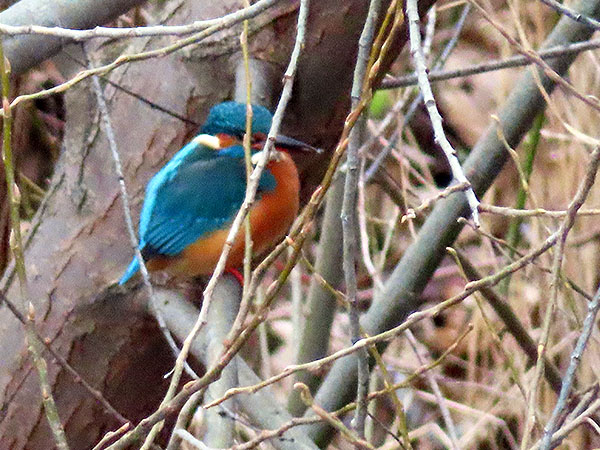
The place where I photographed the kingfisher is quite busy, and of course various passers-by had to check what I was probably doing there … hm, of course none of them could see what I saw.
Yah!
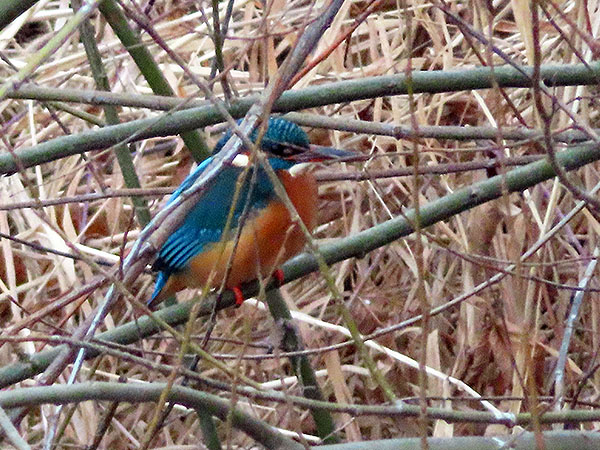
*********************
edited: 29.01.2020
Remiornis heberti Lemoine, ein rätselhafter Ratit aus dem oberen Paläozän, der wahrscheinlich nicht näher mit den heutigen Straußen verwandt war.
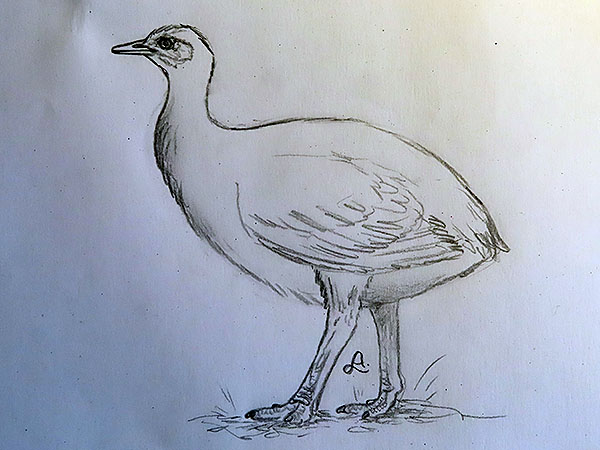
Der Vogel ähnelte wohl am ehesten einem plumpen Tinamu und war wohl flugunfähig.
*********************
bearbeitet: 25.12.2019
This is a small bird from the Eocene of Wyoming, USA, it was only about 10 cm long and is so far known from a complete skeleton with most of the feathers preserved as well.
The bird is not yet described but is apparently currently under study, it may turn out to be related to Morsoravis sedilis Bertelli, Lindow, Dyke & Chiappe, and to belong into a new family, probably named the Morsorornithidae or alike, which then again are perhaps somehow related to the mousebird/parrot/songbird ‘orbit’.
The reconstruction shows it while somewhat stretching its left wing, it was ‘fun’ to draw all this wing feathers, and I probably will do that NEVER EVER AGAIN!!! 😉
*********************

*********************
A little update here:
This bird is now apparently included into the genus Morsoravis. [2]
*********************
References:
[1] Lance Grande: The Lost World of Fossil Lake: Snapshots from Deep Time. University of Chicago Press 2013
[2] Daniel T. Ksepka; Lance Grande; Gerald Mayr: Oldest finch-beaked birds reveal parallel ecological radiations in the earliest evolution of passerines. Current Evolution 29(4): 657-663. 2019
*********************
edited: 07.12.2019
This tiny thing could be called the „Cretaceous Nicobar Pigeon“, it had somewhat elongated neck feathers, the typical short tail, or rather a not-a-tail-at-all tail so typical for many of those strange Cretaceous enantiornithine birds that we now already know.
The strange-feathered creature comes from China, where it lived some 130 Million years ago in the late Early Cretaceous.
The genus name refers to its crural feathers (bird trousers) which are actually found in many birds, but here they are shaped like nothing ever seen before, maybe like a thin sheet of ceratin with a chewed end, or brush-like end, not at all like a feather. The species name again refers to its multi-toothed beak.
*********************
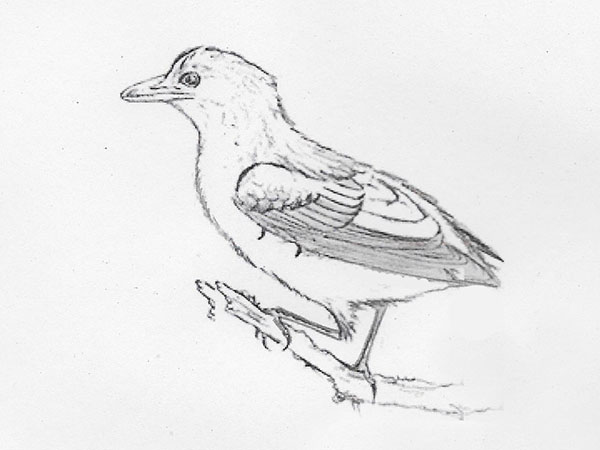
The bird reached a size of about 10 to maybe 11 or 12 cm when fully grown. The body feathers appear to have been more hair- than feather-like, and they may have been dark, while those on its neck were somewhat elongated and apparently were even glossy [1] … why not.
***
Unfortunatly I could not find any plant species from the same place and time.
*********************
References:
[1] Min Wang; Jingmai K. O’Connor; Yanhong Pan; Zhonghe Zhou: A bizarre Early Cretaceous enantiornithine bird with unique crural feathers and an ornithuromorph plough-shaped pygostyle. Nature Communications 8: 1-12. 2017
*********************
edited: 19.11.2019
This tiny bird is thought to be the ancestor of the kingfishers or of the todies, or of both.
Quasisyndactylus longibrachis was very small, only about 10 cm long, its legs were quite long, very much like in today’s todies (Todidae) and its feet were syndactyl (that means two of the toes, toes 3 and 4, are fused together), like those of all known Coraciiformes showing that it was a member of that order.
The species is known from several specimens, some of which also still harbor their feathering, showing that this species had rather roundish wings and a rather long tail.
*********************
References:
[1] G. Mayr: „Coraciiforme“ und „piciforme“ Kleinvögel aus dem Mittel-Eozän der Grube Messel (Hessen, Deutschland). Courier Forschungsinstitut Senckenberg, Band 205. 1998
*********************
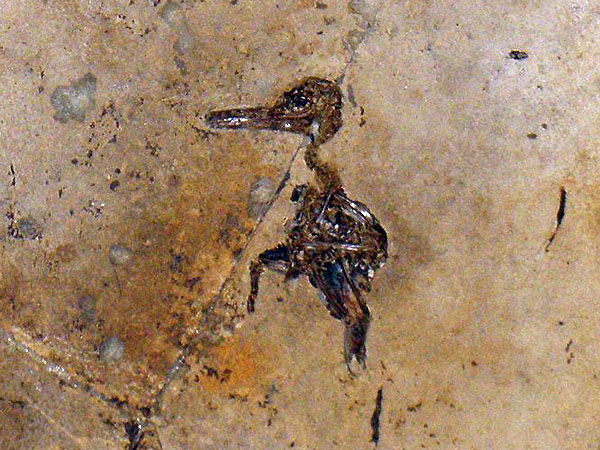
*********************

*********************
edited: 05.11.2019; 06.11.2019
Here I want to write a bit about two enigmatic birds that allegedly both were collected in Africa at the beginning of the 19th century; these are Adanson’s Bee-eater and Latreille’s Bee-eater.
*********************

Adanson’s Bee-eater is an enigmatic bird known only from a single specimen which is commonly thought to have been an artificially specimen, assembled from several bird parts, a practice that was rather common in these olden days when collectors were keen to have in their collections the most rare exhibition pieces.
The following French texts are all from François Le Vaillant, they describe this ’species‘ and give us some additional information about its wehereabouts. [1]
„Ce guêpier à queue en flèche ayant été méconnu par Buffon qui l’a, donné comme une simple variété de climat de son guêpier marron et bleu, ou de l’Isle-de-France, espèce que nous avons décrite dans notre précédent n°, sous la dénomination de guêpier Latreille, nous avons dû encore lui donner un nom distinctif, et nous ne pouvions à cet égard mieux faire, je pense, que de choisir celui du célebre voyageur qui l’ayant rapporté du Sénégal, l’a le premier fait connoître en Europe. Il suffira, je pense, de comparer les figures exactes que nous avons publiées de ces deux oiseaux, pour être d’abord et du premier coup-d’œil convaincu de la méprise de Buffon à leur égard, et être persuadé enfin qu’ils forment deux espèces très distinctes, bien loin de n’être l’un qu’une variété de l’autre; on ne conçoit même pas, en voyant les figures qui représentent dans les planches enluminées de Buffon ces deux oiseaux, l’un sous le nom de guêpier de l’Isle-de-France, n° 252, et l’autre, n° 314, sous celui de guêpier à longue queue du Sénégal, comment il a été possible de commettre cette erreur, et encore moins qu’elle ait été perpétuée par tous les ornithologistes qui ont écrit sur les oiseaux depuis Buffon. On conçoit en effet d’autant moins cette méprise, que ces deux figures, d’ailleurs très mauvaises , different bien plus l’une de l’autre encore, que ne différent réellement ces deux oiseaux eux-mêmes entre eux, mais assez cependant pour être bien sûr qu’ils ne peuvent être confondus ensemble comme appartenant à une seule et même espèce.„
translation:
„This spiny-tailed bee-eater was ignored by Buffon who gave it as a simple climate variety of its brown and blue bee-eater, or Isle-de-France [bee-eater], a species that we described in our previous issue. Under the denomination of Latreille, we have had to give it a distinctive name, and we could not, in this respect, have done better, I suppose, than the guide of the traveler who brought it back from Senegal, the first to make it known in Europe. It will suffice, I think, to compare the exact figures which we have published of these two birds, to be first and for the first glance convinced of Buffon’s mistake with regard to them, and to be finally persuaded that they form two very distinct species, far from being one variety of the other; it is not even conceivable, seeing the figures which represent, in the bright plates of Buffon, these two birds, one under the name of the Isle-de-France bee-eater, No. 252, and the other, No. 314, under that of long-tailed bee-eater from Senegal, how it was possible to make this mistake, let alone that it has been perpetuated by all the ornithologists who have written about birds since Buffon. This misunderstanding is all the less so conceived, that these two figures, which are, moreover, very bad, differ much more from one another than the two birds themselves really differ from one another, but enough, however, to be sure that they can not be confused as belonging to one and the same species.„
So, in short, these two birds were originally thought to be specifically identical, what they of course are not.
***
„Le guêpier Adanson est d’un tiers au moins plus fort que le guêpier Latreille, ainsi qu’on peut le voir d’ailleurs, en comparant les portraits de grandeur naturelle que nous en avons donné: il a le front ceint d’un large bandeau bleu qui, se prolongeant au-dessus des yeux, couvre les joues, les côtés et tout le devant du cou, la poitrine, et enfin tout le dessous du corps, en y comprenant les couvertures siqjéricures et inférieures de la queue, et le croupion; mais ce bleu s’affoiblit toujours davantage à mesure qu’il approche du bas-ventre; le dessus de la tête, à partir du bleu du front, ainsi que le derrière du cou, le manteau, les scapulaires, toutes les couvertures des ailes, et même les pennes de ces dernières, ainsi que toutes celles de la queue, sont couleur marron; seulement la partie excédante des deux pennes prolongées de la queue, ainsi que le bout des premières pennes des ailes, sont noirâtres; et les dernières plumes des ailes, proche le dos, sont en partie du même bleu que celui du dessous du corps; le bec est noir; les pieds sont bruns rougeàtres. Nous ignorons la couleur des yeux, n’ayant vu que la dépouille de cet oiseau, que je n’ai rencontré dans aucune des parties de l’Afrique dans laquelle j’ai pénétré; je n’ai même vu de cette espèce que le seul individu qu’en avoit rapporté Adanson du Sénégal, où il l’avoit recueilli durant ses voyages.„
translation:
„The Adanson bee-eater is at least a third stronger than the Latreille bee-eater, as can be seen elsewhere, by comparing the life-size portraits we have given: it has at its forehead a blue band which, extending above the eyes, covers the cheeks, the sides and all the front of the neck, the chest, and finally the whole underbody, including the undertail coverts of the tail, and the rump; but this blue becomes more and more feeble as it approaches the lower abdomen; the top of the head, from the blue of the forehead, as well as the back of the neck, the mantle, the scapulars, all the coverts of the wings, and even the feathers of these, as well as those of the tail, are colored brown; only the exceeding part of the two elongated feathers of the tail, as well as the end of the first primaries of the wings, are blackish; and the last feathers of the wings, near the back, are partly of the same blue as that of the underbody; the bill is black; the feet are reddish brown. We are ignorant of the color of the eyes, having seen only the remains of this bird, which I have not met in any part of Africa into which I have penetrated; I have not even seen of this species the only individual who had been brought back from Adanson of Senegal, where he had collected it during his travels.„
The author clearly states here that he did only see remains of this bird, but also that he did not see it at all, that is somewhat irritating to me.
But what was Adanson’s Bee-eater actually?
Well, the bird’s upper side looks almost exactly like that of the Southern Carmine Bee-eater (Merops nubicoides Des Mus & Pucheran) or the Northern Carmine Bee-eater (Merops nubicus Gmelin), the underside and forepart of the hea, however, come from another bird that, since the original specimen is now lost, will forever be unidentifiable.
*********************

Latreille’s Bee-eater, of which I won’t give any text because it isn’t really necessary, is said in its description to come from the Isle-de-France, known today as Mauritius but being far more widespread all over Africa. This ’species‘ might actually have been a Rufous-crowned Bee-eater (Merops americanus Statius Müller) or a Blue-throated Bee-eater (Merops viridis L.), both exclusively from Asia by the way. Again, the colors won’t fit completely, so again some parts of other birds might have been added to the depicted specimen. That was apparently a quite common practice in former times, the more rare and unique a specimen was the higher was its price ….
My personal conclusion is that both these ’species‘ never have existed.
*********************
References:
[1] François Le Vaillant: Histoire naturelle des promerops, et des guêpiers: faisant suite à celle des oiseaux de paradis par la même. A Paris, chez denné le jeune, Libraire, Rue Vivienne, N° 10. 1807
*********************
edited: 05.11.2019
Dieser tahitianische Papagei ist einer meiner Lieblingsvögel, leider existiert er aber nicht mehr da er durch eingeschleppte Säugetiere (Hunde, Katzen, Ratten) ausgerottet wurde.
Hier möchte ich zwei Darstellungen zeigen, die ich noch nicht kannte; beide stammen aus dem Jahr 1792 und wurden von Mitgliedern der Besatzung der HMS Providence angefertigt, die mit der Mission nach Tahiti gekommen war, Brotfruchtbäume und anderes botanisches Material vom Pazifik zu den Westindischen Inseln zu transportieren.
*********************
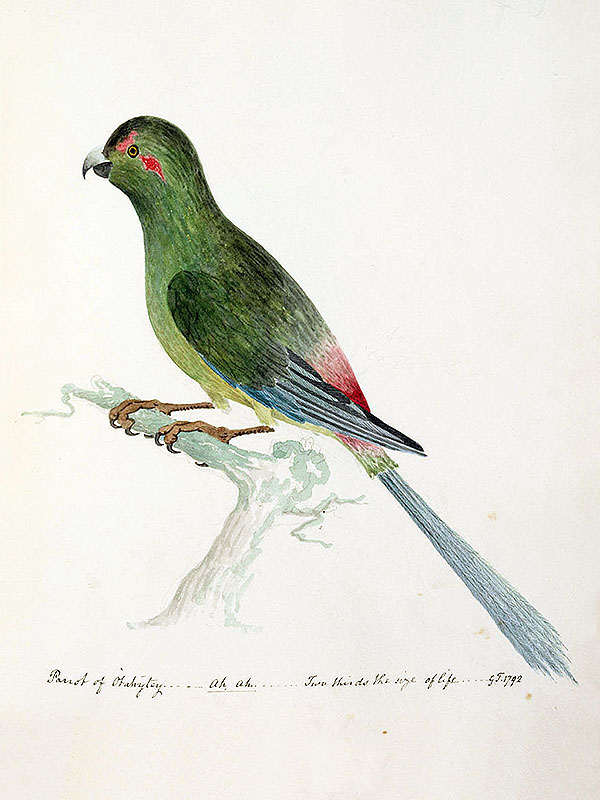
*********************
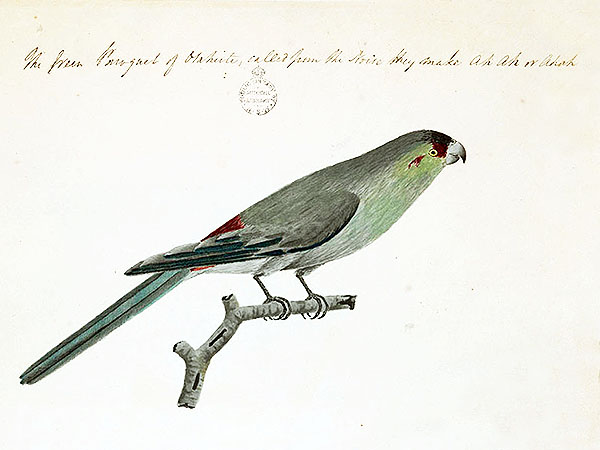
*********************
bearbeitet: 27.10.2019
Heracles inexpectatus, the unexpected Hercules, is a fossil parrot from the St. Bathans fossil site in New Zealand, that just has been described. [1]
The species is known from only two remains, or rather remains of remains to be more precicely, these are a partial left tibiotarsus and a partial right tibiotarsus, that’s just all. The species can be reconstructed as having reached a size of around 1 m, making it the largest known parrot species, dead or alive.
***
Unfortunately, one of the authors of this remarkable species apparently seem to think that the new find isn’t appetizing enough for the press, so added a „fierce beak“ to the description and is even speculating that this species, because of it’s size, must have been a predatory bird, which, of course, is complete bullshit.
According to the paper, the species apparently was a member of the Nestoridae, a family of parrots endemic to New Zealand, and within this family its closest relative appears to be the Kakapo (Strigops habroptilus Grey), a strict herbivor. So, I personally have no idea why one of the authors does such silly speculations.
Whatsoever … there was once a giant parrot rumbling the forests of New Zealand around 19 Million years ago, and that is remarkable enough, at least for me.
*********************
References:
[1] Trevor H. Worthy; Suzanne J. Hand; Michael Archer; R. Paul Scofield; Vanessa L. De Pietri
*********************
I need to write some kind of update here since the British- but also the German press apparently need to call this new species a “Cannibal” and a “Horror-Papagei”, and even claim that some scientist allegedly has suggested that this parrot was eating its smaller conspecific mates.
What a big load of shit, let’s say it together: “SHIT!!!” Which fucking scientist, as they claim, has ever said such a bullshit???
This was, and I bet my left hand for that, a large kakapo, nothing but a harmless, flightless, vegetarian creature, and the press apparently degenerates more and more to a shitpot full of idiots and arseholes.
Many Thanks!
*********************
edited: 08.08.2019
This species was described in 2010, it is known from five or six specimens found in the Messel shale, five of which include cervical vertebrae which again all bear strange small tubercles unknown in any other bird dead or alive.
The bird may or may not be related to the so-called screamers (Anhimidae), it had a quite small head compared to its body and had very large and strong wing bones, thus apparently was good at flying, its feet have short toes which appear to have been somewhat flattened – and my gut feeling tells me that they may have had been webbed ….
*********************

*********************
edited: 07.08.2019
This species was described in 2017, it is one of the many birds from the Messel shale, that are somehow related to living ones but on the other hand again … are completely different.
This one is thought to be related to the Charadriiformes, and it may indeed have been a member of the jacana family (Jacanidae).
*********************

*********************
BTW: I only recently learned that the age of the Messel shale spans from the upper Early – to the lower Middle Eocene.
So not every bird from there is from the Middle Eocene.
*********************
edited: 04.08.2019
Dieser rätselhafte Vogel aus dem späten Paläozän frühen Eozän Brasiliens ist nur von einem einzigen, zerbrochenen Tarsometatarsus bekannt, der jedoch offenbar den Kuckucken zugeordnet werden kann.
Ich kann nicht so viel über diesen Vogel sagen, er scheint für eine paläozäne Vogelart ziemlich groß gewesen zu sein, und es könnte tatsächlich ein echter Kuckuck gewesen sein oder es könnte etwas völlig anderes gewesen sein.
***
Ein kleines (längst überfälliges) update … diese Art wird mittlerweile mit der Familie Gracilitarsidae in Verbindung gebracht.
Der Vogel in meiner neuen Rekonstruktion ist immer noch ungefähr 15 cm lang und ungefähr ein Drittel größer als Gracilitarsus mirabilis Mayr, der einzigen anderen bekannten Art der Familie.

*********************
bearbeitet: 28.07.2019
MNT-11-7952 ist ein bemerkenswertes Fossil eines rätselhaften Vogels mit einer außergewöhnlichen Erhaltung; Abdrücke der erhaltenen Schwanzfedern weisen einen bläulich grauen Farbton auf, die Beine und Füße zeigen noch Spuren ihres Weichgewebes.
Dies ist jedoch alles, was bisher bekannt ist. Die beiden Platten enthalten nichts als den Arsch, sorry, den Rumpf, die Beine und die Schwanzfedern.
Die Federn sind sehr lang und schmal und erinnern an die Schwanzfedern der rezenten Mausvögel (Coliiformes). Die Füße scheinen jedoch anisodaktyl (drei Zehen nach vorn, eine nach hinten gerichtet) zu sein, im Gegensatz zu allen bekannten Mausvögeln, ausgestorben oder noch lebend.
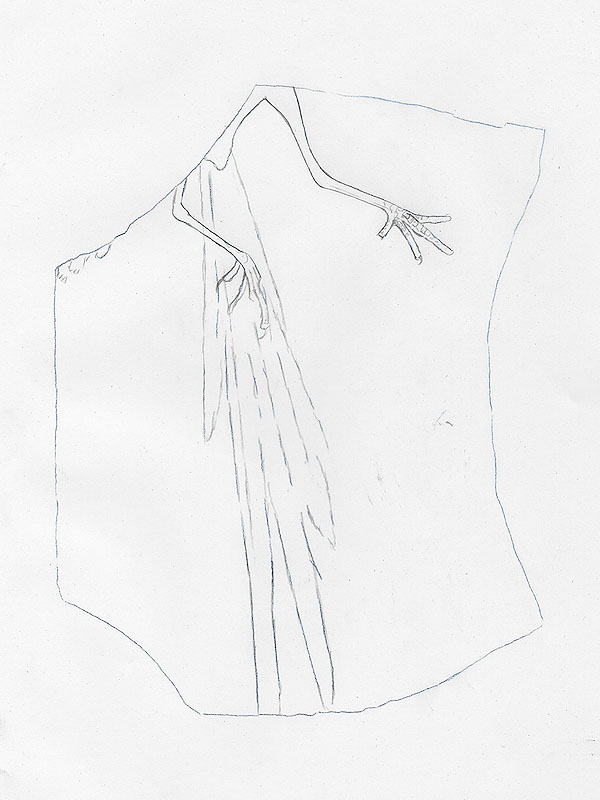

Das Fossil stammt aus dem mittleren Paläozän, ist also 60 bis 61 Millionen Jahre alt, und meiner Meinung nach könnte es sich tatsächlich um einen coliiformen Vogel handeln.
*********************
Hier ist ein kleiner skizzenhafter Versuch, diesen Vogel zu rekonstruieren, der, einschließlich seiner fast 20 cm langen Schwanzfedern, möglicherweise eine Gesamtlänge von ca. 34 cm erreicht haben dürfte, was sehr gut im Größenbereich moderner Mausvögel liegt!
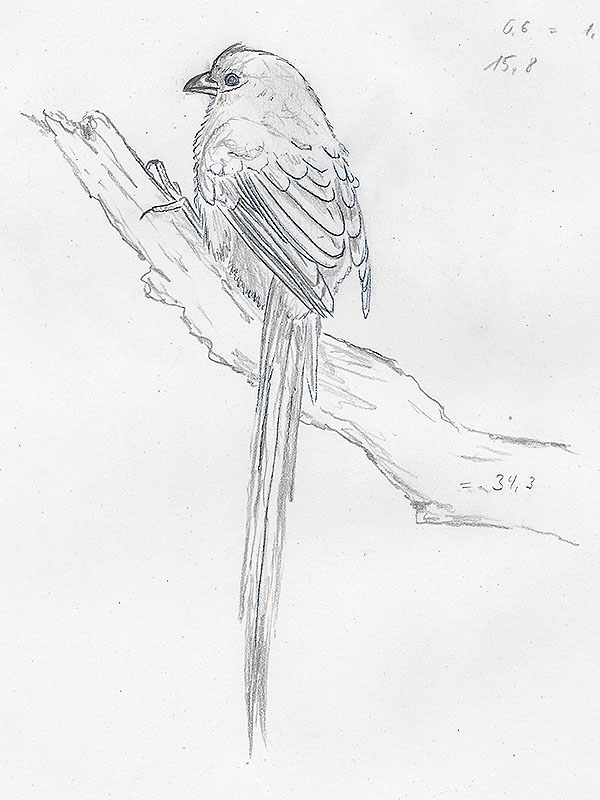
*********************
Quelle:
[1] Gerald Mayr; Sophie Hervet; Eric Buffetaut: On the diverse and widely ignored Paleocene avifauna of Menat (Puy-de-Dôme, France): new taxonomic records and unusual soft tissue preservation. Geological Magazine: 1-13. 2018
*********************
bearbeitet: 24.07.2019
Enantiophoenix electrophyla Cau & Arduini from the Late Cretaceous of Lebanon, roughly the size of a recent European Starling.
*********************

This species is known from parts of a foot and some very few further remains.
********************
References:
[1] Andrea Cau & Paolo Arduini: Enantiophoenix electrophyla gen. et sp. nov. (Aves, Enantiornithes) from the Upper Cretaceous (Cenomanian) of Lebanon and its phylogenetic relationships. ATTI della Società Italiana di Scienze Naturali e del Museo Civico di Storia Naturale di Milano 149(2): 293-324. 2008
*********************
edited: 14.07.2019
Elektorornis chenguangi Xing, O’Connor, Chiappe, McKellar, Carroll, Hu, Bai & Lei, a bird from the Cretaceous era described just now.
*********************
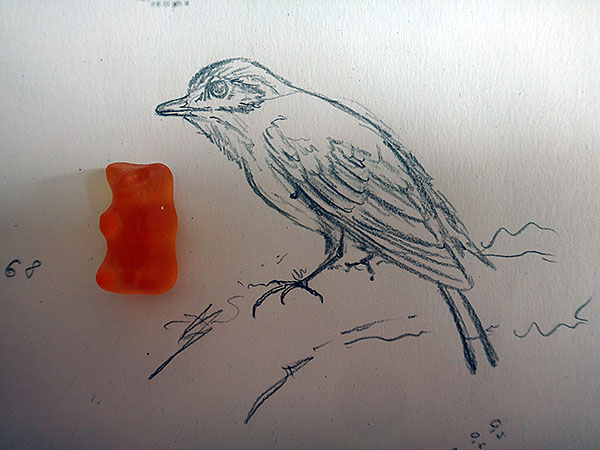
This bird is known only by a single leg with an unusually elongated middle toe and parts of the wing.
I will come back to that bird somewhat later ….
*********************
References:
[1] Lida Xing; Jingmai K. O’Connor; Luis M. Chiappe; Ryan C. McKellar; Nathan Carroll; Han Hu; Ming Bai; Fuming Lei: A new enantiornithine bird with unusual pedal proportions found in amber. Current Biology 29: 1-6. 2019
*********************
edited: 12.07.2019




*********************
bearbeitet: 29.06.2023
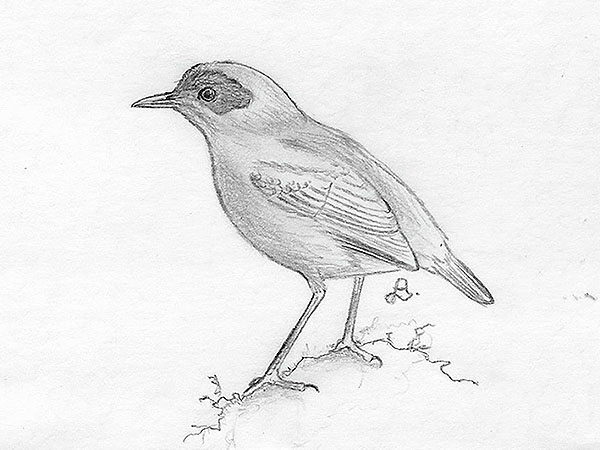
*********************
bearbeitet: 23.06.2019
Today, I doodled some birdies, Rarotonga Starlings.:
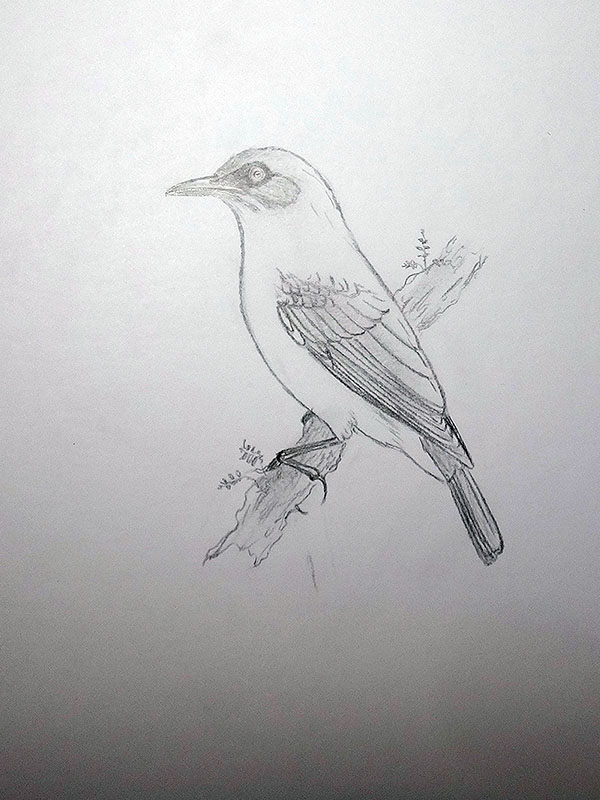
Personally, I like these freehand sketches better, at least the bird on the right, because it looks more lively and less static. :
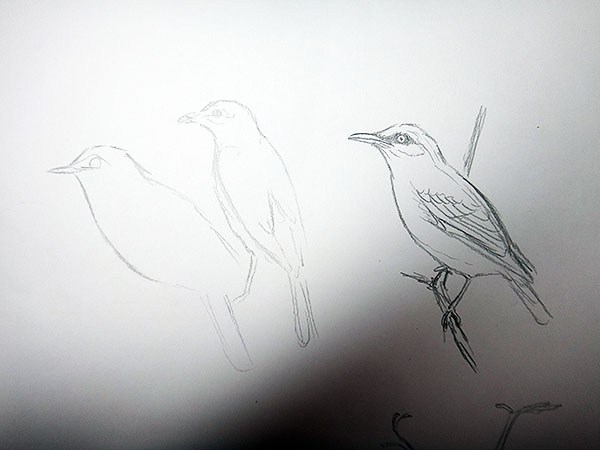
*********************
edited: 12.06.2019
We were in the little zoo in Gotha today where we go almost once a year, and for the first time I took my sketchbook with me, which, however, wasn’t a great idea since there were way too many people and I could not really take the time to sketch something beside that one.:
*********************
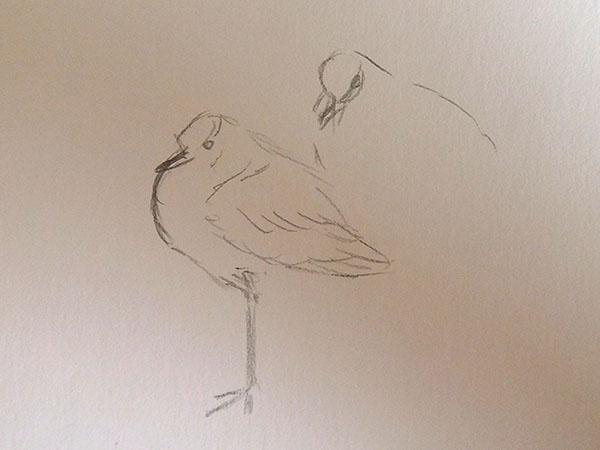
… it’s a Blacksmith Lapwing (Vanellus armatus)
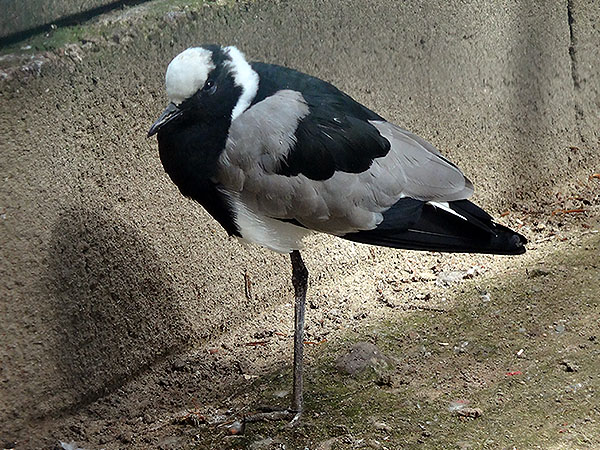
*********************
edited: 10.06.2019
Oh well, I did some research, and actually still do … here are the results I got so far.:
The first account dates from November 30th, 1895 and is given by a Dr. Georg Irmer, who was the Imperial German Government District Administrator in the Marshall Islands, which were a German overseas colony back then.
In his account he gives a bit information of some birds he saw when he inspected the Taongi Atoll (now Bokok) to collect guano samples for analysis and to reaffirm the German claim to the island, he mentions seabirds and a large ground-dwelling bird which he named a ‘Trappe‘, the German term for a bustard. He gives no further description or whatsoever, but it is thought that he might not have seen any of the birds commonly known from the Marshall Islands because neither he nor his Marshallese crew were able to identify that bird.
Given his name for the bird, ‘Trappe‘, it is quite likely that he indeed saw a rail of the genus Gallirallus, very much like the one that once inhabited the Wake Atoll to the north of the Marshall Islands. [4]
***
The second account comes from the natives of the Marshall Islands and was forwarded by them to the German ‘anthropologists’ who explored these islands at the beginning of the 20th century.
It is a bird named as the anang-, annan-, or annang. This is said to have been a very small bird (the size of a butterfly (!)), and to have possessed a pleasant smell, it is said to have lived among the rocks around the shores of the northern Marshall Islands. The bird is known from oral traditions at least from the Jaluit-, and the Wotho Atoll, and it is always said to have been a ground-dwelling singing bird.
This may in fact be a description of a Turnstone (Arenaria interpres (L.)), a species that winters in Micronesia and that was very much appreciated, for example by the inhabitants of Nauru, who cought them not to eat them but to tame them and keep them as pets.
Or it is the description of a small crake or a reed-warbler, mixed with some phantastic components. [4]
***
The third account comes from Paul Hambruch, a German ethnologist that researched the life of the natives of the island of Nauru, his accounts are merely stories that were told him by a native named Auuiyeda, and which he translated into German.
Let’s read them.:
“Es gibt auch Vögel auf Nauru, wie Fregattvogel, schwarze Seeschwalbe, weiße Seeschwalbe, Regenpfeifer, Brachvogel, Möve, Schnepfe, Uferläufer, Ralle, Lachmöve und Rohrdrossel.” [1]
translation:
“There are also birds on Nauru, as frigate bird, black tern, white tern, plover, curlew, gull, snipe, sandpiper, rail, black-headed gull and reed thrush.“
And he goes on.:
“Die Vogelwelt ist nach Zahl und Art reicher. Der Fregattvogel (Tachypetes aquila), itsi, die schwarze Seeschwalbe (Anous), doror, die weiße Seeschwalbe (Gygis), dagiagia, werden als Haustiere gehalten; der erste galt früher als heiliger Vogel, mit den beiden anderen werden Kampfspiele veranstaltet. Am Strande trifft man den Steinwälzer (Strepsilas interpres), dagiduba, den Regenpfeifer (Numenius), den Uferläufer (Tringoides), ibibito, die Schnepfe, ikirer, den Brachvogel ikiuoi, den Strandreiter iuji, die Ralle, earero bauo und zwei Möwenarten (Sterna), igogora und ederakui.
Im Busche beobachtet man an den Blüten der Kokospalme den kleinen Honigsauger raigide, die Rohrdrossel (Calamoherpe syrinx), itirir und den Fliegenschnäpper (Rhipidura), temarubi.” [1]
translation:
“The bird world is richer by number and species, The frigate bird (Tachypetes aquila), itsi, the black tern (Anous), doror, the white tern (Gygis), dagiagia, are kept as pets; the first one was formerly considered a holy bird, with the two others are used for fighting games. At the beach one mets with the turnstone (Strepsilas interpres), dagiduba, the plover (Numenius), the sandpiper (Tringoides), ibibito, the snipe, ikirer, the curlew, ikiuoi, the beach rider [?] iuji, the rail, earero bauo and two gull species (Sterna), igogora and ederakui.
In the bush one observes on the flowers of the coconut palm the small honeyeater raigide, the reed thrush (Calamoherpe syrinx), itirir and the flycatcher (Rhipidura), temarubi.“
The author is usually thought to have misinterpreted the things he was told by Auuiyeda, but I personally doubt that somehow, all the mentioned landbirds make in fact sence for georaphical reasons, so, why not?
Nauru is now almost deserted, the whole island looks like a building site – and it actually is one! There are some sad rests of the forest that once covered the whole island, and indeed some landbirds still manage to survive in small numbers, one of them, the Nauru Reed-Warbler (Acrocephalus rehsei (Finsch)) is even an endemic species, there’s no reason not to accept the former presense of a fantail, a honeyeater, and especially a rail, no reason at all!
These birds, especially the rail, may already have been extirpated by the beginning of the 20th century, leaving only memories and storys told by the islanders.
***
And last but not least, here the fourth account of birds from the Namoluk Atoll, Chuuk, that were enumerated by Max Girschner, another German who had lived in Micronesia at the beginning of the 20th century, he was a colonial offical, a doctor, and an ethnologist.
I have no access to his accounts, but I can give you quotations of them by Mac Marshall from 1971, here they are.:
“Ponape Lory (no Namoluk name)
Trichoglossus rubiginosus
Extinct breeder.
According to Girschner (1912:126), this species was blown to Namoluk in a typhoon in 1905, and apparently it still occurred on the atoll at the time of his visit. there are no lories at present on Namoluk nor can anyone alive on the atoll in 1971 remember seeing them.” [2]
According to Donald W. Buden this whole information is unlikely, and if these parrots have ever occurred on the Namoluk Atoll at all, they must have been brought there by people. [3]
I personally think … why not, typhoons may indeed blow parrots from one island to another, or how did the loris themselves came to end up on the island of Pohnpei in the first place?
But wait, there’s more.:
“A second bird mentioned by Girschner that no longer is found on Namoluk is “a small black and white bird” for which he gives the name lipukepuk.” [2]
The author states that this can only be the description of a New Hanover Mannikin (Lonchura (hunsteini ssp.) nigerrima (Rothschild & E. J. O. Hartert)), which does not occur anywhere in Micronesia and which is not black and white by the way. The bird he is actually referring to is Hunstein’s Mannikin (Lonchura hunsteini ssp. minor (Yamashina)), which again is very well occuring in Micronesia, at least on the island of Pohnpei (yes, again), and which is at least blackish and greyish ….
To me the whole account sounds very much like a nice description of the Truk Monarch (Monarcha rugensis (Hombron & Jacquinot)), and given the fact that most island-dwelling birds in Micronesia also occur on nearby atolls it is quite possible that there once was a native population of this bird here as well.
But we will probably never know for sure.
***
The most interesting things that I found out so far are.:
1: Micronesian bird names are odd (to my ears and eyes), I mean the Palau Ground Dove (Pampusana canifrons (Hartlaub & Finsch)) for example is named omekrengukl, I do not even know how to pronounce that. 🙂
2: Micronesia harbors only 148 native breeding bird species (including the extinct ones!).
3: The Micronesian landbirds do not only occur on the higher islands but also on the atolls, even on those atolls that are quite far away from the next high islands, a situation that is completely different from Polynesia, where the high islands almost entirely harbor a different avifauna than the atolls.
There may have been more species once, especially when we fill some of the illogical gaps between the islands and island groups.
*********************
References:
[1] Paul Hambruch: Nauru. Ergebnisse der Südsee-Expedition 1908-1910. II. Ethnographie: B. Mikronesien, Band 1.1 Halbband. Hamburg, Friedrichsen 1914
[2] Mac Marshall: The natural history of namoluk Atoll, eastern Caroline Islands. Atoll Research Bulletin 189: 1-53. 1975
[3] Donald W. Buden: The birds of Satawan Atoll and the Mortlock Islands, Chuuk, including the first record of Tree Martin Hirundo nigricans in Micronesia. Bulletin on the British Ornithologists’ Club 126(2): 137-152. 2006
[4] Dirk H. R. Spennemann: Extinctions and extirpations in Marshall Islands avifauna since European contact – a review of historic evidence. Micronesia 38(2): 253-266. 2006
*********************
edited: 04.01.2024
The genus Pareudiastes consists of two species that both are known from historical times, meaning ‘having been seen’ by western scientists. We can probably add at least two undescribed extinct forms that are known exclusively from scanty subfossil remains, one from Fiji and one from the Solomon Islands.
The two species of which at least skins remain are very little known, the puna’e (Pareudiastes pacificus Kubary, Hartlaub & Finsch) from Samoa is in fact the best known of them.
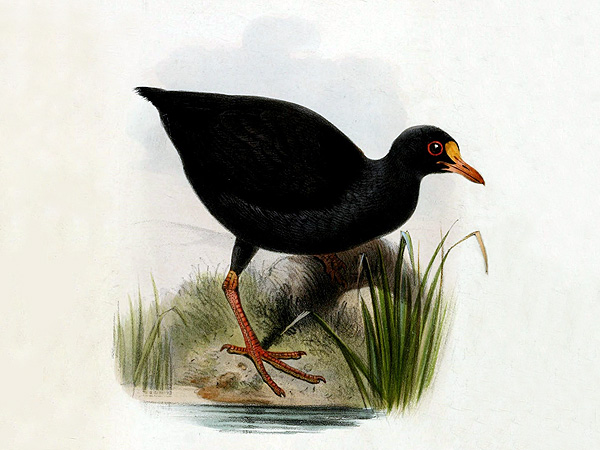
***
The puna’e, whose name roughly translates as “springs up“, is known to have inhabited the rainforests of Savai’i, Samoa; it is said by the natives to have lived in burrows, which were longer than a man’s arm and which ended in a sort of chamber in which the bird slept during the day.
The large eyes of the species indeed point to a somewhat nocturnal habit.
When the bird was disturbed it jumped up from its burrow with fluttering wings but being flightless it landed shortly after and run away quickly.
It is furthermore known that it was not a vegetarian species, since it died when it was fed with plant material but was “happy” when fed with insects.
***
There is at least one reliable account that indicates that this species also inhabited the neighboring island of ‘Upolu.:
“The Samoans always speak of the Pareudiastes as the ‘bird which burrows like a rat.’ Again and again when I have put the question to a native, ‘Do you know the Puna’ e?’ the reply has been, ‘No, I have never seen it; but that is the bird of which the old people speak that it used to be very plentiful long ago, and that it burrows like a rat and lives underground.’ It is very rarely that I have met with any one who has seen the bird; but I have met with two persons who have actually taken it in its burrow. The first is a man well known to me, and in whose veracity I have faith. He says that about four years ago [ca. 1870] he was one of a large party hunting feral pigs in the mountains of Upolu, when they came upon a burrow which one of the party pronounced to be the hole of a Puna’e. My informant says that he put his arm into the hole, and at its extremity (which he could barely reach) he found the bird. He drew it out, and, taking it home, tried to tame and feed it; but it would not eat, and soon died.” [1]
Yet, how is this possible? The islands of Savai’i and ‘Upolu are separated by the 13 km wide Apolima strait.

***
During the Pleistocene, the sea level was lower and Manono very likely was connected with ‘Upolu, but Apolima was not, and Savai’i and ‘Upolu also weren’t connected.
So, how did a flightless bird manage to get from one island to the other?
The answer might be that the Puna’e wasn’t flightless at the time when the sea level was lower, or that the birds from ‘Upolu represented a distinct (sub)species.
***
What do we know about the second historical known species, the Makira Woodhen (Pareudiastes silvestris (Mayr))?
This species is known from a single specimen that was taken in 1929 on the island of Makira, Solomon Islands in montane forest at an elevation of about 600 m, only its skin was preserved, the bones not, and it apparently was flightless or at least nearly so.
The natives called it kia and hunted it with dogs.
That’s all.
The species was apparently still ‘well-known’ by the natives in 1953, and they also said that it was not rare, nevertheless not a single one was ever seen since (by western scientists).
The Makira Woodhen, or Kia, however, is the sole member of this genus that may in fact still survive, and I personally hope that it might be rediscovered someday.
***
The two additional forms are, as I’ve said before, known only from some scanty subfossil remains found on the island of Buka in the northernmost part of the Solomon Islands as well as on Viti Levu, the largest of the Fijian Islands respectively.
***
The genus Pareudistaes should be merged with the genus Gallinula, by the way.
*********************
References:
[1] Letter from Rev. S. J. Whitmee. In: Proceedings of the Zoological Society of London 1874: 183-186
*********************
edited: 04.07.2023

*********************
bearbeitet: 28.05.2019